|
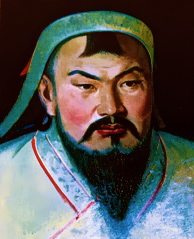 |
 |
|
The Mighty Manslayer, the Scourge of
God, the Perfect Warrior and the Master of Thrones and Crowns, are some
of his many names. Historically today, he is most often remembered as
Genghis Khan.
Even the 'name' Genghis Khan is yet another title, originally,
Genghis Kha Khan, meaning the Greatest of Rulers or the Emperor of All
Men. It was bestowed in 1206 by a soothsayer, at the Kurultai, the
Council of the Khans, held to select a single man to rule all the
peoples of high Asia. The other name titles came later, after millions
had died in his wars of conquest. "God in
Heaven. The Kha Khan, the Power of God, on Earth. The seal of the
Emperor of Mankind."
The Seal of Genghis Khan
The story of Genghis Khan begins in the Gobi Desert, A.D. 1162, the Year
of the Swine in the calendar of the twelve beasts. |
|
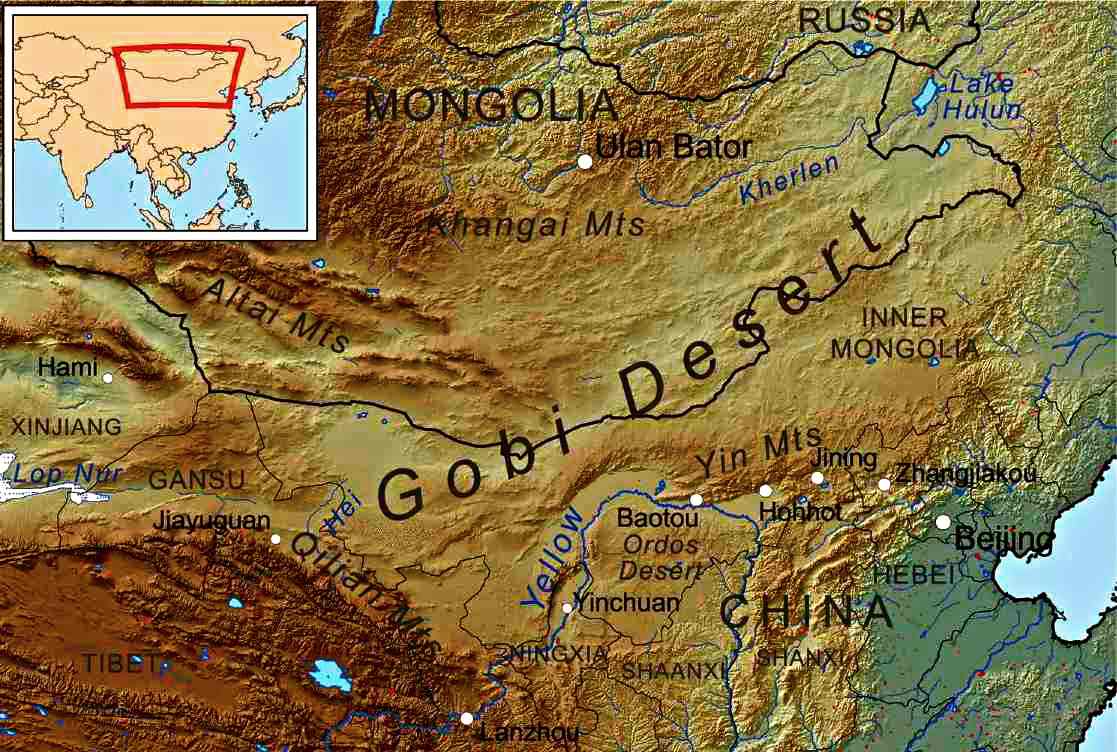 |
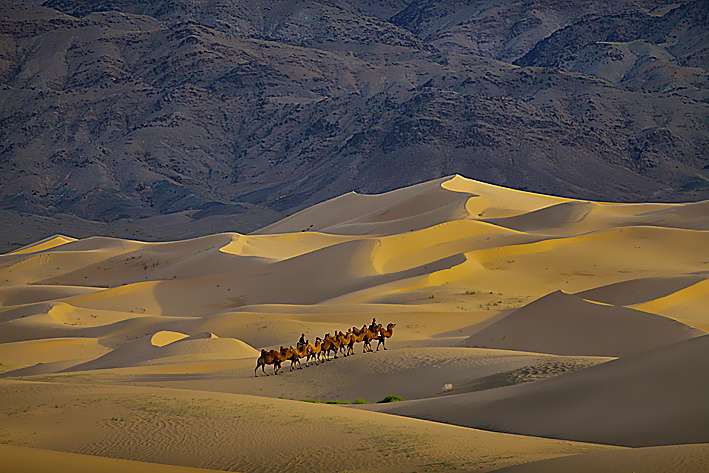 |
| Genghis Khan's birth name was Temujin. At the time of his birth, his
father, Yesukai, was absent on a raid against a tribal enemy called
"Temujin" by name. The affair went well, the enemy was made a prisoner,
and the father, returning, gave to his infant son the name of the
defeated foeman. Temuchin signifies "The Finest Steel", Tumur-ji. The
Chinese version is T'ie mou jen, which has another meaning all together,
"Supreme Earth Man". Temujin was the first born of Yesukai
the Valiant, Khan of the Yakka Mongols, master of 40,000 tents. His
father's sworn brother was Toghrul Khan of the Karaits, the most
powerful of the Gobi nomads, he who gave birth in Europe to the tales of
Prester John of Asia. The Gobi Desert, lofty plateaus, wind-swept,
lying close to the clouds. Reed bordered lakes, visited by migratory
birds on their trek to the northern tundras. Huge Lake Baikul, visited
by all the demons of the upper air. In the clear nights of mid-winter,
the curtain of the Northern Lights Aurora Borealis rising and falling
above the horizon.
The Gobi Desert, as described by Friar Carpini, the first European to
enter this desolate land, circa mid 12th century. "In the middle of
summer there are terrible storms of thunder and lightning by which many
people are killed, and even then there are great falls of snow and such
tempests of cold winds blow that sometimes people can hardly sit on
horseback. A man cannot see through the prodigious dust storms. There
are often showers of hail, and sudden, intolerable heats followed by
extreme cold".
The children of the northern Gobi steppes were not hardened to
suffering, they were born to it. After they were weaned from their
mother's milk to mare's milk they were expected to manage for
themselves! The places nearest the fire in the family tent belonged to
the grown warriors and to guests. Women, it is true, could sit on the
left side, but at a distance, and the boys and girls had to fit in where
they could. Everything went into the pot and was eaten. The able-bodied
men taking the first portions, and the aged and the women received the
pot next, finally the children had to fight for bones and sinewy bits.
Very little was left for the dogs.
The end of winter was the worst of all for the Mongol children. No more
cattle could be killed off without thinning the herd too much. At such a
time the warriors of the tribe were raiding the food reserves of another
tribe, carrying off cattle and horses. The children learned to organize
hunts of their own, stalking dogs and rats with clubs or blunt arrows.
They learned to ride, too, on sheep, clinging to the wool.
The boys must fish the streams they passed in their trek from the
summer to winter pastures. The horse herds were in their charge, and
they had to ride far afield after lost animals, and to search for new
pasture lands. They watched the skyline for raiders, and spent many a
night in the snow without fires. Of necessity, they learned to keep the
saddle for several days at a time, and to go without cooked food for
three or four days, and sometimes without any food at all. |
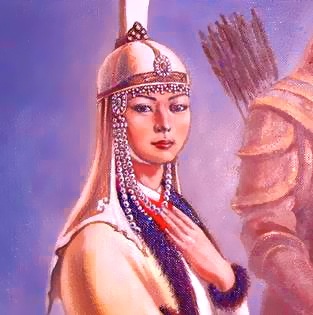
Houlun - Mother of Genghis Khan |
For diversion they had horse races, twenty miles out into the
prairie and back, or wrestling matches in which bones were freely
broken. Mercy seemed to these nomad youths to be of little value, but
retribution was an obligation among the Mongol tribes.
Temujin's mother, Houlun, was beautiful, and so had been carried
off by his father from a neighboring tribe, on her wedding ride to the
tent of her betrothed husband. Houlun, made the best of circumstances
after some wailing, but all the yurt knew that some day men from her
tribe would come to avenge the wrong.
Temujin received word his father had been poisoned by enemies. Many of
his tribe then abandoned the standard of their chieftain and started off
to find other protectors, rather than trust themselves, their families
and herds to an inexperienced boy. "The deep water is gone," they said,
"the strong stone is broken. What have we to do with a woman and her
children?"
Temujin was now seated on the white horse-skin, Khan of the Yakka
Mongols, but had only a remnant of the tribe. He faced the certainty
that all the feudal foes of the Mongols would take advantage of his
fathers death to avenge themselves upon the son.
Then the inevitable, a certain warrior, Targoutai, announced that he
was now over-lord of the northern Gobi. Targoutai, chieftain of the
Taidjuts, the fuedal foes of the Mongols. |
| As an older wolf seeks and slays a cub too prone to take the
leadership of the pack, the hunt was launched without warning. Temujin
and his brothers fled before the onset of the horsemen. Thus the hunt
began with the Taidjuts close upon the heels of the boys. The chase
lasted for many days through gorges and timber growths and upon the
sides of mountains, and even into caves. Finally, Temujin was captured
alone, the brothers having separated days earlier. Targoutai commanded
that a 'kang' be placed upon him. A wooden yoke resting on the shoulders
and holding the wrists of the captive bound at each end. Later, left
alone with a single guard he knocked the man senseless with the kang and
escaped. Hearing the sound of pursuit he hid in a river with only his
head above water. Temujin observed one warrior spot him but say nothing
to the others. Following his trackers back to their camp he stealthily
entered the tent of the warrior, a guest of his pursuers, and he
assisted Temujin in escaping from the kang, and out of the camp to
safety. "The smoke of my house would have vanished, and my fire would
have died out forever had they found thee," the man remarked grimly to
the fugitive, giving to him at the same time food and milk, and a bow
with two arrows. "Go now to thy brothers and mother." |
| Temujin, riding a borrowed horse, tracked down his family. They were
in hiding and hungry; the stern mother Houlun, his brave brother Kassar,
and Belgutai the half bother who idolized him. They lived after a
fashion, traveling by night, trapping game, and Temujin learned how to
keep out of an ambush, and to break through the lines of men who hunted
him down. Hunted he was and his cunning grew with each passing year. He
was never in his lifetime captured a second time! Cunning kept Temujin
alive, and a growing wisdom kept the nucleus of a clan about him.
Physical prowess he had, and watchfulness. The chieftains who raided
into the fertile region between the Kerulon and Onon could drive him
from the hills into the lower plain, but could not bring him to bay.
"Temujin and his brothers," it was said, "are growing in strength."
Amidst the ceaseless, merciless warfare of the
nomad lands, Temujin
sought to master his heritage. At this time, when he was seventeen, he
went to look for his betrothed, Bourtai, to carry off his first wife.
|
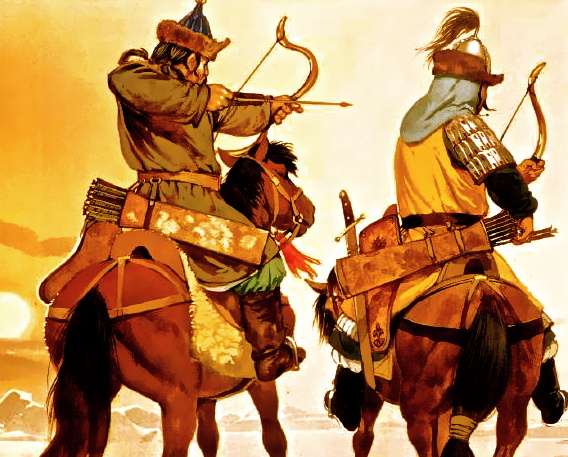 |
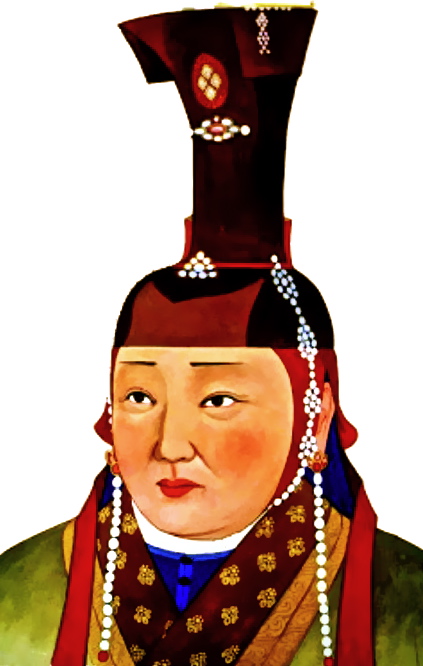
Bourtai - Wife of Genghis Khan |
Bourtai was thirteen years old when Temujin arrived to claim her,
accompanied by 200 Mongol horsemen. Bourtai was singled out for a
destiny above that of other women. History knows her as Bourtai Fidjen,
the Empress, mother of three sons who ruled in a later day a dominion
greater than Rome's. But she was not long with her new husband before a
tragedy occurred.
Unexpectedly, a formidable clan rode down from the northern plain and
raided the Mongol camp. These were the Merkits. They were true
barbarians descended from the aboriginal stock of the Tundra, people
from the "frozen white world", where men traveled in sledges pulled by
dogs or reindeer. These were the clansmen of the warrior from whom
Temujin's mother, Houlun, had been stolen by his father some eighteen
years ago. Most probably they had not forgotten their old grievance.
They came at night, casting blazing torches into the Ordu (tent) of the
young khan. The Khan's new wife, Bourtai, was carried off by the
raiders.
Temujin, still lacking sufficient followers to retaliate, approached his
foster father Toghrul Khan, and besought the aid of the Karaits. Mongol
and Karait descended upon the raiders village during a moonlight night.
Temujin called Bourtai's name and she came to him in the confusion of
the attack.
He could never be certain if Bourtai's first born were his son, but his
devotion to her was unmistakable. He named his eldest son Juchi, the
"Guest", born under a shadow, but Temujin made no distinction among his
sons by her. They would come to inherit an empire lager than any other
ever to exist on Earth.
When the Mongols had grown to thirteen thousand horsemen, Temujin
fought his first pitched battle, against thirty thousand Tiajuts led by
Targoutai. There ensued one of the terrible steppe struggles - mounted
hordes, screaming with rage, closing in under arrow flights, wielding
short sabers, pulling their foes from the saddle with thrown lariats and
hooks attached to the ends of lances. |
| Each squadron fought as a separate command, and the fighting ranged
up and down the valley as the warriors scattered under a charge,
reformed and came on again. It lasted until daylight left the sky.
Temujin had won a decisive victory.
Temujin was accustomed to go to the summit of a bare mountain which
he believed to be the abiding place of the Tengri, the spirits of the
upper air that loosed the whirlwinds and thunder and all the
awe-inspiring phenomena of the boundless Sky. He prayed to the quarters
of the four winds, "Illimitable Heaven, do Thou favor me, send the
spirits of the upper air to befriend me, but on Earth send men to aid
me."
And men of courage and strength flocked to the standard of the "Nine
Yaks Tails" in ever increasing numbers. These paladins of the Khan were
known throughout the Gobi as the Kiyat, or "Raging Torrents". Two of
them, mere boys at the time, carried devastation over ninety degrees of
latitude in a later day. They were Chepe' Noyon, the Arrow Prince, and
Subotai Bahadur, the Valient, of the Uriankhi, the reindeer people. |
|
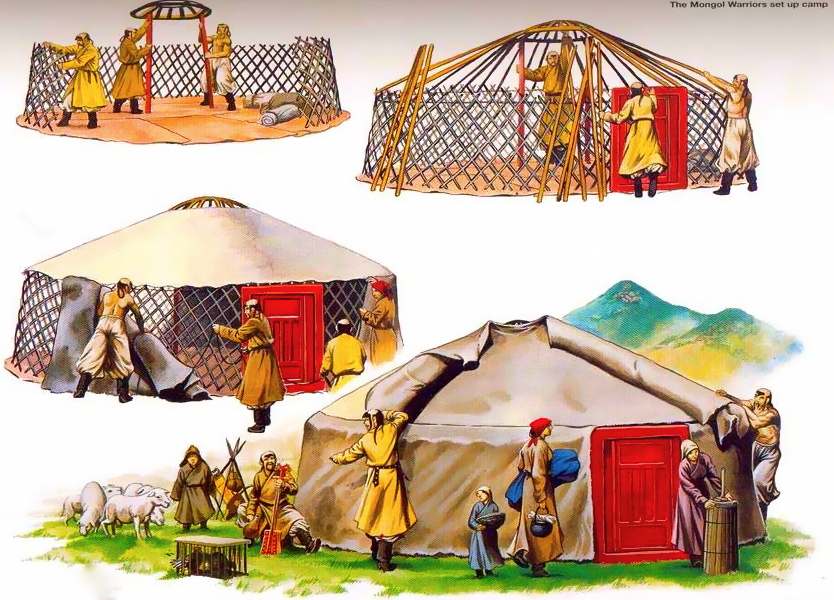 |
|
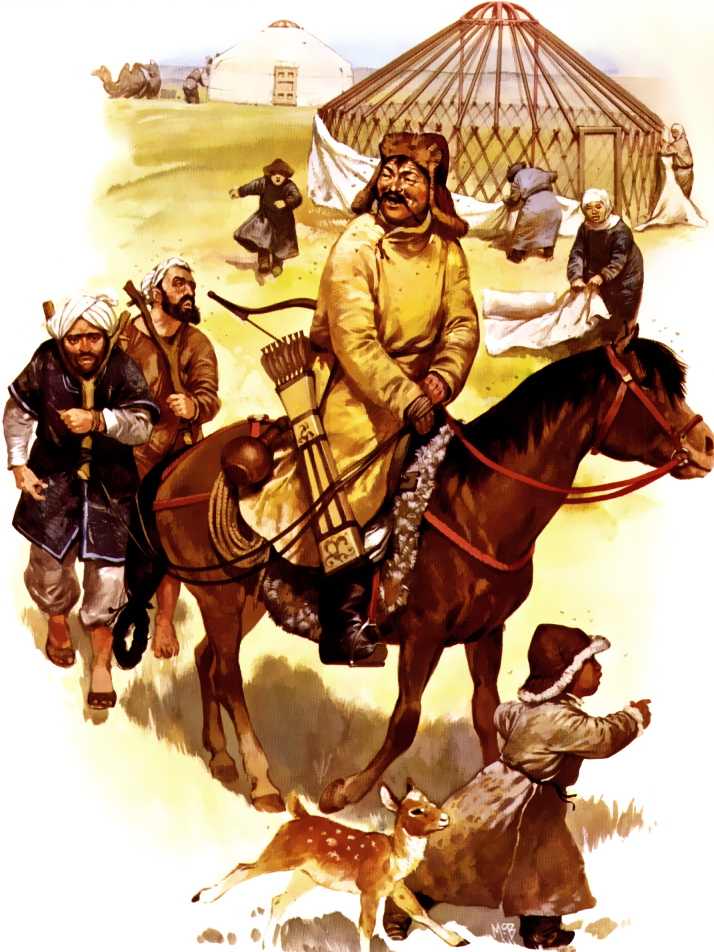 |
| There was no end to the tribal warfare of the Gobi, the wolf-like
struggle of the great clans, the harrying and the hunting down. The
Mongols were still one of the weaker peoples, though a hundred thousand
tents now followed the standard of the Khan. His cunning protected them,
his fierce courage emboldened his warriors. Temujin was more than thirty
years of age, in the fullness of his strength, and his sons now rode
with him. |
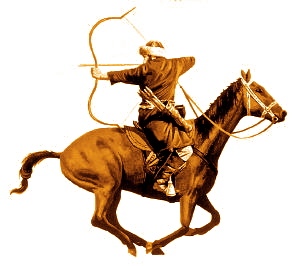 |
"Our elders have always told us," he said one day before the council,
"that different hearts and minds cannot be in one body. But this I
intend to bring about. I shall extend my authority over my neighbors."
To mold the venomous fighters into one confederacy of clans, to make his
feudal enemies his subjects, was his plan.
But then the twelfth century was drawing to a close, and Temujin in
his infinite patience was still laboring at what his elders said could
not be accomplished, a confederacy of the clans. He now realized it
could only come in one way, by the supremacy of one clan over the
others.
So Temujin approached
Prestor John, known as Toghrul Khan of the Keraits,
which were formed mostly of Nestorian Christians, who controlled the
cities on the caravan routes from the northern gates of Khitai (China)
to the distant west, and he formed a blood alliance between Mongol and
Kerait.
In his compact Temujin remained faithful to his new father. When the
Keraits were driven |
| out of their lands and cities by the western tribes, which were
mostly Moslems and Buddhists who cherished a warm religious hatred of
the Christian Shamanistic Karaits, Temujin sent his Mongol "Raging
Torrents" to aid the discomfited chieftain,
Prestor John. Behind
the Great Wall the "Golden Emperor" of Cathay (China) stirred in his
sleep and remembered incursions of the Buyar Lake Tatars that had
annoyed his frontiers. He announced that he himself would lead a grand
expedition beyond the wall to punish the offending tribesmen, an
announcement that filled his subjects with alarm! Eventually, a high
officer was dispatched with a Cathayan army against the Tatars, who
retired as usual unscathed and unchastened. The host of Cathay, being
composed largely of foot soldiers, could not come up upon the nomad
cavalry. Tidings of this reached Temujin, who acted as swiftly as hard
whipped ponies could carry his messages across the plains. He rallied
all his clansmen and sent to Prester John, reminding his elder ally that
the Tatars were the clan that had slain his father. The Keraits answered
his call, and the combined hordes rode down upon the Tatars who could
not retreat, because the Cathayans were in their rear.
The battle broke the Tatars power. The Cathayan general rewarded Prester
John with the title of Wang Khan, or "Lord of Kings". He awarded the
honor, "Commander Against Rebels", upon Temujin. The expeditionary force
and it's general then returned to Cathay, where he laid claim to all
credit for himself.
The Karaits offered a bride for Temujin's first born son, Juichi. A
young woman |
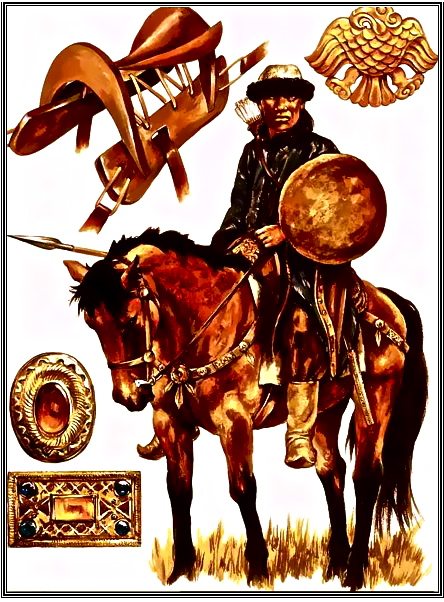 |
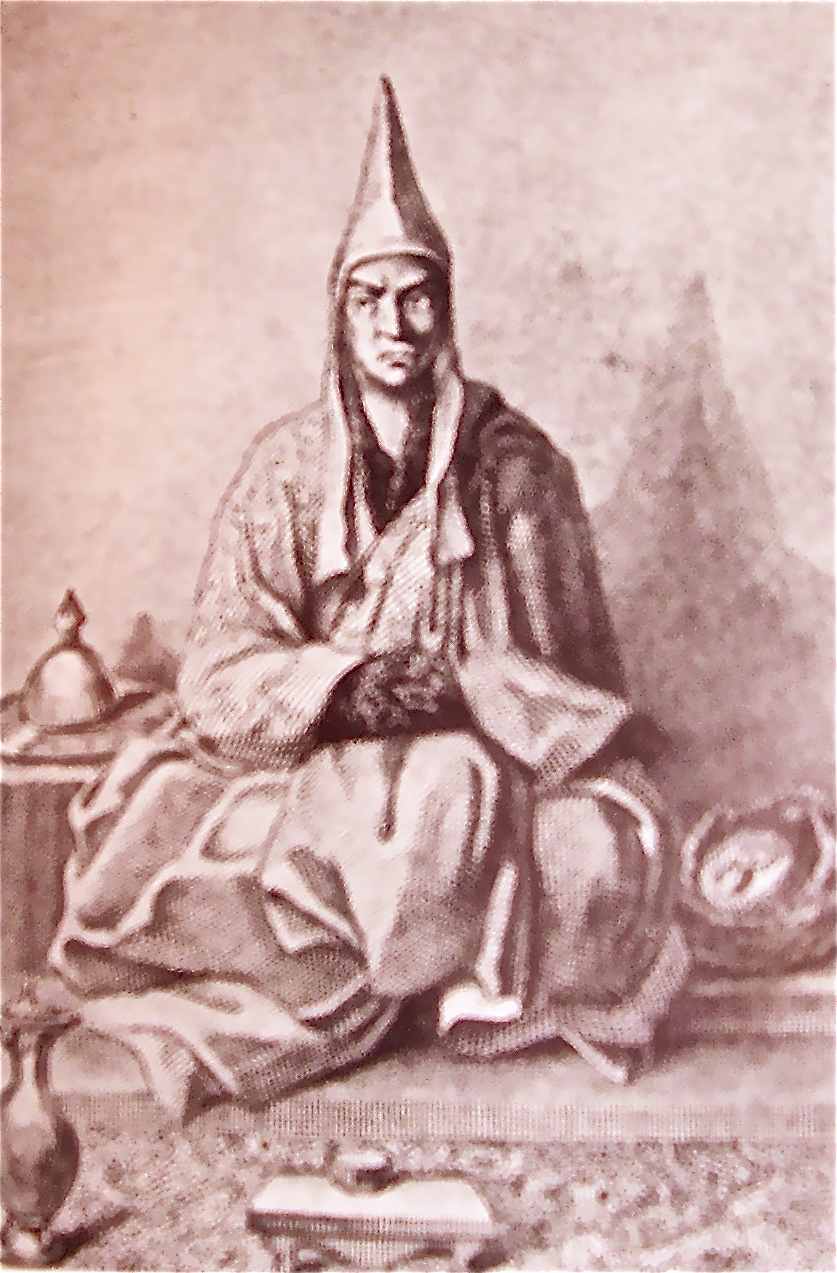
Tentengri, Mongol Wizard |
from among the girls of the chieftain's family. But Temujin remained in
his camp, keeping his distance warily from the Kerait ordus (tents),
while his men went before him to see if the way were safe. News came,
unwelcome and ominous. His enemies in the west; Chamuka the Cunning,
Toukta Beg, the chieftain of the dour Merkits, also the son of Wang
Khan, and Temujin's uncles, had determined to put an end to him. They
had persuaded the aging and hesitant Prester John, now Wang Khan, to
throw his strength in with theirs. The marriage overtures had been a
ruse.
With a small contingent of 6000 horsemen, merely an honor guard for the
marriage overtures, Temujin was heavily outnumbered, as he observed the
approach of his enemies. He saw the clans were scattered, the best
horses forging ahead of the slower paced. He led out his cavalry in
close array from their concealment, their horses rested, unlike those of
his former allies, which were hard pressed for speed. His initial charge
scattered the vanguard of the Keraits, and his horsemen formed their
lines across the rolling grassland, covering the retreat of his Ordu's
woman and children. Then Wang Khan and his chieftains came up, the Keraits realigned, and the merciless battle of extermination began on
the high steppes of Asia!
Never in his desperate life had Temujin been harder pressed. He had dire
need then of all the personal valor of his "Raging Torrents", and the
steadfastness of his household clans, the heavily armed riders of of the
Urut and Manhut clans that had always served him faithfully. His numbers
did not allow him to make a frontal attack, and so he was reduced to
holding what little advantage his ground position gave him, which for
Mongols was a last resort.
With his clans scattered and the Keraits and Merkits breaking through
his lines, and darkness coming on, Temujin ordered the tulughma, the
"standard sweep" that turns an enemy's flank and takes him in the rear.
It held the opposing cavalry in restraint, |
especially as the son of Wang Khan had been wounded in the face by
an arrow. When the sun set, the forces of Wang Khan withdrew a little
from the field, not the Mongols. Temujin waited only to cover
withdrawal, so as to gather up his wounded warriors, two of his sons
among them, many on captured horses and sometimes with two men on a
single animal. Then he fled to the east and the Keraits took up the
pursuit the next morning.
"We have fought," said Wang Khan, "a man with whom we should never have
quarreled." |
Temujin sent couriers and called a council of the khans. Each spoke
in turn. The bolder chieftains called for battle against the forces of
Wang Khan. They called for leadership from Temujin. This council
prevailed. Temujin accepted the command position and declared that his
orders must be obeyed in all clans, and his punishment immediate against
those he chose.
"From the beginning I have said to you that the lands between the three
rivers must have a master. You would not understand. Now, when you fear
Wang Khan will treat you as he has treated me, you have chosen me for
your leader. To you I have given captives, women, yurts and herds. Now I
shall keep for you the lands and customs of our ancestors."
During that cold dark winter the Gobi Desert divided into two rival
camps, and this time Temujin was first afield, before snow left the valleys.
With his new allies he advanced without warning upon the camp of Wang
Khan. By nightfall the Keraits were broken and scattered,
Prester John (Wang Khan) and his son both wounded and fleeing. |
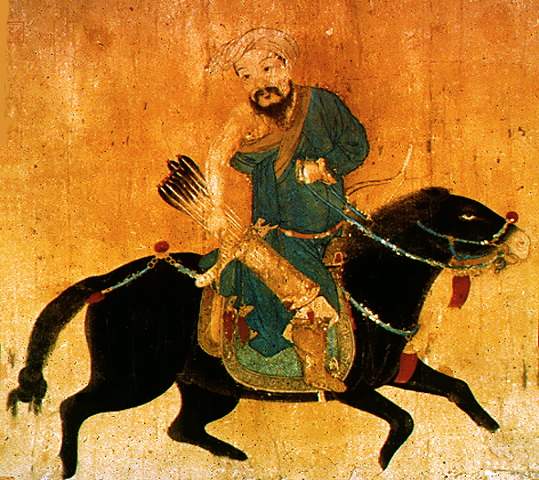 |
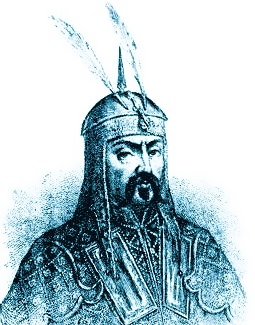 |
Temujin gave to his men the wealth of the Keraits. The tent of Wang
Khan, hung with cloth of gold, he gave entirely to the two herders who
had warned him of the Kerait advance upon him, that first night at
Gupta.
Following up on the retreating Keraits, he surrounded them with his
cavalry and offered them their lives if they would yield, "Men fighting
as you have done to save your lord, are heroes. Be you among mine, and
serve me." The remnants of the Keraits joined his standard, and Temujin
pushed onward to their city in the desert, Karakorum, the Black Sands.
Prester John, once Wang Khan, who had entered into this war unwillingly,
fled hopelessly beyond his lands and was put to death by warriors of a
Turkish tribe. His skull was set in silver and remained in the tent of a
chieftain, as an object of veneration. His son was killed in much the
same manner.
"The merit of an action," Temujin told his sons, "is in finishing it to
the end."In the three years following the battle that gave Temujin
mastery of the Gobi steppes, he thrust his veteran horsemen far into the
valleys of the western Turks, from the long white mountains |
of the north, down the length of the Great Wall, through the ancient
cities of Bishbalik and Khoten his officers galloped, and Temujin
consolidated power.
For the moment clan feuds were forgotten, as they were in awe of the
Mongol Khan. Buddhist and shaman, devil-worshpper and muslim, and
Nestorian Christian, sat down as brothers, awaiting events. And Temujin
called his Kurultai, to select a single man to rule high Asia. And that
night his name changed to Genghis Khan.
"When he conquered
a province he did no harm to the people or their
property, but merely established some of his own men in the country
among them, while he led the remainder to the conquest of other
provinces. And when those he had conquered became aware how well and
safely he protected them against all others, and how they suffered no
ill at his hands, and saw what a noble prince he was, then they joined
him heart and soul and became his devoted followers. And when he had
thus gathered such a multitude that they seemed to cover the earth, he
began to think of conquering a great part of the world.", Marco Polo
wrote concerning Temujin. |
|
 |
|
 |
| Genghis Khan chose his headquarters, to which he always returned, at
Karakorum, the Black Sands, formerly the capital of the Kerait Khanate
under Wang Khan (Prester John). A wind-swept place of bitter sand storms,
Karakorum became a metropolis in a barren wasteland. Vast stables housed
the Khan's chosen herds of the finest horses. Granaries guarded against
famine. Caravanserais sheltered travelers and visiting ambassadors who
flocked to the Khan. There was a district to house the ambassadors and a
quarter for the religions. Buddhist Temples, stone Mosques, and small
wooden churches of Nestorian Christians, all stood next to one another.
Everyone was free to worship as they pleased.
Visitors were met by Mongol officers at the frontiers and
forwarded to Karakorum with guides, and word of their coming was sent
ahead by rapid couriers of the caravan routes. Once within sight on the
treeless and hill-less plain that surrounded the city of the Khan, the
travelers were taken in charge by the "Master of Law and Punishment".
When the Khan signified, they were led into his presence.
Genghis Khan's court was in a high pavilion of white felt, lined with
silk. By the entrance stood a silver table, set with mares milk, fruit
and meat, so that all who came to him could eat as much as they pleased.
In the center of the pavilion a fire of thorns and dung glowed. On a
dais at the far end sat the Great Khan. Ministers, scribes and Mongol
officers were about him in attendance. Utter silence would prevail when
the Khan spoke. When he said anything, that subject was closed. No man
might add a word to his. Words were few, and painstakingly exact. After
a person had presented themselves at the Khan's Ordu, they must not
depart until told to do so by the Khan.
With all merchants Genghis Khan established a method for dealing with
them. The Khan did not haggle. If the merchant tried to bargain with him
his goods were taken without payment. If, on the other hand, they gave
everything to the Khan, they received in return gifts that more than
paid them. To open up new roads between east and
west, and remain in continuous communication with all parts of his
empire, the Khan devised the yam or Mongol horse-post, the equivalent of
the pony express of thirteenth century Asia. These messengers were
accustomed to ride fifty or sixty miles a day. Past the yam stations
plodded the endless lines of camels and caravans. The yam was telegraph,
railroad and parcel-post, all in one. The Mongols were masters of the
roads. In the large towns there would be a daroga, or road governor,
with an absolute authority in his district. In this way the Khan could
receive dispatches from places ten days journey off in one day and
night. The post roads were the backbone of the Khan's administration.
|
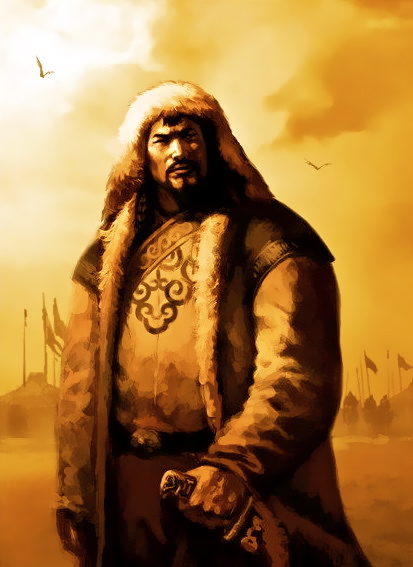 |
 |
| For the first time in history the nomads were united into a
permanent military force as organized as the Roman Legions, which was
entirely because of Genghis Khan's efforts. The horde consisted of the
wise and mysterious Ugurs, the stalwart Keraits, the hardy Yakka
Mongols, the ferocious Tatars, the dour Merkits, silent men from the
snow Tundras, and all the riders of high Asia. There was nothing
haphazard about the Mongol Horde. It was composed of units of ten. It
was expressly forbidden for any warrior of the horde to forsake his
comrades, the men of his "ten". Or for the others of the ten to leave
behind a wounded man.
Ten of these formed the 'hundred'. Ten of the hundred formed the
'thousand'. Ten of the thousand formed a 'Tuman', a Mongol cavalry
division of 10,000. There were eleven divisions in all. Only 110,000
horsemen were the initial size of a highly mobile army that would
conquer most of the known civilized world. In command of each division
were the Orkhons, the Marshals of the Great Khan, drawn from the ranks
of the veteran "Raging Torrents". Genghis Khan had command of a new
force in warfare, a highly disciplined mass of heavy cavalry capable of
swift movement across all kinds of terrain. There had been cavalry
before, but not with the unique skills and tactics of the Mongols.
The Mongol cavalry remained invisible until the hour of battle and
then maneuvered in terrible silence, obedient to signals given by moving
the standards of the horde, signals repeated to the warriors of a
squadron by the arm movements of an officer. This, during the day and in
the clamor of conflict when the human voice could not be heard, and
cymbals and kettle drums might be mistaken with the enemy's own
instruments. At night, such signals were given by raising and lowering
colored lanterns near the standard of a commander.
The standard of Genghis Khan was the pole with nine white yaks tails.
It was forbidden for any of the horde to flee before the standard
withdrew from battle. It was forbidden to turn aside to pillage before
permission was given by the commanding officer. All men were entitled to
all they found, without interference from their superiors. Father Carpini wrote, Mongols "never leaving the field while the standard was
lifted, and never asking quarter if taken, or sparing a living foeman."
The Mongol method of tempering steel arrow heads was by plunging
them, while hot, into water mixed with salt, that they may be better
able to penetrate armor. Friar Carpini's vivid impression of the
devastating archery of the Mongol warriors, "Men and horses they wound
and slay with arrows, and when men and mounts are shattered in this
fashion, they then close in upon them."
The Kurultai was the summons that cannot be ignored. When the great
Khan called upon his officials and officers, all must respond! It was
the law. As Genghis Khan himself said, "Those who, instead of coming to
me to hear my instructions, remain absent in their cantonments, will
have the fate of a stone that is dropped into deep water, or an arrow
among reeds . . . they will disappear." |
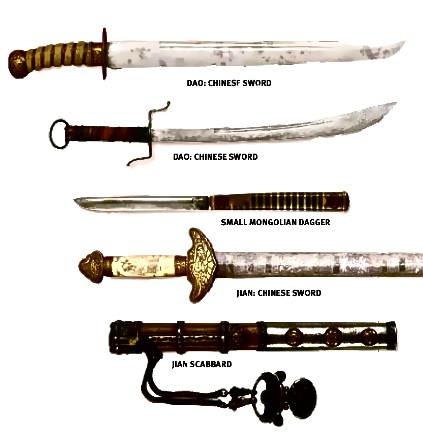 |
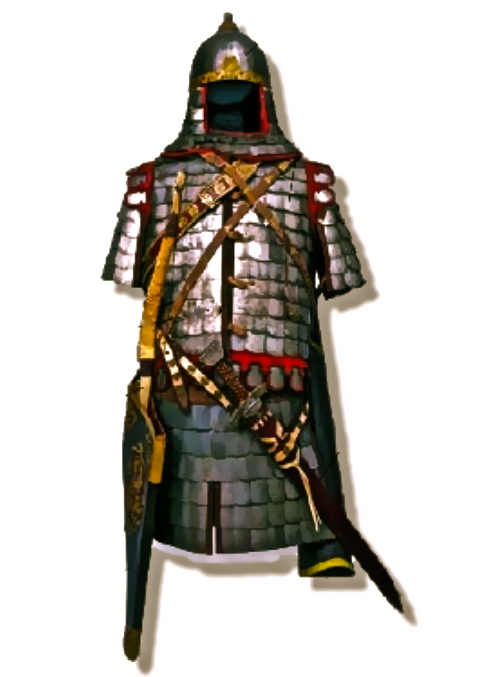 |
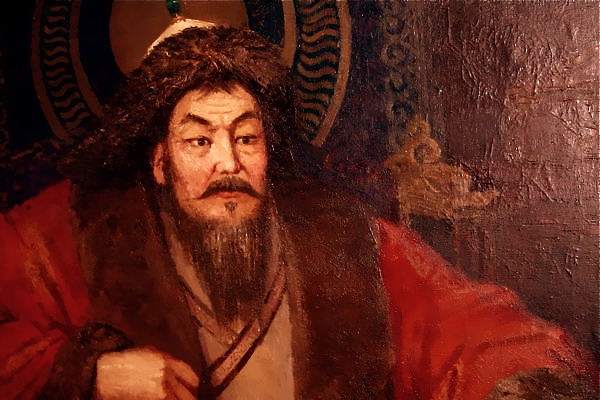 |
 |
| The Turko-Mongol people were all united for the first time in many
centuries, but they had lived too long governed by tribal customs as
varied as the men themselves. To contain their wild nature, Genghis Khan
used his already established military structure of veteran Mongols, and
also placed all Mongols in all clans under one law, Yassa Law (a
combination of his will and the most expedient of tribal customs). This
was possible, because in their ecstatic enthusiasm they believed Temujin,
now Genghis Khan, was in reality a "Bogdo", a sending from the Gods,
endowed with the "Power of Heaven".
In Yassa Law, though himself a man
of uncontrolled rages, Genghis Khan denied his people their most
cherished indulgence, violence. Additionally, adultery and theft carried
the death penalty. Spies, sodomites, false witnesses and black sorcerers
were put to death. But a man could not be found guilty unless caught in
the act of the crime, if he did not confess. Among the Mongols, an
illiterate people, a man's spoken word was a solemn oath. An accused
nomad usually admitted guilt. Some came to the Khan and asked for
punishment. The general of a division a thousand miles away from the
court of the Khan, submitted to be relieved of his command and executed,
at the order of the Khan, brought by a common courier!
The first law of the Yassa is remarkable. "It is ordered that all men
should believe in one God, creator of Heaven and earth, the sole giver
of goods and poverty, of life and death as pleases Him, whose power over
all things is absolute."
Genghis Khan was a deist, raised among the ragged and rascally
shamans of the Gobi, his code treated religious matters indulgently. An
unlikely array of priesthoods trailed after the Mongol camps, on their
way to war; leaders of faiths, devotees, criers of mosques, Nestorian
Christians, shamans and magicians, 'Saracen' soothsayers. And, quote
Father Rubruquis, "Wandering yellow and red lamas swinging prayer
wheels, some of them wearing stoles, painted with a likeness of the true
Christian Devil."
The Mongols worshipped the Blue Sky. The Yassa addressed a great
weakness of the Mongol peoples. The Mongols had a terrible terror of
thunder. During the severe storms of the Gobi Desert, this all powerful
fear overwhelmed them sometimes, and they hurled themselves into lakes
and rivers to escape the Wrath of the Sky. The Yassa therefore forbade
bathing during a thunder storm, with or without clothes.
The success of the Yassa can be gleaned from a contemporary, Father
Carpini, "They are obedient to their lords beyond any other people,
giving them vast reverence and never deceiving them in word or action.
They seldom quarrel, and brawls, wounds or slaying hardly ever happen.
Thieves and robbers are nowhere found, so that their houses and carts,
in which all their goods and treasures rest, are never locked or barred.
If any animal of their herd goes astray, the finder leaves it, or drives
it back to the officers who have charge of strays. Among themselves they
are courteous and though victuals is scarce, they share then freely.
They are very patient under privations, and though they may have fasted
for a day or two, will sing and make merry. In journeying they bear cold
or heat without complaining. They never fall out and though often drunk,
never quarrel in their cups."
Father Carpini describes Mongol attitude, "Toward other people they
are exceedingly proud and overbearing, looking upon all other men,
however noble, with contempt. For we saw in the Emperor's court the
great Duke of Russia, the son of the King of Georgia, and many sultans
and other great men who had no honor or respect. Indeed, even the Tatars
appointed to attend them, however low their own position, always went
before these high born captives and took the upper places."
Father Carpini finishes, "They are irritable and disdainful to other
men, and beyond belief deceitful. Whatever mischief they intend they
carefully conceal, that no one may provide against it. And the slaughter
of other people they consider as nothing." |
|
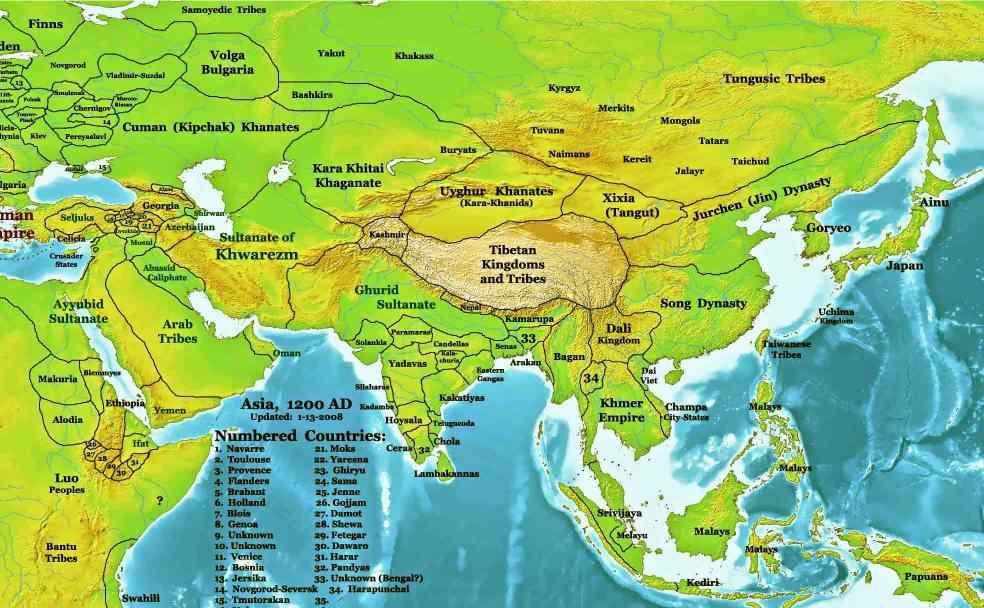
|
|
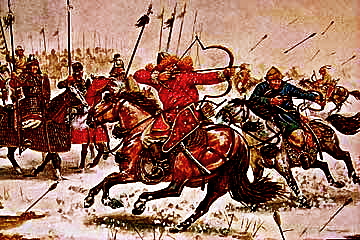 |
 |
| The Mongols were not of the same race as the Chinese proper. They were
descended from the Tungusi of aboriginal stock, with a strong mixture of
Persian and Turkish blood. These were the nomads of high Asia that the
Greeks named Scythians. The Mongols were able to overcome the terrors of vast deserts, the
barriers of mountains and waterways, the severities of climate, and the
ravages of famine and pestilence. No dangers could appall them, no
stronghold could resist them, no prayer for mercy could move them.
In 1206, the year
Genghis Khan united the Turko-Mongol peoples, the Khitai (Chinese) "Warden of the Western Marches", whose duty was to
watch over the barbarians beyond the Great Wall and collect tribute from
them, reported that "Absolute quiet prevails in the far kingdoms."
The Golden Emperor, in the course of his continual warfare with the
ancient house of Sung in the south, beyond the "Son of the Ocean", the
great Yang-tze river, sent emissaries to his subject, the Mongol "Commander
Against Rebels", to request the assistance of the nomad
horsemen. Genghis Khan responded immediately with two tumans of his
elite warriors. Chepe Noyon and other Orkhons commanded these cavalry
divisions. While in Khitai they used their eyes and asked questions.
They had the nomad ability to remember landmarks. They returned well
versed in the geography of Khitai. They also brought back to the Gobi
tales of wonders, such as the roads that ran clear across rivers.
High Asia was a troubled land. Along the ancient Nan-lu, the southern
caravan route, existed the curious kingdom of Hia, the so-called "Robber
Kingdom". Here were the lean and predatory Tibetan's, come down from the
mountains to plunder with their allies, the criminal outlaws of Khitai.
Beyond them extended the power of Black Cathy, in the T'ien Shan, a kind
of mountain empire, where Gutchluk ruled. And to the west, the roving
hordes of Kirghiz who had previously kept out of the Mongols path.
Against all these troublesome neighbors, Genghis Khan sent mounted
divisions, commanded by his veteran Orkhons. His war of raids in open
country convinced them it would be well to make peace with him. The
chieftains sent daughters to be wifes of the Khan, in order to
strengthen the bond. All this was preparation, cautionary, clearing his
flanks in military language.
Then the monarch of Khitai died and his son was seated on the Dragon
Throne. Genghis Khan refused to pay the tribute demanded by the new
Emperor Wai Wang, and sent an envoy to the imperial court with his
message. "Our dominion," said Genghis Khan, "is now so well ordered that
we can visit Khitai. Is the dominion of the Golden Khan so well ordered
that he can receive us? We will go with an army that is like a roaring
ocean. It matters not whether we are met by friendship or war. If the
Golden Khan chooses to be our friend, we will allow him the government
under us of his dominion; if he chooses war, it will last until one of
us is victor, one defeated."
Emperor Wai Wang called the Warden of the Western Marches to stand
before the 'Clouds of Heaven' imperial court and answer what the Mongols
were about. He replied they were making many arrows and gathering
horses. The Warden of the Western Marches was arrested and placed in prison.
Genghis Khan also sent envoys to the Liao-tung in the most northern
region of Khitai. These warlike spirits had not forgotten their conquest
by a previous Golden Emperor. The Liao Dynasty swore a compact with
Genghis Khan, and blood was drawn and arrows broken to bind it. The men
of Liao, means literally "Men of Iron". Liao would invade the north of
Khitai in conjunction with the Mongol Horde. In return the Great Khan
promised to restore all their previous power. Genghis Khan eventually
kept his word to the letter, making the princes of Liao the rulers of
Khitai, under himself. Genghis Khan had a limited number of warriors, and a single defeat
against Khitai could scatter the nomad clans back into their desert.
Genghis Khan would for the first time, need to maneuver his divisions against armies led by
masters of tactics.
|
|
 |
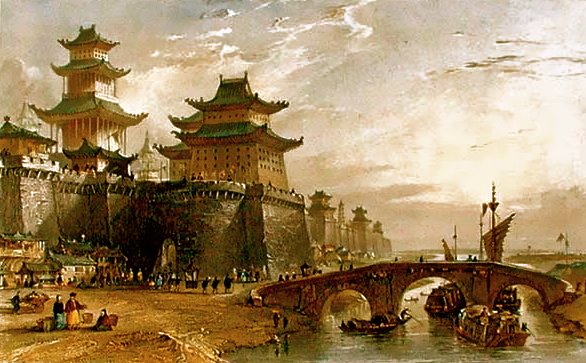 |
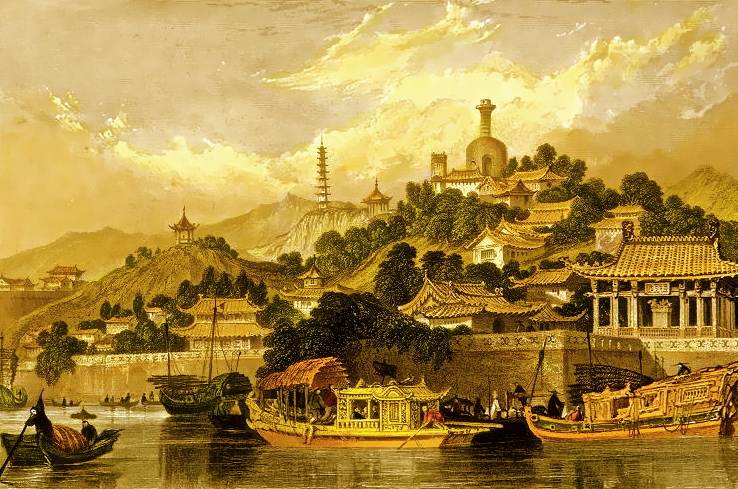 |
| The Mongol Tatars called the great kingdom of civilization beyond
the Gobi, Khitai (China). In Khitai existed a culture over five thousand
years old, with written records extending back more than thirty
centuries. The men of Khitai were not free and wild like the nomads of
the steppes. The men behind the Great Wall were mostly slaves, beggars
and peasants, with an aristocracy of scholars, soldiers, religious
mystics, mandarins, dukes and princes. Since time immemorial there had
always been an emperor, the "Son of Heaven", Tien Tsi, and a court, the
"Clouds of Heaven". In the year 1210, the 'Year of the Sheep' in the
calendar of the twelve beasts, the throne was occupied by the Chin or
Golden Dynasty. The court was at Yen-King, near the location of modern
Beijing.
Within the great cities of Khitai, in the thirteenth century, over the
heads of high officials umbrellas were held, carried by slaves. Garments
were of floss silk multiply colored brilliantly. Inside the entrances of
dwellings, screens served to keep out wandering devils. Bamboo books
written in forgotten ages were studied and discussed at endlessly long
feasts. Within the cities were pleasure lakes and barges where men could
sip rice wine, and listen to the melody of silver bells in a woman's
hand. They might, perhaps, drift under a tiled pagoda roof, or hear the
summons of a temple gong. The pursuit of perfection is a laborious
process, but time did not have much meaning in Khitai. A painter
contented himself with touching silk with a bit of color . . . a bird on
a branch or a snow-capped mountain top. A detail, but a perfect detail.
A vagabond Taoist poet, in drunken contemplation, chasing the moon's
reflection in water, drowns, and is immortalized.
Kwan-ti, the War God, never lacked devotees. The
waging of war
had
been an Art in Khitai, since the days when the armored regiments and
chariots maneuvered over the wastes of Asia, and a temple was erected on
the battlefield, in the army camp, for the general commanding to
meditate upon strategy undisturbed. War engines Khitai had, twenty horse
chariots, ancient and useless, but also stone casters, crossbows the
strength of ten men could not wind, and catapults which required two
hundred artillerists to draw taut the massive ropes, which launched
great stones and the
"Fire That Flies".
|
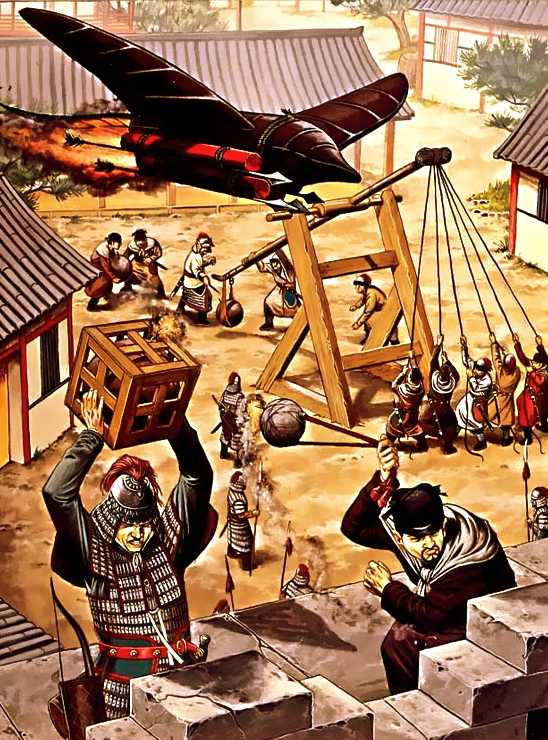 |
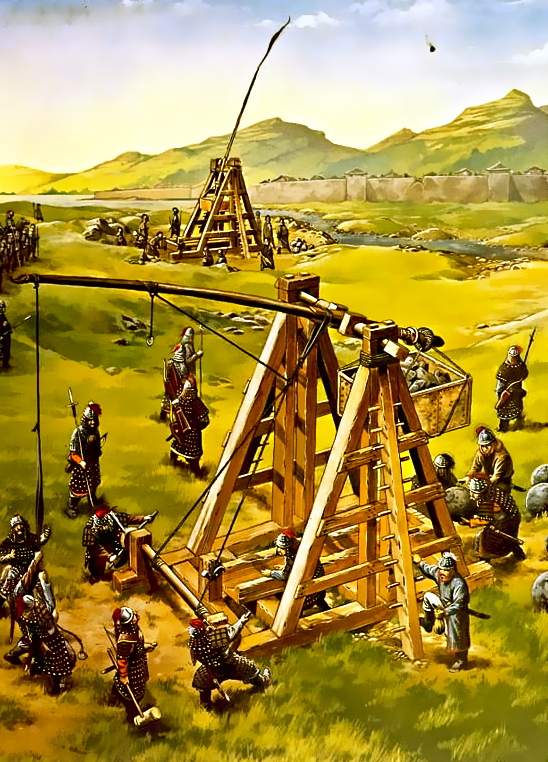 |
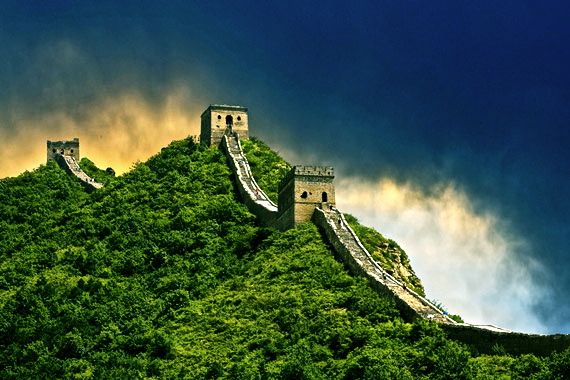 |
The ancient history of Khitai is plagued by barbarian invasions from
the Gobi. Long ago the Khitayan barbarians themselves had descended from
the north, and later, during the Warring States Period, the desert
tribes had been united, briefly, under the Hiung-nu monarchs who harried
ancient Khitai until the
Great Wall was built to shut them out, and only
a century ago came the Chin incursion. These invaders had always been
absorbed into the great multitude of peoples comprising the kingdom of Khitai. After a period the invaders fell into the manners of Khitai,
clad themselves in it's garments and followed it's ancient rituals.
 |
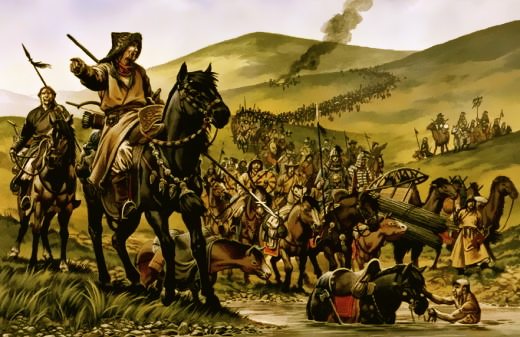 |
The first of the Horde sent by Genghis Khan had long
since entered the Kingdom of Khitai. Spies and warriors, ordered to
capture and bring back informers to the tent of the Khan, had already
been at work behind the Great Wall for some time.
Next infiltrated the advance points, two hundred riders
scattered over the countryside in pairs, acting as scouts. Far behind
these scouts came the advance, thirty thousand veteran warriors, three
tumans (divisions), on the best horses, at least two horses for each
cavalryman. These were commanded by Muhuli, Chepe Noyon and Subotai,
chosen from the Khan's marshals.
In constant communication by courier horsemen with the
advance forces, the main body of the horde rolled like thunder over the
barren plateaus, out of the Gobi, a massive roiling cloud of dust
surrounding it's advance. |
| A hundred thousand, mostly Yakka Mongols of long, loyal service,
formed the center, with both the right and left wings half as many
warriors each. Genghis Khan always commanded the center, keeping his
youngest son, Tuli, at his side for instruction in war. The Khan himself
was constantly protected by his "Imperial Guard", one thousand hand
picked heavy cavalry, mounted on black horses with black leather armor.
The Horde approached the Great Wall unhindered, and passed through
that barrier without delay or the loss of a single man. Genghis Khan had
been tampering with the frontier tribes for some time, and so one of the
great gates was opened to him by sympathizers. |
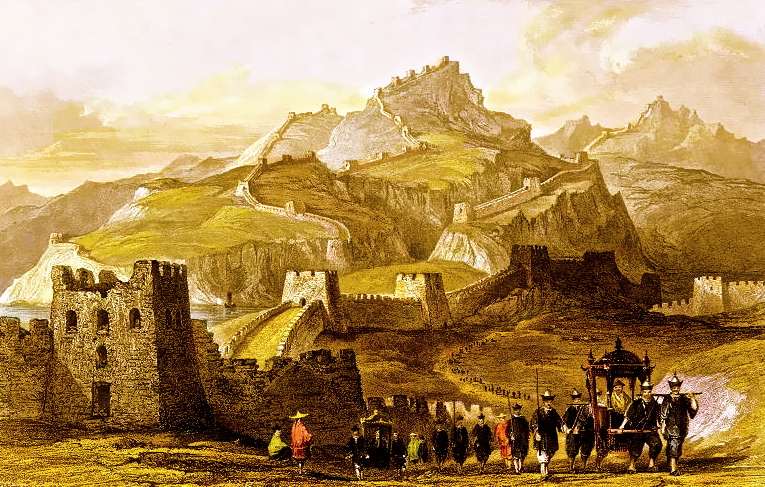 |
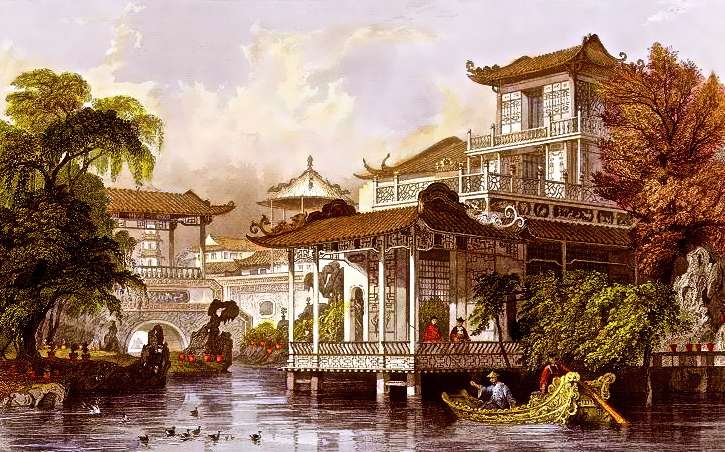 |
| Once the wall was behind them the Mongol divisions separated to
carry out predetermined tasks. Highly mobile, they needed no base of
supplies. Mostly infantry, the forces of Khitai guarding the frontier
roads were decimated by arrows shot from the backs of fleet footed
horses, into the close packed formations of the foot soldiers.
One of the Emperor's armies on the road to war with the Mongol
invaders, lost it's way, and had to ask peasants for directions. Chepe
Noyon remembered the roads and valleys of the area from his service to
the previous Golden Emperor, by command of the Khan. He traversed the
difficult terrain of the region in the black of night and came upon the
Chin forces, unexpectedly from the rear, the next day. The Mongols broke
the cohesion of the Chin, and the scattered remnants of it, fleeing
east, brought fear to the largest army of Khitai, which was approaching.
This fear turned into terror and the commanding general fled back
towards the capital city. |
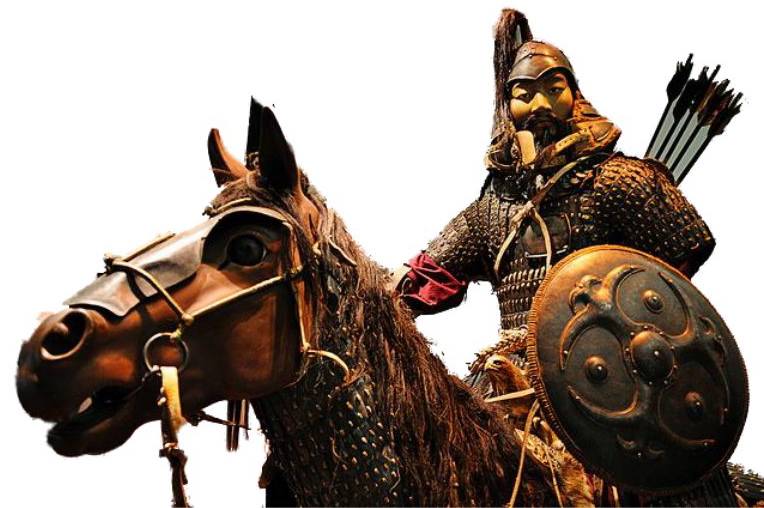 |
| Several cities were taken by the Mongols, but Taitong-fu, the
Western Court, still held out. Genghis Khan advanced toward the reigning
city, Yen-king itself. The devastation wrought by the Mongol horde
and it's near approach to the capital, filled Emperor Wai Wang with
alarm.
Now the greatest power of the Empire rallied to the defense of Khitai;
the innumerable multitudes, the devoted throngs, born from a line of
warlike ancestors, they knew no higher duty than to die for the throne.
The sleeping giant was shocked from slumber. New armies appeared,
approaching along the great rivers, and the garrisons of cities seemed
to multiply daily. |
| When Genghis Khan reached the capital at Yen-king, and beheld for
the first time the magnificence of the high walls, and row upon row of
citadel fortresses, he realized the war could last lifetimes. He drew
back immediately from Yen-king, and in the autumn withdrew the horde to
the Gobi.
In the spring, upon fresh horses, Genghis Khan appeared again,
suddenly, inside the Great Wall. Those frontier towns that had
previously surrendered were now garrisoned and defiant. The Khan set to
work and laid siege again to the Western Court at Taitong-fu. As the
Chin infantry armies approached to relieve the siege of the court, they
were cut to pieces and scattered by the Mongol cavalry tactics that
whirled around in circular patterns, and loosed clouds of arrows upon
retreating. But the Mongol allies, the Liao princes, were sorely beset
by a Chin army of sixty thousand far up in the north of Khitai,
and requested the aid of the Khan. Genghis Khan was forced to dispatch a
division north, under the Orkhon marshal Chepe Noyon, who destroyed the
enemy with his tuman, and the art of deception.
Meanwhile, the Kha Khan, pressing vigorously the siege at the Western
Court, was wounded. The Mongol horde withdrew from Khitai, as the tide
ebbs from the shore, bearing their wounded chieftain with it.
The Mongol cavalry could out maneuver and decimate the armies of
Khitai in open battle, but did not have the siege warfare experience
necessary to take walled heavily garrisoned cities.
In the north the Chin military expeditions were prevailing against
the Iron Men of Liao-tung, and the riders of Hia, who guarded the flanks
of the Khan. |
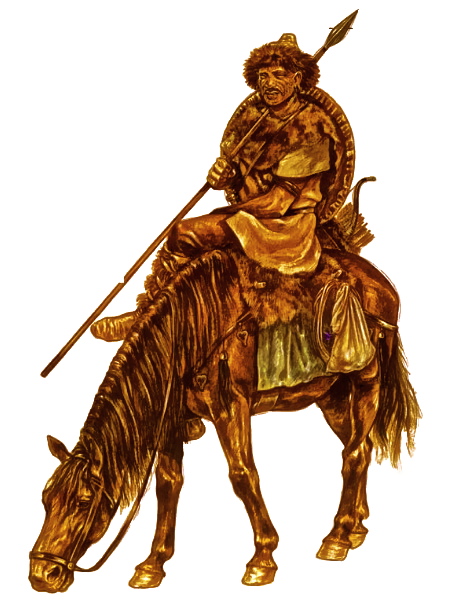 |
|
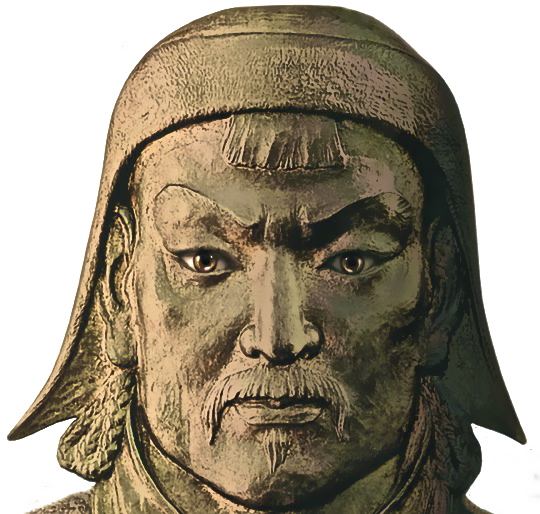 |

Early spring of 1214, Genghis Khan launches three Mongol
armies into Khitai. In the south, three sons of the Khan, Ogotai,
Chatagai and Tuli cut a wide range of devastation. In the north, the
eldest son, Juchi, crossed the Khingan range and joined forces with the
Iron Men of Liao-tung. Genghis Khan forged the Mongol center of the
Horde deep into Khitai, to the very shores of the great ocean behind the
capital at Yen-king.
Genghis Khan ordered his divisions to wage war with a
new strategy of terror. |
| As the Mongol tumans rode across the countryside, in approach of
cities or garrisoned strongholds, they swept up the people and drove
them before the approaching Horde, in the first wave of the onslaught.
When a city resisted they settled down to a siege. When the citizens of
a city opened their gates and surrendered they were spared their lives,
even as everything in the open country was annihilated and driven off;
crops trampled, herds rustled, men, women and children cut down.
Refugees carried word of this far and wide across Khitai. As the
season of war drew to a close with autumn, and the Mongols would need to
return to the Gobi, Genghis Khan, laying siege to Yen-king, sent a
message to the Golden Emperor, besieged in Yen-king. "What do you think
now of the war between us? All the provinces north of the Yellow River
are in my power. I am going to my homeland. But could you permit my
officers to go away without sending gifts to appease them?"
The Chin monarch, Wai Wang, a man in terrible fear, agreed to a
truce. A lady of the reigning family was sent to Genghis Khan as a wife.
A thousand young male and female slaves carrying silks and gold, and
also a herd of the finest horses, were sent to the Khan. And so Genghis
Khan turned back to the Gobi and when he reached it's edge he put to
death the multitude of captives carried along by the Horde. They
wouldn't have survived the trek through the wastelands, and human life
had no value in the eyes of the Mongols. They desired only to depopulate
fertile lands to provide grazing for their herds. It was the Mongol
boast, at the long end of the war against Khitai, that their horses
could be ridden without stumbling across the sites of what had been
great cities. It was the custom of the Mongols to put to death all
captives, except artisans and savants, when they returned home after a
campaign. |
| The Golden Emperor was shaken, "We announce to our subjects that we
will change our residence to the capital of the south." Wei Wang fled
south. Rebellion followed upon his flight! Some troops escorting the
Golden Emperor mutinied and abandoned the monarch. The defense of Khitai
was left to hereditary princes, officials and mandarins.
In the face of danger the populace rallied, as the deep spirit of
loyalty to Khitai manifested. The flame kindled stirred up a firestorm.
Mongol garrisons and outposts were attacked. A relief army was sent to
Liao-tung with great success. The sudden reversal became known to
Genghis Khan. When his understanding was complete he acted immediately.
The Horde was at the end of a season of war. The horses were
exhausted, sickness was within the camps, provisions were low, but the
Khan chose the best division and ordered it south toward the Yellow
River to pursue the fleeing Emperor. It was now winter, but the Mongols
pushed on swiftly, forcing the lord of the Chins to cross the river into
the domain of his old enemies the Sung Dynasty. Even there the Mongol
division followed him, feeling their way among snow covered mountains,
crossing ravines on spear shafts and the branches of trees bound
together with chains. The imperial fugitive appealed for aid to
the Sung court. |
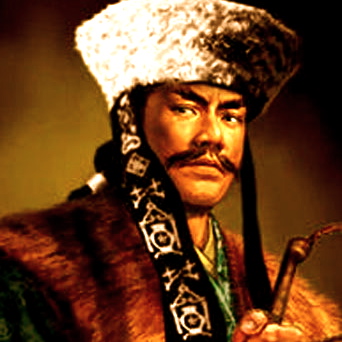
Emperor Wei Wang |
| Couriers sent by Genghis Khan recalled the tuman, and they made a
wide circle of the Sung cities, crossing the Yellow River surface on the
ice of winter, to return to the Horde. Genghis Khan was at the center of the Horde, camped near the wall.
Reports constantly arrived by couriers, riding hard pressed horses, and
not dismounting to cook food or take sleep while en route. The Khan was
now fifty five years of age. His sons were now grown men. Genghis Khan's
favorite grandson Kublai had been born. |
|
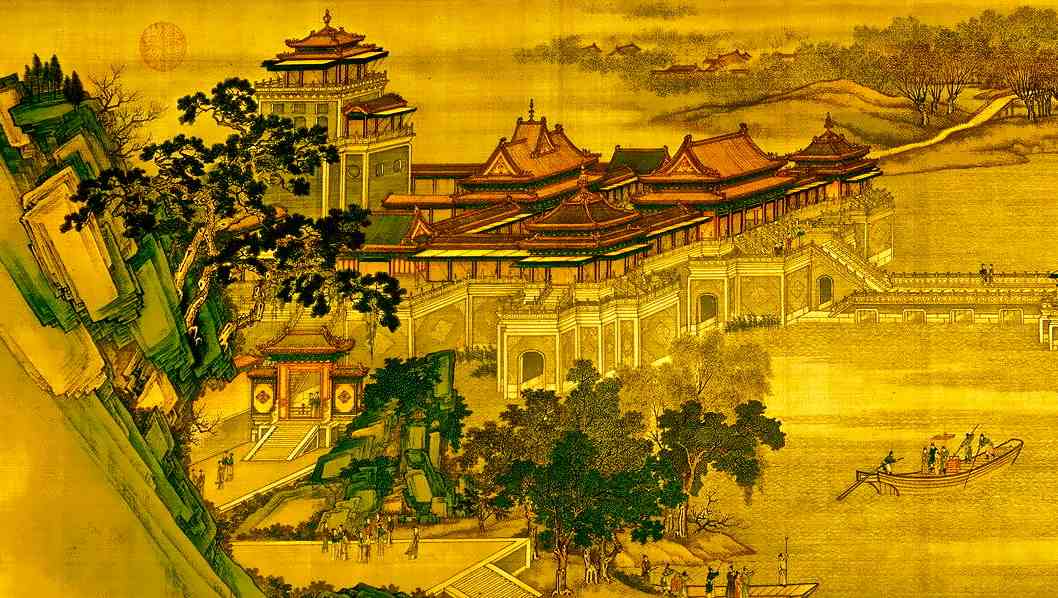 |
| It was Muhuli, aided by Mingan, a prince of Liao-tung, who directed
the thrust at Yen-king. With no more than five thousand Mongols under
his command, he traveled eastward gathering up a multitude of Khitai's
deserters and wandering bands of warriors. With Subotai covering his
flank he pitched tents before the outer walls of Yen-king.
Yen-king could have endured, but it was a city in chaos. With the
first breakout of fighting in the suburbs one of the Chin generals
deserted. Looting began in the merchants district, and streets were
filled with wandering, frightened soldiery. Fire followed, appearing in
various parts of the city. In the palace itself, eunuchs and slaves
flitted through the corridors, arms full of gold and silver ornaments.
The 'Hall of Audience' was deserted, and the sentries left their posts
to join the pillagers.
Wang-Yen, the commanding general, a prince of royal blood, considered
matters as hopeless, and so prepared to die as custom required. He
retired to his chambers and wrote a petition acknowledging he had been
unable to defend Yen-king and was worthy of death. This was written on
the lapel of his coat. His wealth he divided among his servants. Next,
he ordered his attendant mandarin to prepare a cup of poison.
When Wang-Yen drank his poison Yen-king was in flames, and the
Mongols rode in upon a scene of defenseless terror. The methodical
Muhuli, indifferent to the passing of a dynasty, occupied himself
|
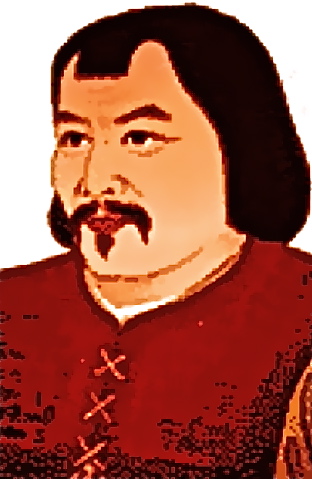
Muhuli |
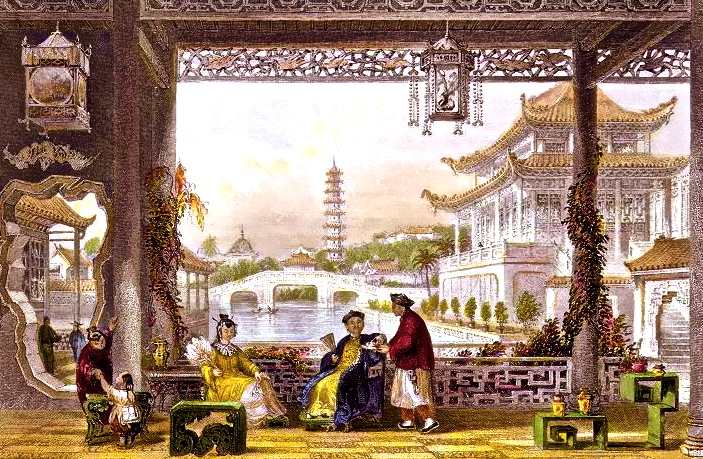 |
with collecting and sending to the Khan the treasures and the
munitions of the city.
Genghis Khan left the military government of Khitai, and the eventual
conquest of the southern Sung Dynasty to Muhuli, praising him publicly
and bestowing on him a banner embroidered with nine white yak-tails. "In
this region," he explained to his Mongols, "the commands of Muhuli are
to be obeyed as my commands."
No higher office could have been bestowed on the veteran Orkhon.
Genghis Khan kept to his word and left Muhuli undisturbed, with his
portion of the horde now under his iron will.
For the civil authority of Khitai Genghis Khan appointed governors
from among the Liao-tung men. |
| The Khan admired the courage of the mandarins who had carried on the
war after the desertion of their Emperor, and in the hardihood and
wisdom of these men he discovered something useful to himself. Ye Liu
Chutsai, for instance, could name the stars and explain their portents.
When he carried back with him to Karakorum the golden treasures of
Khitai, he took also members of the literati; scribes, scholars and
philosophers. Of all Genghis Khan's many sons he recognized only those born of
Bourtai as his heirs. They had been his close companions, he had
observed them continuously, bestowing early upon each of them a tutor,
drawn from the ranks of his best veteran officers. His youngest son,
Tuli, was carried beside his father to war upon a throne of human
skulls. When the Khan had satisfied himself as to his sons different
natures and abilities he made them "Orluks" (Eagles), princes of the
imperial blood. Genghis Khan designated their duties. Juchi, the first
born, was 'Master of Hunting'. Chatagai became 'Master of the Law and
Punishment'. Ogotai was 'Master of Council'. The youngest, Tuli,
nominally chief of the army, the Khan kept close, at the Mongol center.
And now, from the China Sea to the Aral Sea one master
reigned. Rebellion had ceased. The couriers of the Great Khan galloped
over fifty degrees of longitude, and it was said that a virgin carrying
a sack of gold could ride unharmed from one border of the nomad empire
to the other. Envoys of the Khan, bearded men of Khitai, intoned the new
law of the conqueror, appearing everywhere, bringing order out of chaos.
The shadow of the Yassa fell upon the conquered lands.
The "Master of Thrones and Crowns" was soon to become
the "Scourge". His next war of conquest was terrible in its
effect, and it was toward the west, toward the very heart of Islam.
|
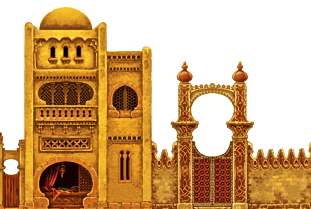 |
 |
|
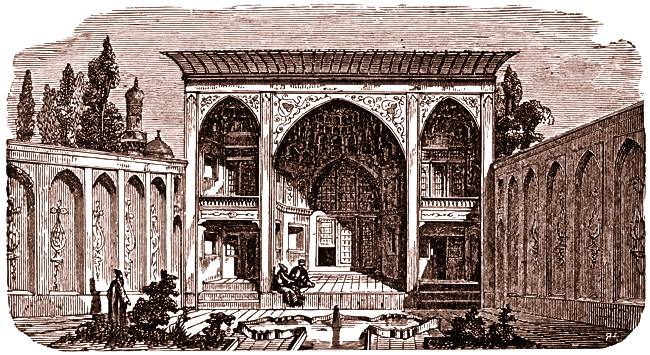 |
.jpg) |
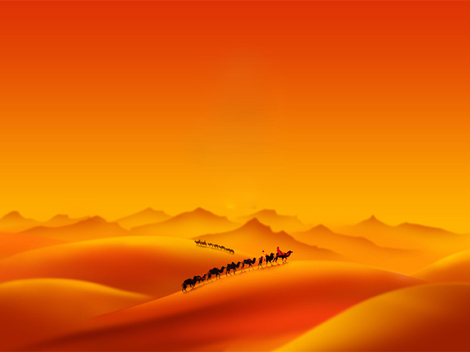 |
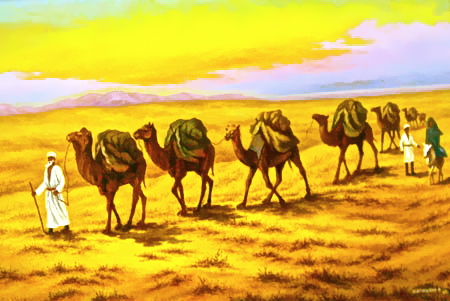 |
For the moment Genghis Khan was interested in trade. To the west was
the great barrier of mid-Asia, a treacherous network of mountain ranges
that extended northeast and southwest of the Taghbumbash, the "Roof of
the World". From time immemorial this mountain obstacle had existed. It
stood, vast and desolate, between the nomads of the Gobi Desert and the
rest of the world. These mountains separated the plains-dwellers of
Genghis Khan from the valley-dwellers of the west, which land was called
Ta-tsin, the "Far Country".
The caravans of the ancient Silk Road traversed this massive, difficult,
continental barrier regularly, and the merchants informed the Khan of
many wondrous things. On the other side of Taghbumbash there existed
fertile valleys where snow never fell. Here, also, were rivers that
never froze. Here multitudinous peoples lived in cities more ancient
than Karakorum or Yen-king. And from these people came the caravans that
brought finely tempered steel blades and the best chain mail, also white
cloth and red leather, ambergris and ivory, turquoise and rubies. |
|
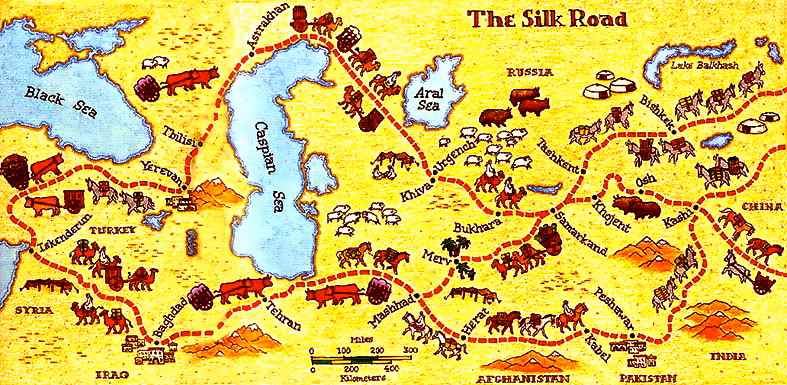 |
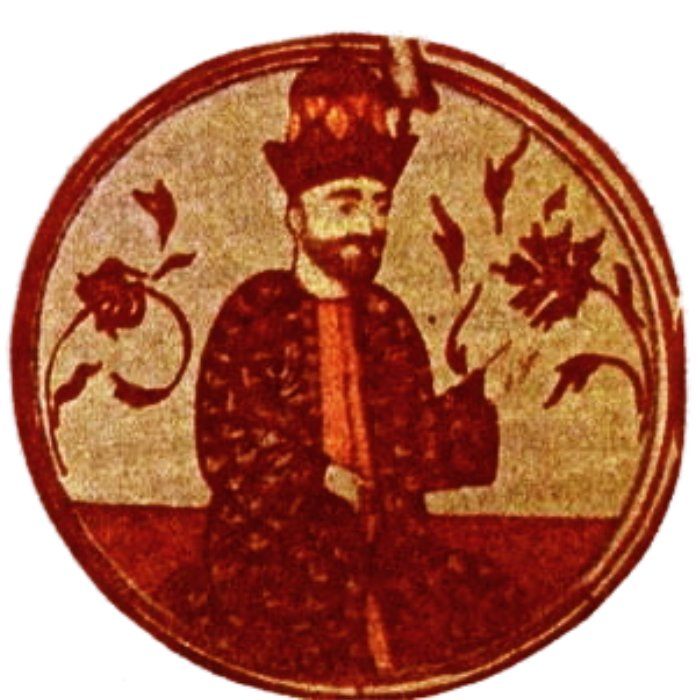
Ala-eddin Muhammad the Shah of Khwarezm
|
And so, Genghis Khan determined to trade with the west for the fine
weaponry of the Moslem armorers. He encouraged his own merchants,
subject Moslems themselves, to send caravans to the west. He learned
that his nearest neighbor to the west was Ala-eddin Muhammad, the Shah
of Khwarezm, himself a conqueror of a large kingdom. To this Shah the
Khan sent envoys, and a message, "I send thee greeting. I know thy power
and the great extent of thine empire, and I look upon thee as a most
cherished son. On thy part, thou must know that I have conquered Khitai
and many Turkish nations. My country is an encampment of warriors, a
mine of silver, and I have no need of other lands. To me it seems that
we have an equal interest in encouraging trade between our subjects."
The envoys of the Great Khan brought rich gifts to the Shah, bars of
silver, precious jade, and white camel's hair robes. "Who is Genghis
Khan?", demanded Muhammad Shah, "Has he really conquered Khitai?" The
envoys replied that this was so."Are his armies as great as mine?",
questioned the Shah. The envoys, in fear, replied that the horde of the
Khan could not be compared to the host of Khwarezm. The Shah was
satisfied and agreed to trade between kingdoms. For several years all
was well between them and trade prospered.
Then one Inaljuk, governor of Otrar, a frontier citadel of the Shah,
seized |
a caravan of several hundred merchants from Karakorum. Inaljuk sent
message to his Shah that the caravan carried spies. The merchants were
put to death upon Muhammad Shah's order. News of this eventually reached
the ears of Genghis Khan, who immediately dispatched envoys to the Shah
Muhammad in protest. The Khitai emissaries were bearded, so the Shah
slayed the chief envoy, burned the beards off the others, and sent them
back to the Gobi.
And Genghis Khan went off alone, to a mountain, and did long meditate
upon the events. "There cannot be two suns in the heavens," the Khan
said, "or two Kha Khans upon the earth."
Now, truly, spies were sent in numbers through the treacherous mountain
ranges and couriers traveled fast across the desert miles to summon men
to the standard of the Khan. Genghis Khan sent an ominous message to the
Shah of Khwarezm, "Thou hast chosen war. That will happen which will
happen, and what it is to be, we know not. God alone knows." |
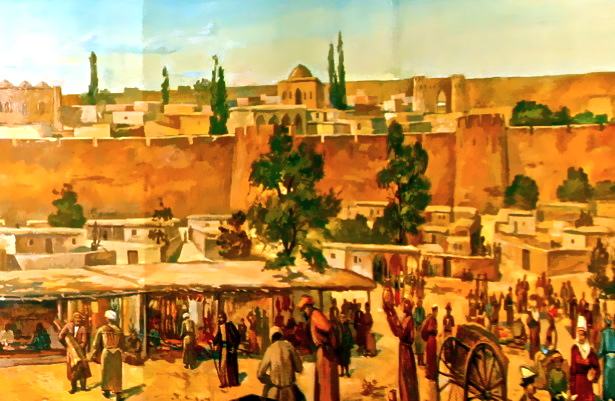 |
|
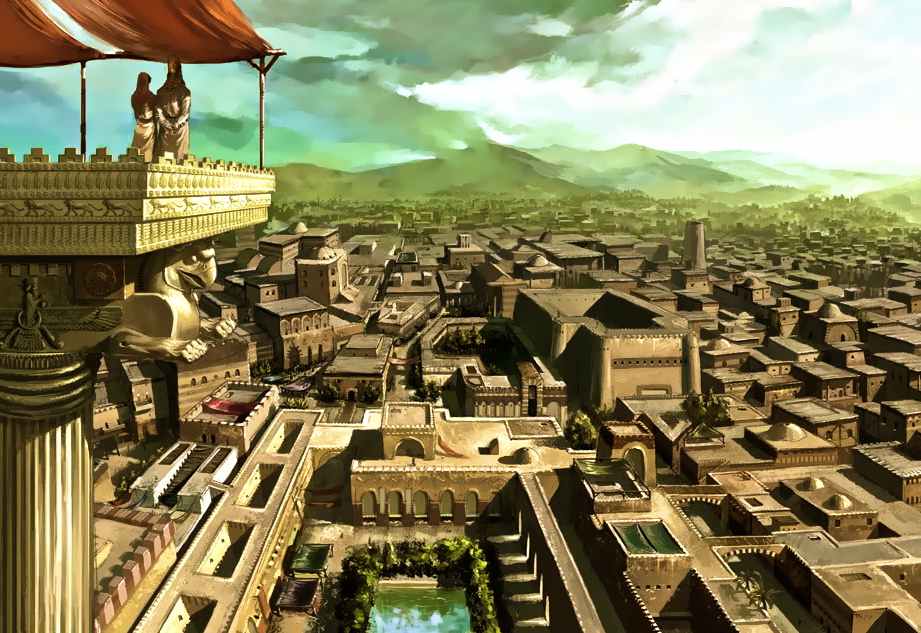 |
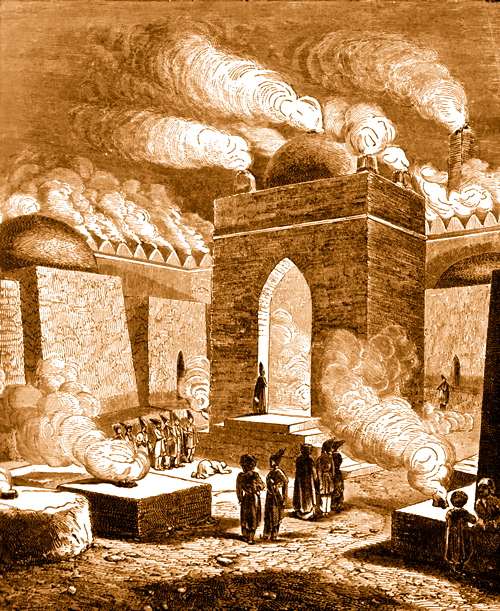 |

Islam was a martial world. Centuries ago it's Prophet
had lighted a fire that had been spread by his followers and their
swords. An orphan of the Khoraish Clan in the desert near the Red Sea
preached a new faith. He harangued the Arabs, telling them there was no
more than one God. The Arab peoples had worshiped until then many gods
and demons, and a great black stone. His name was Muhammad, son of
Abdullah, and he made a multitude tremble at his description of the day
of judgment. When Muhammad died in 632 A.D., as a result of being
poisoned, the multitude accepted Islam (submission), and the Koran
(recitation). There was one God, and Muhammad, the son of Abdullah, had
been His Prophet.
Under the Companions, who had been the Disciples of the
Prophet, the mad rush of conquest began. In less than a century the
banners of Islam had been carried east as far as the Indus and the
outposts of Khitai. The swords of Islam were flashing in the deep gorges
of Caucasus. Egypt had fallen to them, and all of north Africa, and
Andalus (Spain). Two obstacles checked the tide of the Muhammadans upon
Europe. Charles the Hammer, king of the Franks, withstood them in the
west. In the east they were flung back from the walls of Byzantium, the Eastern Roman Empire. |
| In time the military power of Islam passed from the Arabs to the
Turks, but both joined in the Jihad holy war against the mailed host of
Christian crusaders that came to wrest Jerusalem from them, empowered by
the edict of the Pope. Now, in the beginning of the thirteenth century
Islam was at the height of it's military power. The weakening Christian
crusaders had been driven to the coast of the Holy Land, and the first
wave of the Turks were taking Asia Minor away from the soldiery of the
degenerate Greek empire. At the very center of Islam, Muhammad Shah of
Khwarezm had established himself as war lord. His vast domain extended
from India to
Baghdad, and from the Sea of Aral to the Persian Gulf.
Except for the Seljuk Turks, victorious over the crusaders, and the
rising |
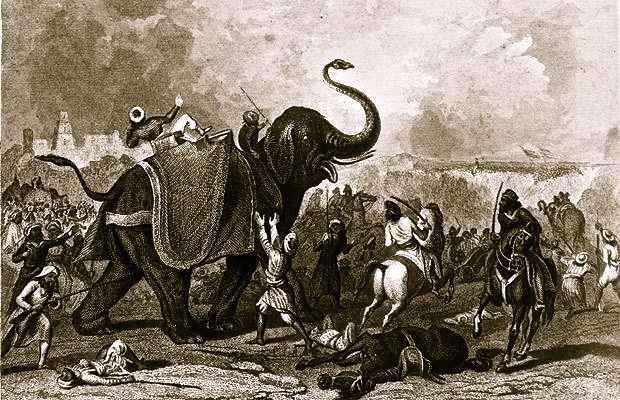 |
Mamluk Dynasty in Egypt, his authority was supreme. He and his
Atabegs or father-chieftains, were Turks. A true warrior of Turan, he
had something of military genius, and a grasp of things political. He
was called "Muhammad the Warrior". The core of his host of four hundred
thousand was composed of Khwarezm Turks, but he had besides the armies
of the Persians at his summons. War elephants, huge camel trains, and a
multitude of armed slaves followed him.
A main defense of the Khwarezm Sultanate was a chain of great cities
along the rivers; Bokhara the center of Islam's academies and mosques,
Samarkand of the lofty walls and pleasure gardens, Balkh and Herat, the
heart of Khorassan. This world of Islam, with an ambitious Shah,
multitudes of warriors, and mighty cities, was almost completely unknown
to Genghis Khan, far away in the Gobi Desert. |
|
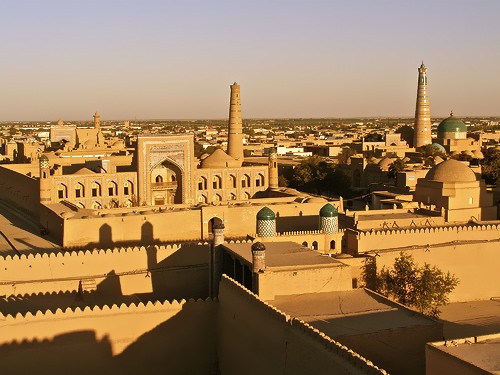 |
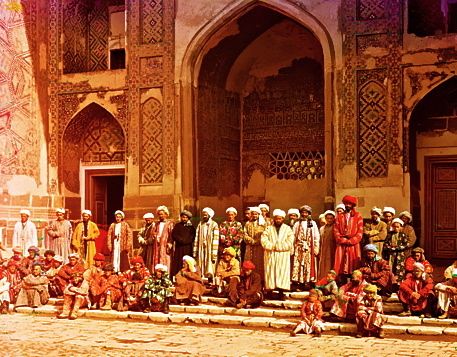 |
 Genghis Khan prepared for war. Muhuli continued his assault on
Khitai, and the princes of Liao were busy restoring order behind him.
From Karakorum the Khan scanned his empire through carefully chosen
agents, looking for anyone, but especially men of family and
ambition, who might cause trouble in his absence.
These received the kurultai, the summons that cannot be ignored, and were drafted into the
war machine of the Khan. The government of the Empire itself, he
determined to control wherever he traveled. He would communicate by
courier messenger system in administration, as he had in war. A brother
he left as governor in Karakorum.
|
| Genghis Khan contemplated the transport of a quarter million
warriors from Lake Baikul over the ranges of mid-Asia into Persia. A
distance of two thousand miles direct, but the mountains he would
traverse would add many miles more. Each rider was to bring a string of four
or five horses. The Mongol "shock divisions" had their horses encased in
lacquered leather of red or black. Every cavalryman had two bows, and a
spare arrow case covered to protect from dampness. Heavy cavalry carried
a saber, axes hanging from the belt, and a rope or cord lariat. Tens of
thousands of Khitai's finest military formed their own divisions under
the "Master of Artillery". They were men skilled in building and working
the heavy siege engines, the ballista, mangonels and the dread Ho-pao
"Fire Gun" flame throwers. Many non-combatants were conscripted;
interpreters, merchants to act as spies later, mandarins to take over
the administration of captured districts, etc.
Rivers had to be crossed. The horses, roped together by the saddle
horns, twenty or more in a line, breasted the current. Sometimes the
riders had to swim, holding to the tails. Soon the rivers could be
crossed on frozen ice. "Even in the middle of summer," Ye Liu Chutsai
wrote of the westward march, "masses of ice and snow accumulate in these
mountains." Genghis Khan crossed the barrier during the height of
winter. |
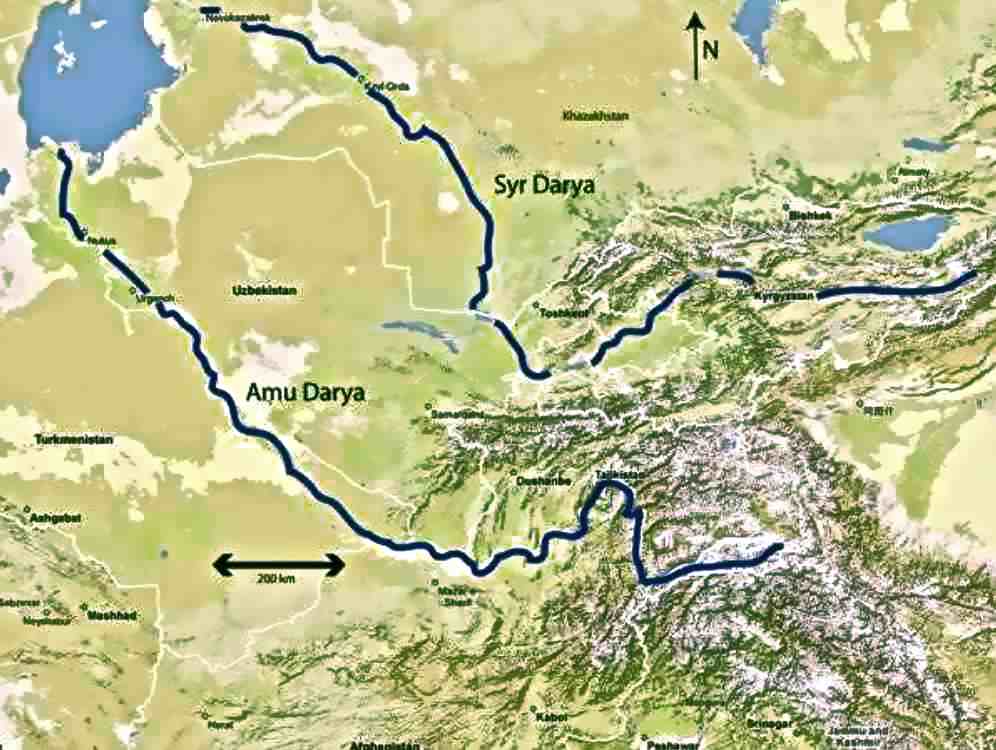 |
Entering the western ranges beyond the Gate of the Winds, the
Mongols cut down tall trees, hewing out massive timbers to be used in
bridging the gorges. A quarter million men endured unimaginable
hardships in the utter cold of high Asia. When food failed they merely
opened a vein in a horse, drank a small amount of blood and closed the
vein. The horde moved west, scattered over a hundred miles of dangerous
mountain country, the sledges rolling in their wake, the bones of dead
animals marking their path.
By the time the first grass showed, they were threading into the last
barrier of the Kara Tau, the Black Mountain Range. The various divisions
closed up ranks, liaison officers galloped back and forth between
commands, the nondescript looking merchants rode off in small groups to
gather information. A screen of scouts were thrown before the divisions.
Through the forest scenery the Mongols could see below them the first
frontier of Islam, the wide river Syr, swollen by spring freshets.
Already the advance foragers were busy collecting supplies for the army,
by driving off herds, gathering grain, and incidentally, setting fire to
the frontier buildings. |
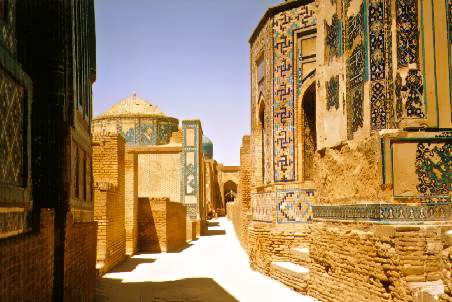 |
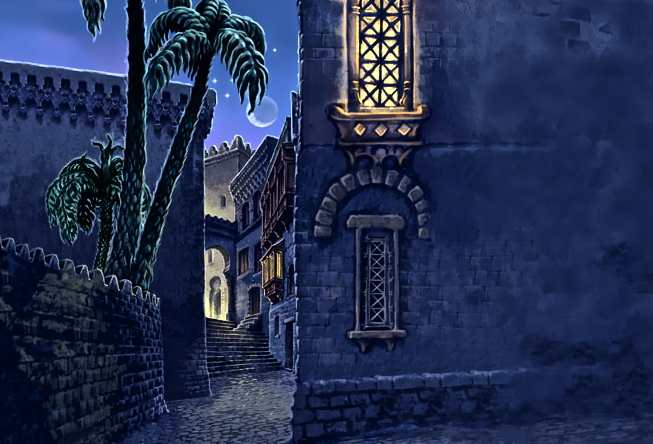 |
| Muhammad the Warrior was at the frontier even before the Mongols.
Recently victorious at war on the Indian subcontinent, the Shah
reassembled his army of four hundred thousand Turks, and organized his
Atabegs, and added divisions of Arabs and Persians. His spies carried to
him accounts of the approaching horde and he exclaimed, "They have
conquered only unbelievers. Now the banners of Islam are arrayed against
them."
The Shah deployed the mass of his army along the shores of the Syr
River, and moved up river with a contingent of about 30,000 men. In a
long valley with towering, forested cliffs on either side, Muhammad
Shah's force met an approaching Mongol division. Juchi, first born son
of Genghis Khan commanded the tuman. The forces of the Shah were three
times the strength of the Mongol division. The Mongol general advising
the prince said to retire at once and draw the Turks to the main body of
the horde. The son of the Khan gave the order to charge. "If I flee,
what then shall I say to my father?"
First charged the Mongol Mangudai, or "God-belonging" squadron, the
pre-doomed "Suicide Squad". The shock cavalry units followed closely
behind. Heavy cavalry came next with swords in rein hands, and long
lances in the right hands. The lighter, faster squadrons covered the
flanks. At least three times as many Turks than Mongols lay dead at
day's end. The Shah himself, if not for desperate efforts of his elite
household divisions, would have been killed. The enemy hosts separated
for the night. |
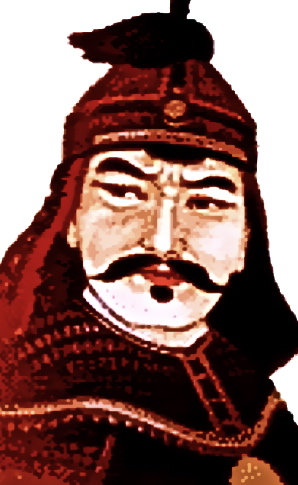
Juchi |
| Sunrise found Muhammad the Warrior and his remaining squadrons in a
valley filled eerily with only the bodies of the slain. The Mongols had
vanished without a trace. In fact, the Mongols had withdrawn upon fresh
horses, hidden for this purpose, and completed a march of two days in the
single night. No longer did the Khwarezm Shah think of searching for
the horde in the high valleys. And a dread turned him back to his
fortified towns. Re-enforcements were called for from the south. The
Shah deployed his army on the western bank of the river Syr and awaited
the arrival of the horde, intending to give battle when the Mongols
attempted to cross the river. But the Shah did not realize the war was
now raging across a front of one thousand miles, as the Mongol divisions
descended from the mountain ranges at multiple locations. In the
mountain region a host so huge was forced to break into segments, each
wending it's own path westward, each under command of a veteran Orkhon.
Muhammad Shah, encamped behind the Syr, was unable to learn where the
Mongols were moving. Then came alarming news. Mongols had been seen
descending from the high passes two hundred miles to his right,
and almost in his rear. The Mongol tumans, under Chepe Noyon, had no
more than twenty thousand men, but the Shah could not know this, and
ancient Samarkand was directly in the Mongol path. Aroused by danger,
Muhammad split up half his army among the fortified cities. The Shah
then advanced the remainder of his host towards Samarkand. |
|
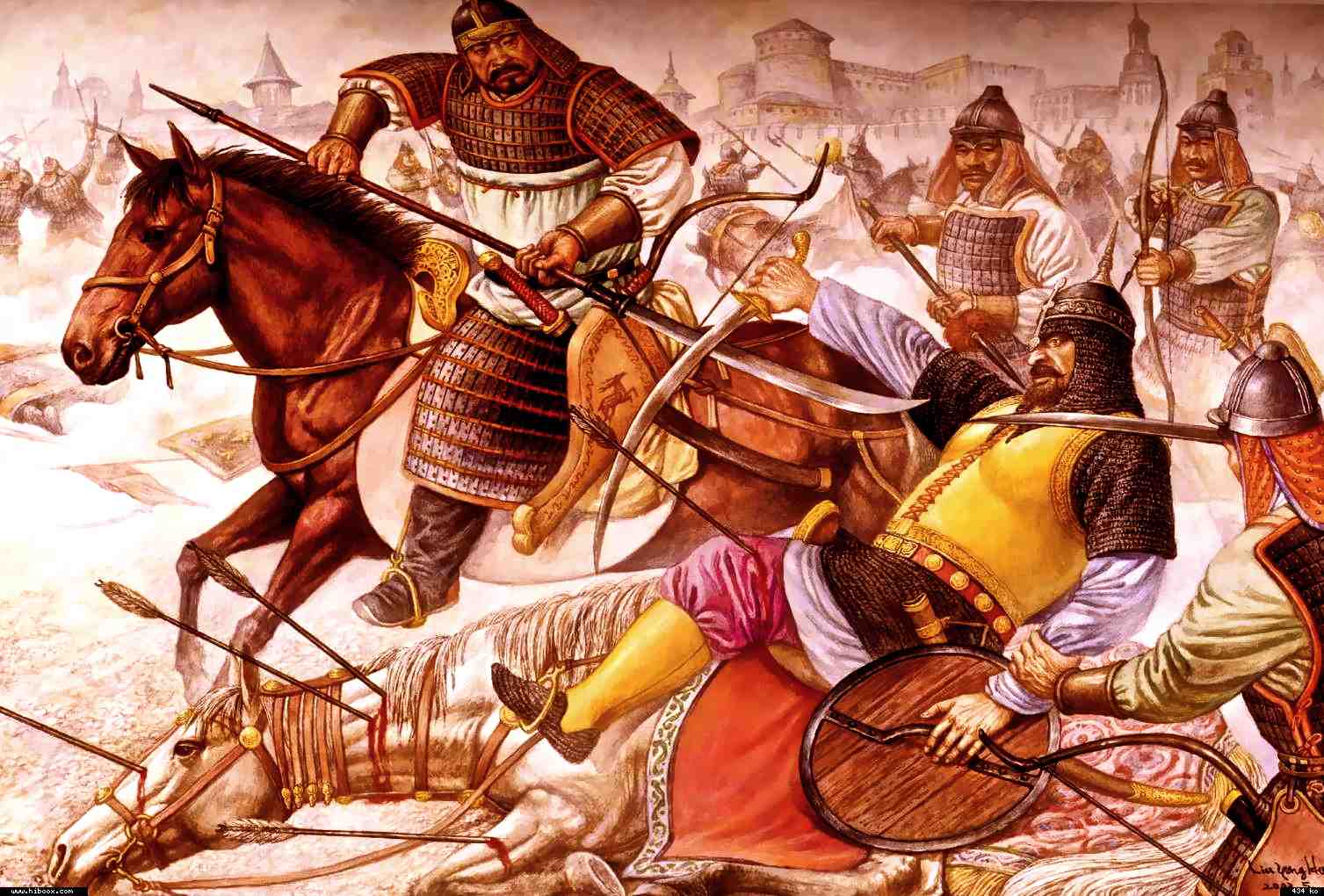 |
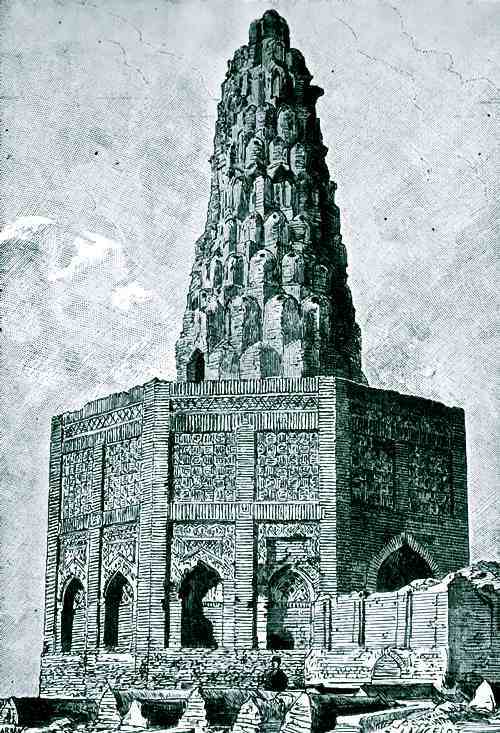 |
Even as these events transpired, two sons of the Great Khan had
appeared at Otrar, on the Syr, to the north. Otrar, whose governor had
put to death Mongol merchants. Inaljuk, who had ordered the executions,
was still governor of the city. In the great citadel of Otrar,
surrounded by the finest warriors at his command, in utter desperation,
they held out for five bloody months. Inaljuk, a man of war, took final
refuge in the highest tower and fought to the end, when the Mongols cut
down the last of his men. And when his arrows gave out he hurled stones
down on his foes. Taken alive, as a prize, in spite of total
desperation, he was sent to the Khan himself for judgement. Molten
silver was poured into his eyes and ears, the "Death of Retribution".
The walls of Otrar were razed to dust, and all inhabitants driven away.
While this was going on another Mongol force appeared at the Syr and
stormed Tashkent. A third detachment scoured the northern end of the Syr,
raiding the smaller towns. The Turkish garrison abandoned Jend, and the
people surrendered to the Mongols. The Turkish garrisons were massacred
by the merciless Mongols, but the city dwellers, mostly Persians, were
only driven out of the cities. But in one instance, where a Moslem
merchant envoy of the Khan had been torn to pieces by the men of the
town, the terrible "Mongol Storm" was begun. This is the attack that is
never allowed to cease. Without end, whether for days or months, fresh
warriors forever take the place of the slain, until the place was
carried, and it's people killed.
Genghis Khan never appeared along the Syr. The Mongol center had
vanished from human sight. Perhaps he made a wide circle through the Red
Sands Desert, because he appeared out of the barrens, marching swiftly
on Bokhara, from the west. Chepe Noyon was advancing from the east,
Genghis Khan was moving in from the west, and the Shah at Samarkand
might well feel that the jaws of a trap were rapidly closing in upon
him. |
| The Mongol tumans under the sons of the Khan, spreading fire, death
and fear along the Syr River, had been no more than so many masks, for
the real attack was by Chepe Noyon and Genghis Khan, advancing on
Muhammad the Warrior at Samarkand.
Genghis Khan moved quickly upon Bokhara, a stronghold of Islam,
honored by many an imam and sayyid, the savants of Islam. It was a city
of academies with gardens and pleasure houses. The Turkish officers
chose to abandon the inhabitants to their fate and escape to join the
Shah. The elders of the city, judges and imans, consulted together and
went out to yield the keys of the city. Genghis Khan promised to spare
the lifes of the citizens.
As the Mongols looted the granaries and storehouses, Genghis Khan
rode to the city square where orators were accustomed to assemble an
audience to lecture upon matters of science and doctrine. Here, from the
high speakers rostrum, in his black lacquer armor and leather curtained
helmet, he addressed the crowd of mullahs, scholars, and common people
of Bokhara.
The Moslems saw the Mongols as the "Anger of God" descended upon
them. Genghis Khan, master of fear, deception and strategy, fanned the
superstitious dread of the Muhammadans from this sacred Islamic pulpit.
First he commented gravely that it was a mistake to make the pilgrimage
to Mecca, "For the power of Heaven is not in one place alone, but in
every corner of the earth."
"I am the wrath and flail of Allah," he told them. "The sins of your
emperor are many," he assured them. "I have come to destroy him as other
emperors have been crushed. Do not give him protection or aid."
Genghis Khan only spent two hours in Bokhara, hastening on to seek
the Shah in Samarkand. Different areas of the city had been fired and
the flames spread a pall of smoke rising over the city as the Khan rode
out. The captives were driven toward Samarkand, and being unable to keep
up with the Mongol horsemen suffered terribly during the brief march.
Mighty Samarkand was the strongest of the Shah's cities. The defenses
were formidable. High walls and twelve iron gates flanked by towers.
Twenty armored elephants and one hundred and ten thousand warriors,
Turks and Persians, had been left to guard it. |
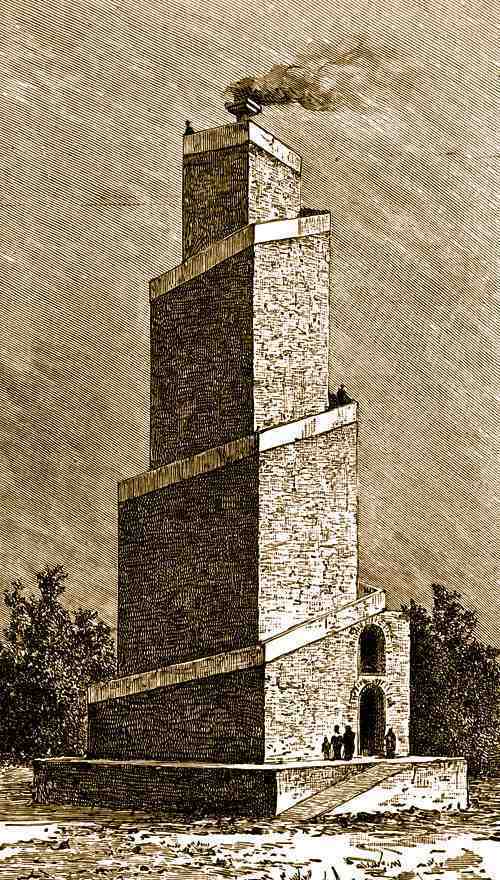 |
| With no more than his own attendant nobles, his elephants and camels
and household troops, Muhammad the Warrior left Samarkand. The Shah took
with him his treasure and his family. He intended to return at the head
of a fresh army.
Genghis Khan said, "The strength of a wall is neither greater nor
less then the courage of the men who defend it."
The swift, methodical preparations of the Mongols alarmed the Moslems
at Samarkand, who beheld in the distance the vast multitude of captives,
and assumed the horde was much larger than it actually was. The
Turkish garrison sallied out once and was drawn into one of the usual
murderous Mongol ambushes, and fared poorly, taking great losses. The
imams and judges went out and surrendered the city the following day.
Thirty thousand Kankali Turks on their own account went over to the
Mongols, were received amiably, given Mongol military dress and
massacred a night or so later. The Mongols would never trust the
Khwarezm Turks, especially those who turned traitor. |
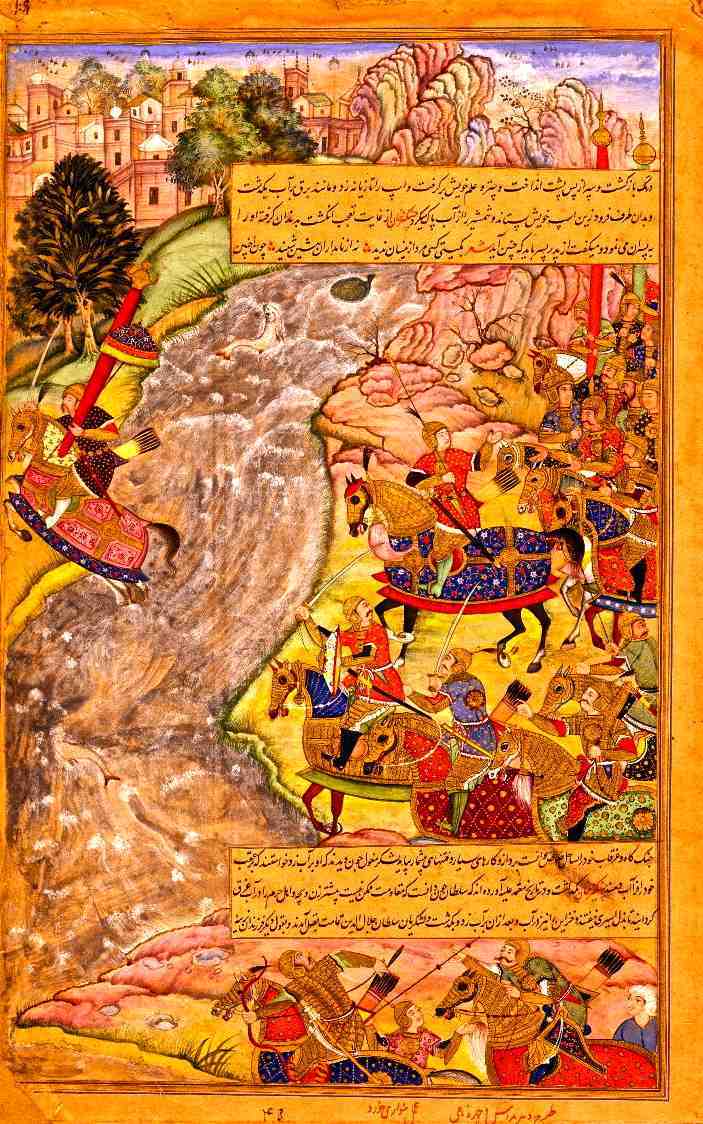
Khwarezm Shah Escapes Genghis Khan |
Not having found the Shah at Samarkand and hearing the story of his
flight, Genghis Khan called for his Orkhons Subotai and Chepe Noyon. He
ordered them, "Follow Muhammad Shah wherever he goes in the world. Find
him alive or dead. Spare the cities that open their gates to you but
take by assault those that resist. I think you will not find this as
difficult as it seems." They were given two tumans, twenty thousand men.
Every man of the two picked divisions had several horses in good
condition. They could cover eighty miles a day, changing to fresh horses
several times a day, and only dismounting at sunset to eat cooked food.
It was then April, 1220, the Year of the Serpent, in the calendar of the
twelve beasts.
Picking up the trail they followed the caravan route west toward the
Caspian, and scattered remnants of the Shah's armies fleeing the Mongol
terror. Near modern Teheran they met and defeated a Persian army, thirty
thousand strong.
Muhammad Shah had sent away his family and hidden his treasure, and
the numbers of his attendants and soldiers decreased each day. The
Mongols eventually found the treasure and almost caught him at Hamadan.
His men were scattered and ridden down. The Shah escaped, but some of
his Turkish warriors were rebellious. The wary Shah slept in a small
tent next to his own. One morning he found his own empty tent filled
with arrows.
"Is there no place on earth," the Shah asked an officer, "where I can
be safe from the Mongol thunderbolt?"
He was advised to take ship upon the Caspian to an obscure island
where he could be hidden until his eldest son, Jalal ed-Din, a favorite
of the Khwareszm army, could gather a host powerful enough to protect
the Shah. This Muhammad did. Disguising himself, and with only a few
nondescript followers, he passed through the gorges, seeking a small
town he remembered on the western shore of the Caspian Sea. It was a
tranquil place of fisherman and merchants. But the Shah, a man of ego,
though weary and ill, deprived of his court, his slaves and cup
companions, would not sacrifice |
| the prestige of his name. He insisted on reading the public prayers
in the mosque, and his identity did not long remain a secret. A
Muhammadan, who had suffered oppression at the hand of the Shah,
betrayed him to the Mongols who had scattered another Persian army at
Kasvin, and were questing after the Shah through the hills. They rode
into the town that had sheltered him, as he was preparing to board a
fishing skiff bound for his island sanctuary. Arrows were given flight,
but the boat drew away from the shore and some of the nomads in their
rage actually urged their horses into the water. They swam after the
skiff until the strength of men and beasts gave out and they disappeared
in the waves. The Khwarezm Shah, called Muhammad the Warrior, Overlord
of Islam, weakened by disease and hardship, died on his island, so
poverty ridden that his only shroud was a shirt off one of his last
followers. |
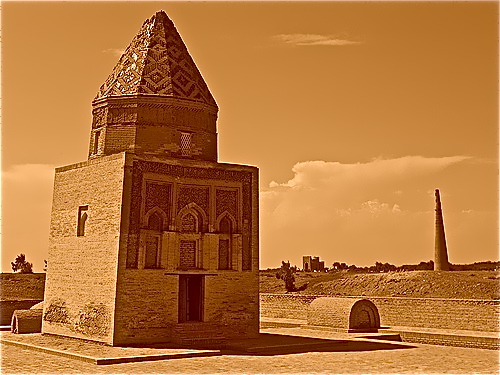 |

While the two divisions were raiding west of the Caspian
Sea in close pursuit of the fleeing Shah, two sons of the Khan journeyed
to the other inland sea, called the Aral. There they followed the wide
Amu River to the native city of the Khwarezms, Urgench. The Mongols
settled down to a long and bitter siege, in which, lacking large stones
for their casting machines, they hewed massive tree trunks into blocks
and soaked the wood until heavy enough for their purpose. |
| The desperate hand to hand fighting, once the walls were breached,
lasted within the city for a week. No garrisons abandoned this citadel
of fighters. The chronicles say the defenders used Flaming Naptha, a new
weapon that had been used with devastating effect against the crusaders
from Europe, the knights of the cross, in the Holy Land. Urgench
eventually fell, but Jalal ed-Din, the valiant son of the defeated Shah,
escaped to lead fresh forces against them. When the Mongols abandoned
the site of a city they trampled and burned whatever crops might be left
standing so that those who escaped their swords would soon starve to
death. But at Urgench, where the long, grueling defense had made the
Mongols suffer much, they actually went to the engineering trouble to
dam up the river above the citadel, altering it's natural course, so it
flowed over the debris of houses and walls. This abrupt changing of the
course of the Amu River puzzled geographers and scholars for centuries.
|
|
 |
| Genghis Khan was quite aware of his situation. He knew the real test
of strength was before him. He faced a Moslem Jihad, a holy war was
brewing. Perhaps a million men, good horsemen and exceedingly well
armed, were preparing to move against him. They mustered under their
natural leaders, the Persian princes and the sayyids, the descendants of
a warrior prophet. For the moment they lacked a leader and they were
scattered over a dozen kingdoms, but the Khan knew Jalal ed-Din was a
likely choice.
Genghis Khan ordered the horde forth, no longer to maneuver and
pillage with half indifferent contempt of the foe, but to destroy the
man power of the enemy. When they arrived in a district they drove
before them the peasantry, to the walls of a city they wished to take,
then used them to work the siege engines. Chieftains and nobles were
obliged to work beside their vassals at the war machines. Everyone who
did not obey was, without exception, put on the point of the sword.
It was Tuli, the youngest son of Genghis Khan, "Master of War", who
invaded the fertile provinces of Persia. He had been ordered by his
father to search for Jalal ed-Din, but the prince of Khwarezm evaded him
and the Mongol army marched against Merv, the jewel of the sands, the
pleasure city of the Shahs. It stood on the River of Birds, the Murgh Ab,
and sheltered in it's libraries many thousand volumes of manuscript. At
Merv, Tuli launched storm after storm against the walls, building an
embankment of earth against the rampart, covering the onslaught with
fights of arrows. For twenty-two days this continued. During a brief
lull, an iman went out from the city to parley. He was received with
courtesy and safely returned. |
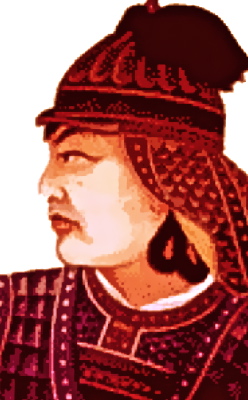
Tuli |
| The governor of Merv, a certain Merik, was reassured and went forth
to the Mongol tents with rich gifts of silver vessels and jeweled robes.
Tuli, the master of deceit, tutored by his father, had a robe of honor
sent to Merik, and invited him to his own tent to dine. At dinner he
convinced the Persian that he would be spared. "Summon then thy friends
and chosen companions," Tuli suggested, "I will find work for them to do
and will honor them." Merik dispatched a servant to bring out his
intimates, who were then seated beside the governor at the feast. Tuli
then asked for a list of the six hundred richest men of Merv, and the
governor and his intimates obediently wrote out the names of the
wealthiest landholders and merchants. Then, before the horrified Merik,
his companions were strangled by the Mongols. The list of six hundred
names, in the governors handwriting, was taken to the gate of Merv by
one of Tuli's officers, who demanded the persons in question. In due
course they appeared and were placed under guard.
The Mongols made themselves masters of the gate, and their bands of
horsemen pushed into the streets of Merv. All inhabitants were ordered
out into the plain with such possessions as they could carry. This
evacuation lasted four days. Tuli sat watching from his human skulls
throne upon a gilded dais. The Mongol officers singled out the leaders
of the Persian soldiery and brought them before him. While everyone
looked on helpless, the heads were cut from the officers of Merv. Then
the men, women and children were separated into three masses. The men
were forced to lie down, their arms across their backs. The Mongols
strangled or slashed the entire multitude to death, except four hundred
craftsmen and some children to be raised as slaves. The six hundred
wealthy citizens were tortured until they led the Mongols to where they
had hidden their most precious possessions.
The vacant dwellings were ransacked, the walls razed to the ground,
and Tuli drew off. In this fashion, one by one, other cities were
tricked and stormed. Genghis Khan now raged war carried to the utmost
extant. He would allow no mercy. "I forbid you," he said to his Orkhons,
"to show clemency to my enemies without an express order from me. Rigor
alone keeps such spirits dutiful. An enemy conquered is not subdued, and
will always hate his new master." Here, in the world of Islam, Genghis
Khan showed himself to be a veritable scourge. In this manner he had
quenched the rising tide of the Jihad holy war in it's infancy, before
it could form against him.
Other cities flared up for a time when the youthful sultan prince Jalal ed-Din
visited them and harangued them. But the squadrons of the Khan were soon
at their gates.
The fire of frenzy of the men of Islam had a leader, Jalal ed-Din, but
the center of their world now lay in ruins. Jalal ed-Din, who alone
could have held them together, and taken the field against the Khan, was
pursued by the Mongols and given neither time nor opportunity for
assembling an army. |
|

There was little time for anything except action that
fateful autumn in 1221. The cities rose against the conquerors and Jalal
ed-Din was reported to be mustering a new army in the east. Genghis Khan
dispatched Tuli with several divisions to quell the uprising. The fate
of
Herat was not less hideous than that of Merv. Genghis
Khan took the field with the Mongol center, sixty thousand strong, to
find and destroy the new Khwarezm army. In the Khans path lay the city
of Bamiyan in the Koh-i-Baba ranges. The Khan settled down to a siege,
sending the greater part of his force under command of another Orkhon to
meet Jalal ed-Din. |
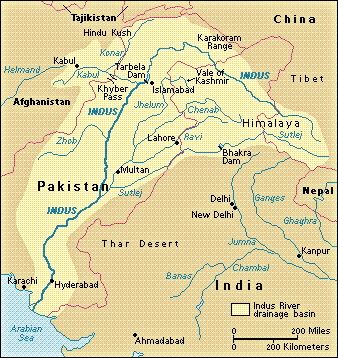 |
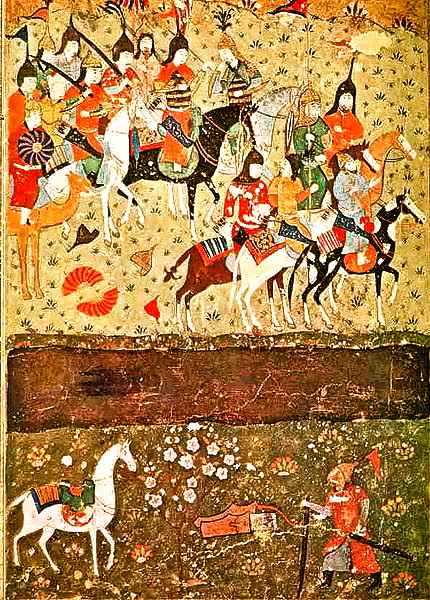
Battle of the Indus |
Word came that Jalal ed-Din had sixty
thousand warriors with him, and the Mongol general had avoided several attempts by Jalal ed-Din to ambush him.
Scouts were watching the movements of the prince. The formidable Afghan
Pathan warriors had joined with Prince Jalal ed-Din in this crisis,
doubling his strength. Word came in shortly that the Turks and Afghans
had defeated the Mongol general, driving his men into the mountains.
The Khan went into a terrible rage over the news and ordered upon
Bamiyan the "Mongol Storm" that is not to be abandoned until the city is
taken. One of the Khan's grandsons was killed in the attack. The Khan
himself, then at the head of the attack, forced a breach and the city
soon fell. Every living being was slain within it's walls, and mosques
and palaces pulled down. Even the pitiless Mongols spoke of Bamiyan as
Mou-baligh, the "City of Sorrow".
The Khwarezm Prince,
Jalal ed-Din, was as weak in victory as he had
been strong in defeat. He had his moment of exultation when his men
tortured to death the Mongol prisoners and divided up the captured
horses and weapons, but the Afghan warriors quarreled with his officers
and left him.
Genghis Khan was on the march against him, after detaching divisions
to watch the movements of the Afghans. Jalal ed-Din retreated east to
Ghazna, but the Mongols were hard after him. He sent messengers to
summon new allies, but these found that the Mongols had guarded the
mountain passes. With his thirty thousand men Jalal ed-Din hurried down
through the foothills and out upon the valley of the Indus.
He planned to cross the river and league himself with the sultans of
Delhi. But the Mongols, who had been five days behind him at Ghazna,
were now within a half a days ride. Desperate now, Jalal ed-Din
discovered he had come to the Indus River at a location too swift and
deep for crossing. The Khwarezm Prince turned at bay, his left flank
protected by a mountain ridge, his right by a bend of the river. |
| The chivalry of Islam, hunted out of it's own lands, prepared to
measure it's strength against the inexorable Mongol. Jalal ed-Din
ordered all the boats along the banks to be destroyed, so his men could
not think of fleeing. His position was strong, but he must hold it or be
annihilated.
The Mongols emerged at dawn, out of the darkness, in formation.
Genghis Khan with his standard, and the ten thousand cavalry of the
imperial guard, in reserve, behind the center. The Prince of Khwarezm
was first afield, launching his strongest division, the right wing,
under Emir Malik. They drove home a charge that forced the Mongol left
flank back at that point. On their right the Mongols had been checked by
the lofty, barren ridges.
Jalal ed-Din, determined to risk everything on one cast of fortune,
and charged with the elite of his host straight into the Mongol center,
cutting through to the standard, seeking the Khan. But Genghis Khan's
horse had been killed under him, and he mounted another and went
elsewhere. The Mongol center, badly shaken by the charge fought on
stubbornly.
Genghis Khan had ordered a tuman commander, Bela Noyon, to execute
the Mongol turning movement, against the Khwarezm left wing. Bela Noyon
and his men followed guides into sheer gorges and ascended cliff paths
that seemed impassable. Some warriors fell into the chasms. The greater
part survived to the ridge late in the day, and descended on the men
Jalal ed-Din had left to protect that point. Over the mountain barrier
the Khwarezm flank was turned. Bela Noyon charged into the enemy
formation.
Meanwhile, Genghis Khan had taken leadership of his ten
thousand imperial cavalry, and had gone not to the menaced center, but
to the defeated left wing. His charge against Emir Malik's forces routed
them. Wasting no time in following up, the Khan swung his squadrons
about and drove them against the flank of Jalal ed-Din's troops at the
center. The end came swiftly now, inexorably.
Jalal ed-Din made a last hopeless charge against the horsemen of the
imperial guard, and tried to withdraw his own men toward the river. He
was followed up, his squadrons broken, Bela Noyon pressed in upon him,
and when at last he gained the steep band of the Indus he had no more
than seven hundred followers. Realizing the end had come, he mounted a
fresh horse, rid himself of armor, and with only his sword and bow, and
a quiver of arrows, he forced his charger over the edge of the bank,
plunging into the swift current, and making for the distant shore.
Genghis Khan had given orders that the prince was to be taken alive.
The Khan lashing his horse through the fighting had seen the rider and
horse leap from the twenty foot bank. The Khan watched Jalal ed-Din
reach the far bank despite currents and waves. "Fortunate should be the
father of such a man.", the Khan remarked. The Khan admired the daring
of the prince but did not intend to spare him. The next day he sent a
division in pursuit where the river could be crossed, giving the task to
Bela Noyon, who ravaged Multan and Lahore, picking up the trail of the
fugitive, but lost him in the multitudes upon the way to Delhi.
The oppressive heat astonished the men from the Gobi plateau and they
turned back saying to the Khan, "The heat of this place slays men, and
the water is neither fresh nor clear." So India, except for the north,
was then spared the Mongol conquest. |
| The battle of the Indus was the last stand of the Khwarezm chivalry.
From Tibet to the Caspian Sea all resistance had ceased, and the
survivors of the peoples of Islam had become the slaves of the
conqueror. Jalal ed-Din survived, but his moment had passed. He fought
against the horde again, but as a partisan, an adventurer without a
country. Finally, in the early years of Ogotai's reign a Mongol general,
Charmagan, defeated Jalal ed-Din and put an end to him forever. Charmagan went on to consolidate the regions west of the Caspian Sea,
such as Armenia. At the same time, Subotai Bahadur and Tuli advanced far
south of the Hoang Ho and subdued the remnants of the Chin Empire.
|
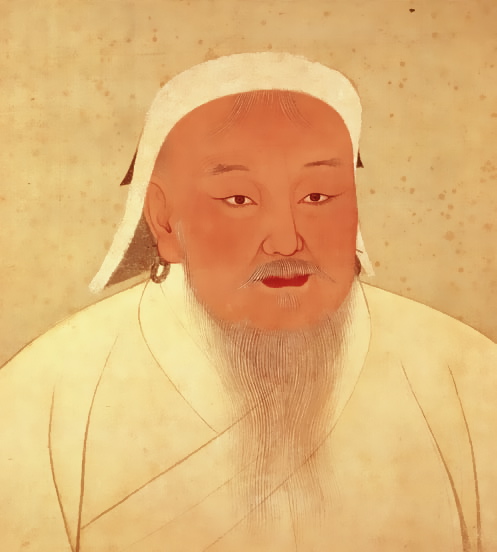 |
 |
| In the year 1227, the "Year of the Mouse" in the calendar of the
twelve beasts, like the nomad chieftain he was, Genghis Khan died
without complaining. A long sickness had drained his life away. He
dispatched couriers to his nearest son, Tuli. When the Master of War
reached the yurt of the Khan his father greeted him, "It is clear to me
that I must leave everything and go hence from thee." Tuli, was to take
dominion over all lands in the east and complete the on-going conquest
of the southern Sung Dynasty in Khitai (China). Chatagai was to
administer and complete the conquest of the west. Ogotai was placed
supreme over all, the Kha Khan at Karakorum. A nomad to the end, he left
to his sons the greatest of Empires and the most destructive military
force, as if his possessions had been no more than tents and herds. His
first born son, Juchi, had died shortly before the death of the Great
Khan himself.
Genghis Khan clearly understood that his new Empire could be held
together only by submission to the authority of one man. He had chosen
not the warlike Tuli, or the inflexible Chatagai, but instead the
generous and guileless Ogotai as his successor. Keen understanding of
his sons had dictated this choice. Chagatai, now the eldest, would never
have submitted to the youngest son, Tuli, and the Master of War would
not have long served his harsh older brother.
Genghis Khan took from the world what he wanted for his sons and his
people. He did this by war, because he knew no other means. What he did
not want he destroyed, because he did not know what else to do with it. |
|
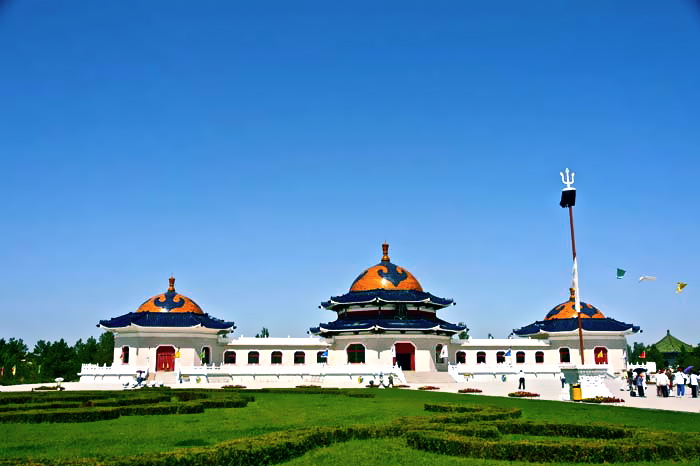
Genghis Khan's Tomb
at his Palace (pictured)
on the Ordos Plateau, but it only contains his personal effects, not his
remains
Legend has it that Genghis Khan is entombed in a spot so
secretive that anyone who even came near his funeral procession was
killed. The 800 horsemen who trampled his gravesite to keep its location
secret were, in turn, executed, along with the 1,000 laborers who
escorted his body and dug his final resting place.
Yet the search for his remains continues, using
advanced ground
visualization techniques that
not even the Great Khan, renowned for
incorporating the technologies of the countless people he conquered into
his war machine, could not have imagined. |
|
 |
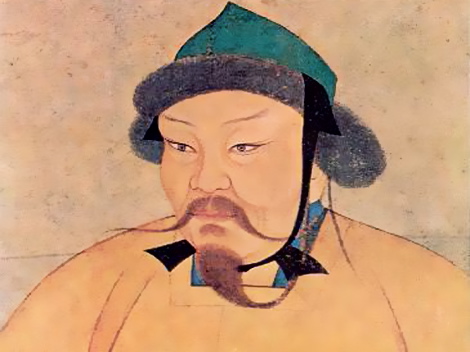
Ogotai Kha Khan |
Ogotai Kha Khan, the son that succeeded to the throne of the
conqueror found himself an almost unwilling master of half the world.
Ogotai had all the Mongol's good humor and tolerance, without the
cruelty of his brothers. He could sit in his tent-palace at Karakorum
and do nothing except listen to the throngs who came to bow down at the
throne of the Khan. His brothers and officers carried on the wars, and
Ye Liu Chutsai saw to the gathering of the revenues.
Ogotai, broad of body and placid of mind, presents a curious picture.
He was a benevolent barbarian in possession of the spoils of empires.
His actions were uniquely un-king-like. When his officers protested at
his habit of giving away whatever he happened to see, he replied that he
would soon be gone out of the world and his only abiding place would be
in the memory of men.
He did not approve of the treasures amassed by the Persian and
Indian monarchs. "They were fools," he said, "and it did them little
good. They took nothing out of the world with them."
Muhammadan merchants presented inflated bills of account before the |
| Khan every evening. Once the nobles in attendance protested to
Ogotai that the merchants were overcharging him ridiculously. Ogotai
agreed, "They came expecting to profit from me, and I do no wish them to
go away disappointed."
Once, a certain Buddhist came to the Khan with a story that Genghis
Khan had appeared before him in a dream, and had voiced a command, "Go
thou and bid my son exterminate all believers in Islam, for they are an
evil race." The severity of the dead conqueror toward the followers of
Muhammad was well known, and a "Yarligh", a command from the Great Khan
delivered in a vision was an important matter.
Ogotai meditated. "Did Genghis Khan address thee by the words of an
interpreter?", he asked at length. "Nay O Khan, he himself spoke." And
thou knowest the Mongol speech?", persisted Ogotai. It was evident the
man of vision spoke only Turki.
"Then thou hast lied to me," retorted the Khan, "for Genghis Khan
spoke only Mongol." And Ogotai Khan ordered the antagonist of the
Muhammadans to be put to death. |
|
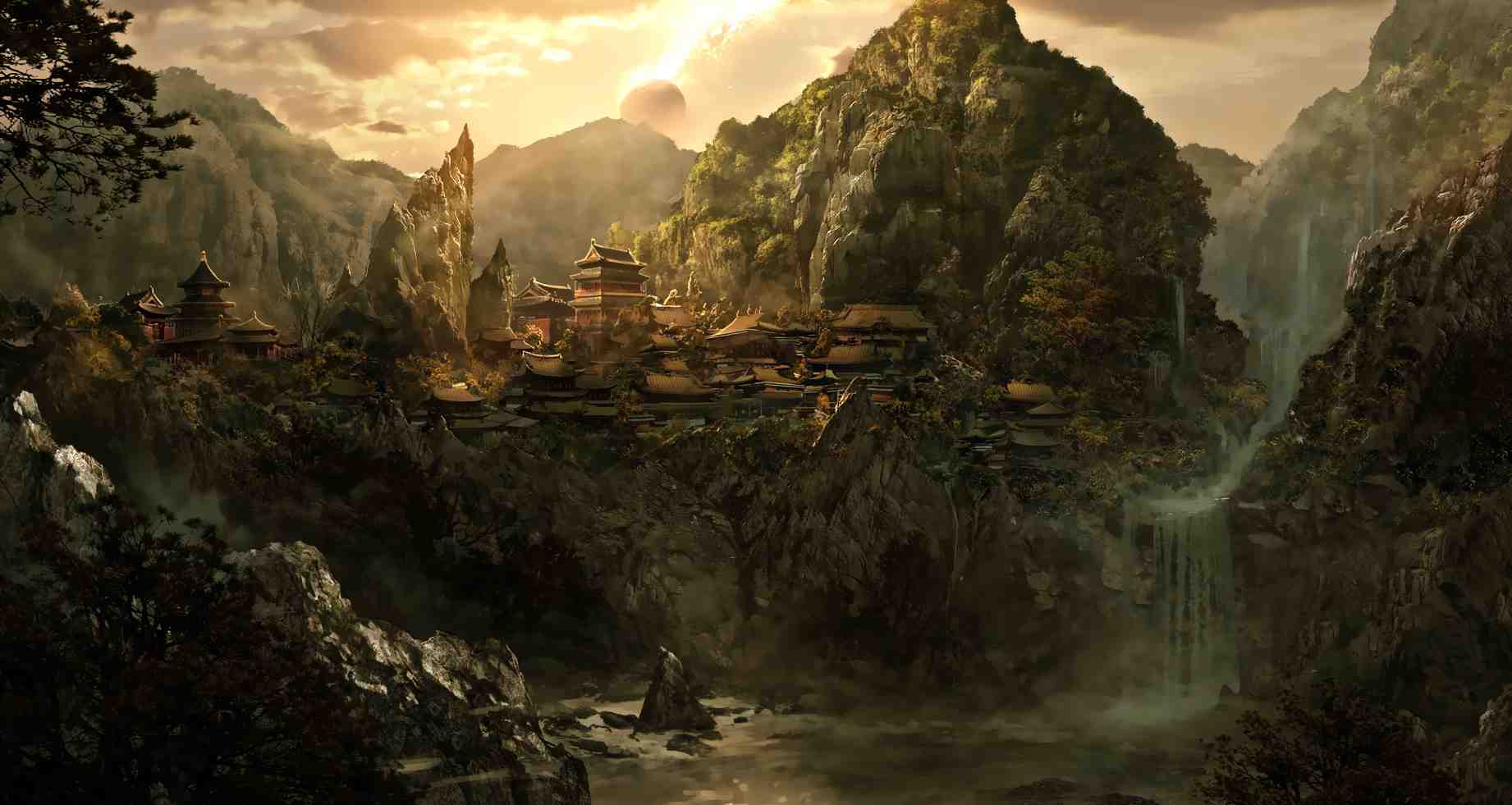 |
| The sons of the Orluks would constitute the second and third great
waves of Mongol conquest. Batu, son of Juchi, founded the "Golden Horde"
that crushed Russia. Chatagai, inherited Central Asia, and his
descendant, Babar, the "Tiger", was the first of the great Moghuls of India. Tuli's
son Kublai reigned from the China Sea to mid-Europe. Genghis Khan once
remarked upon his young grandson Kublai, "Mark well the words of the
boy Kublai, they are full of wisdom." In 1235 Ogotai held a council,
and it resulted in the second wave of Mongol conquest. Batu, first
Khan of the Golden Horde, was sent with Subotai into the west, to the
sorrow of Europe as far as the Adriatic and the gates of Vienna. Other
armies took the field in Korea, China and southern Persia. This wave
withdrew upon the death of Ogotai in 1241.
|
|
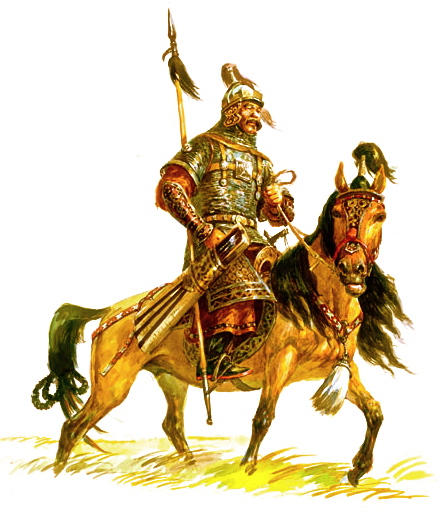 |
 |
| The test of strength between Mongol and European did not come during
the lifetime of Genghis Khan. It followed the great council of 1235, in
the Khanship of Ogotai. Batu, the son of Juchi, marched west with the
Golden Horde. From 1238 to 1240 Batu the "Splendid" overran the Volga
Clans, Russian cities and the steppes of the Black Sea, finally storming
Kiev. Raiding columns entered Ruthenia (Poland). |
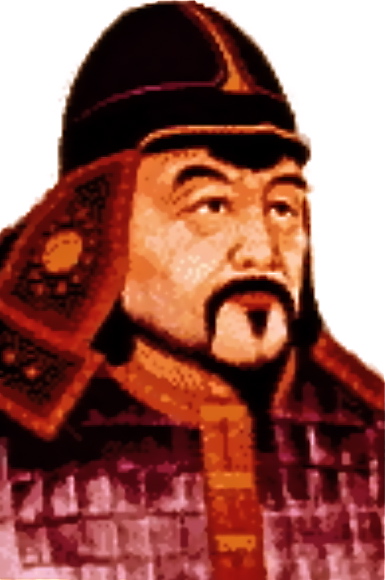
Subotai Bahadur |

When the snows melted in March, 1241, the Mongol
headquarters was north of the Carpathians between modern Lemberg and
Kiev. Subotai, the directing genius of the campaign, was confronted by
several enemies.
In front of him Boleslas the Chaste, overlord of Poland,
had assembled his host. Beyond, to the north, in Silesia, Henry the
Pious was gathering an army thirty thousand strong of Poles, Bavarians,
Teutonic Knights and Templars out of France, who had volunteered to
repel this invasion of barbarians. A hundred miles or so behind Boleslas,
the king of Bohemia was mobilizing a still larger force, receiving
contingents from Austria, Saxony and Brandenburg. On the
left front of the Mongols, Mieceslas of Galicia and other lords were
preparing to defend their lands in the Carpathians. On the Mongol left,
further away, the Magyar host of Hungary, a hundred thousand strong, was mustering under the banner of King Bela IV, beyond the Carpathian Mountains. |
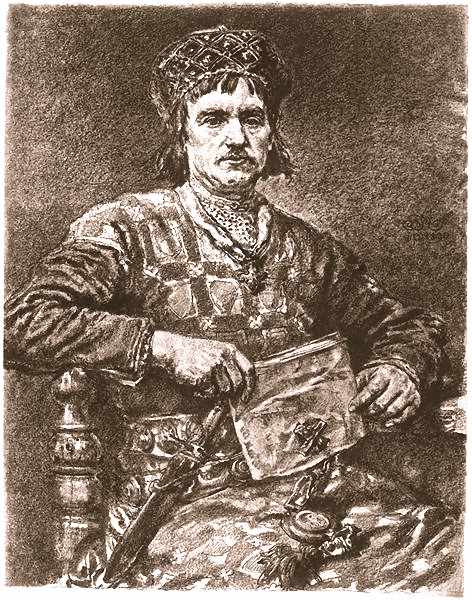
Boleslas the Chaste |
Batu acted as soon as the ground was dry enough for his horses to
move over. He divided his host into four army corps. He sent the
strongest against the Poles, under two reliable
generals, grandsons of
Genghis Khan, Kaidu and Baibars.
This division moved rapidly west and encountered the forces of
Boleslas on March 19th, 1241, as the Poles were pursuing some scouting
contingents of the Mongols. The Poles attacked with their usual bravery
and were defeated. Boleslas fled into Moravia and the remnants of his
army ran north.
Cracov was burned, and the Mongol forces of Kaidu and Baibars
hastened on to meet the Duke of Silesia before he could join forces with
the Bohemians.
They encountered this army of Henry the Pious near Liegnitz, on April
ninth. |
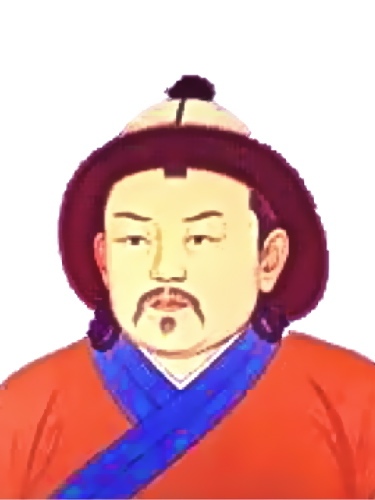
Batu Khan |
|
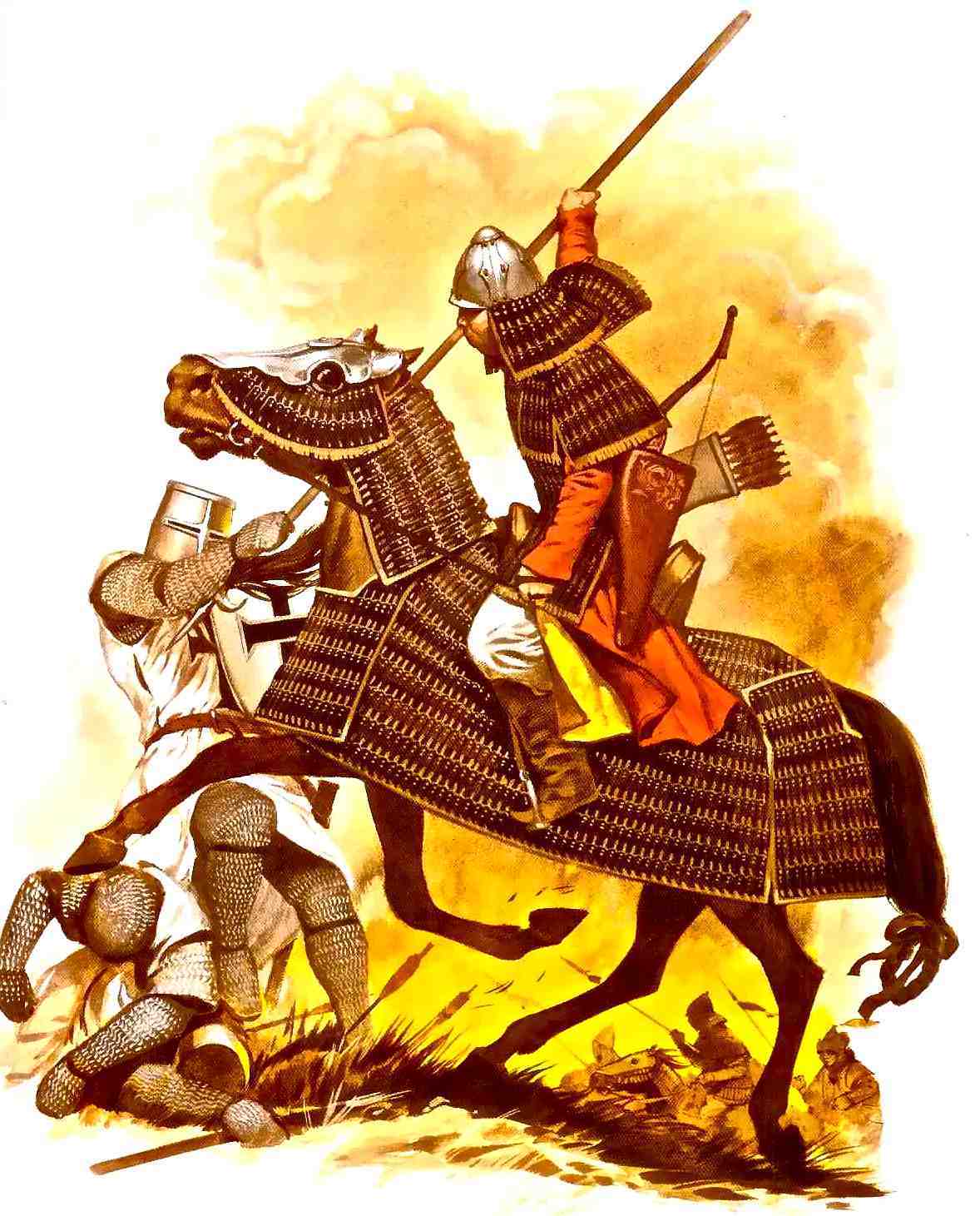
Mongol Heavy Cavalry, Liegnitz, 1241 |
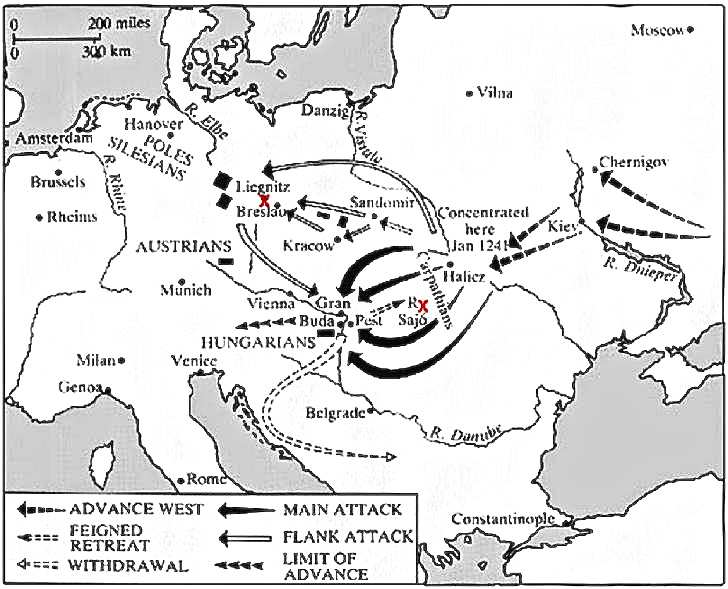 |
The German and Polish forces broke before the incredible onset of
the Mongol standard, and were almost exterminated. Henry the Pious and
his Barons died to a man, as did the Knights Hospitalers of Saint John.
It is said the Grand Master of the Teutonic Knights perished on the
field, with nine Knights Templars, and five hundred men-at-arms.
Liegnitz was burned by its defenders, and the day after the battle Kaidu
and Baibars, and their division, confronted the larger army of
Wenceslas, King of Bohemia, fifty miles away.
Wenceslas moved slowly from place to place, as the Mongols appeared
and disappeared. His cumbersome host, too strong to be attacked by the
Mongol division, could not come up with the horsemen from the Gobi. The
Mongols ravaged Silesia and Moravia before his eyes, and finally tricked
him into marching north while they turned south to rejoin Batu.
Ponce d'Aubon, the Master of the Templars, wrote to Saint Louis of
France, "All the barons of Germany and the King, and all the |
| clergy and those in Hungary have taken the cross against the Tatars
(Mongols). And if they are vanquished by the Tatars, there is no one to
stand against them as far as your land." The Templar Master did not
realize that as he wrote his message the Hungarian army was already
destroyed. Subotai and Batu threaded through the Carpathian Mountains
in three divisions. The right flank entering Hungary from Galacia, the
left, under command of Subotai, swinging down through Moldavia. The
smaller armies in their path were wiped out, and the three columns
joined forces before King Bela and his Hungarians, near Pesth. |
|
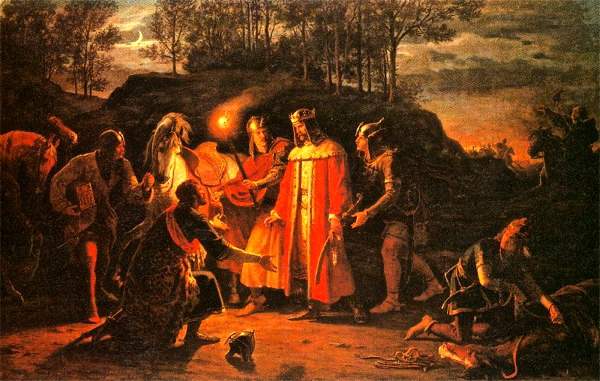
King Bela IV of Hungary |
| King Bela began to cross the Danube River with his massive army of
Magyars, Croats and Germans, with the French Knights Templars who had
been posted in Hungary. Roughly one hundred thousand strong in all. The
Mongols retreated slowly before the host at a regular pace. Batu,
Subotai and Mangu, the "Conqueror of Kiev", had left the army to inspect
the site chosen for the battle. The plain of Mohi, hemmed in on four
sides, by the river Sayo, by the vine-clad hills of Tokay, by dark
woods, and by the great hills of Lomnitz. |
|

The Mongols retreated across the Danube, leaving intact a wide stone
bridge, and pushing into the brush on the far side for some five miles.
Blindly the vast host of King Bela plodded behind them, and camped upon
the plain of Mohi. Camped with the heavy baggage, it's
sergeants-at-arms, it's armored chivalry and the multitude of followers.
A thousand men were posted on the far side of the bridge, and other
troops explored the woods without seeing a sign of the enemy. |
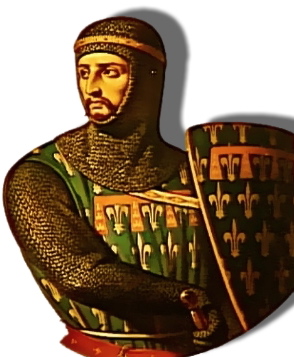 |
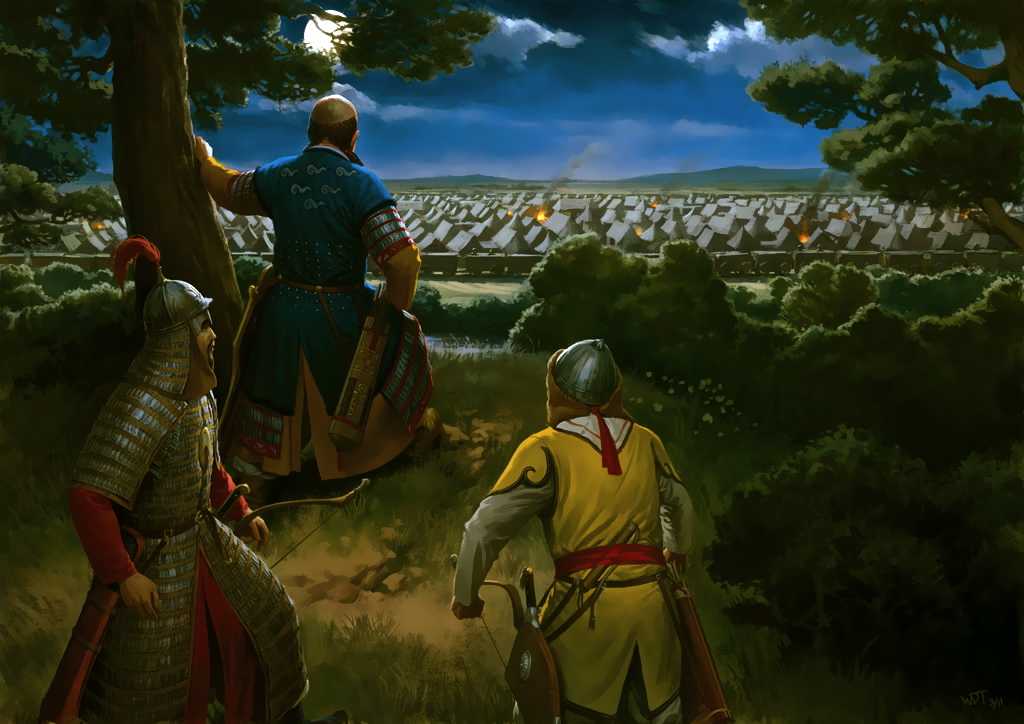 |
The blackness of the night arrived and Subotai took command of the
Mongol Right Wing, led it in a wide circle back to the river where he
had observed a ford, and set to work building a bridge to aid in the
crossing.
The break of dawn. Batu's advance moved back toward the bridge,
surprised and annihilated the detachment guarding it. Batu's main forces
were thrown across, while seven catapults played havoc on King Bela's
knights, who tried to stem the rush of horsemen across the bridge.
The Mongols surged steadily into the disordered array of their foes,
the terrible standard of the nine yak-tails surrounded by the smoke of
fires carried in pans by shamans. "A great gray face with a long beard,"
a European survivor described it, "giving out noisome smoke."
There is no doubting the stout bravery of King Bela's paladins. The
battle was stubborn and unbroken until |
|
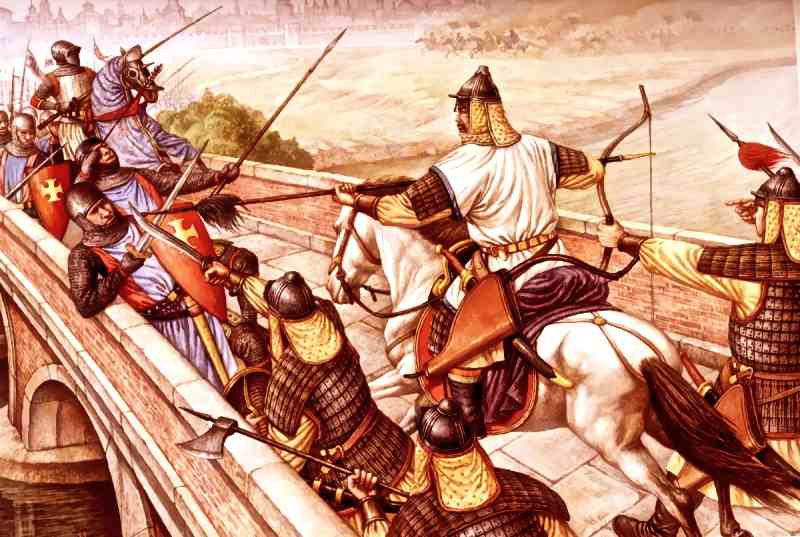 |
| near mid-day. Then Subotai completed his flank movement, and
appeared behind King Bela's formations. The Mongol cavalry charging in
broke the Hungarians. Like the Teutonic Knights at Liegnitz, the Knights
Templars died to a man on the battlefield.
The Mongol ranks parted in the west, leaving open the road through
the gorge by which the host of King Bela had advanced to the plain of
Mohi. The Hungarians fled, and were pursued at leisure. For two days
journey the bodies of Europeans strewed the roads. |
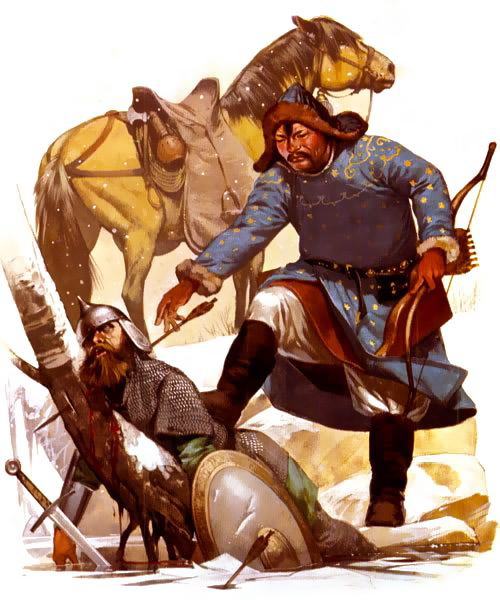 |
Forty thousand had fallen. King Bela separated from his remaining
followers, leaving his brother dying, the Archbishop slain. By sheer
speed of desperation and horse he freed himself from the pursuit, hid
along the bank of the Danube River, was hunted out and fled into the
Carpathian Mountains. There, in time, he reached the same monastery that
sheltered his brother monarch from Poland, Boleslas the Chaste. The
Mongols stormed Pesth, and fired the suburbs of Gran. They advanced into
Austria as far as Nieustadt, avoided the sluggish host of Germans and
Bohemians, and turned down to the Adriatic Sea, ravaging the towns
along the coast.
In less than two months the Mongols under Subotai and Batu had
overrun Europe from the headwaters of the Elbe to the sea. They had
defeated three great armies and a dozen smaller ones. They had taken by
assault all the towns except Olmutz, which made a good defense under
Yaroslav of Sternberg with twelve thousand men.
Europe faced inevitable disaster. It's armies, capable only of moving
in a mass, led by reigning monarchs as incompetent as King Bela or Saint
Louis of France, were valiant enough but utterly unable to prevail
against the rapidly maneuvering Mongol contingents. These divisions were led
by marshals and generals such as Subotai and Mangu and Kaidu, veterans
of a lifetime of war on two continents.
Ultimately, the war never came to a conclusion. A courier arrived
from Karakorum, the Black Sands, the Mongol Capital of an Empire. The
courier carried the "Kurultai", |
| the summons that cannot be ignored, calling them back to the Gobi
Desert. The courier also carried grim tidings, Ogotai, the Kha Khan, was
dead and a council was to be convened. And so the horde withdrew and
traveled thousands of miles on the journey home. |
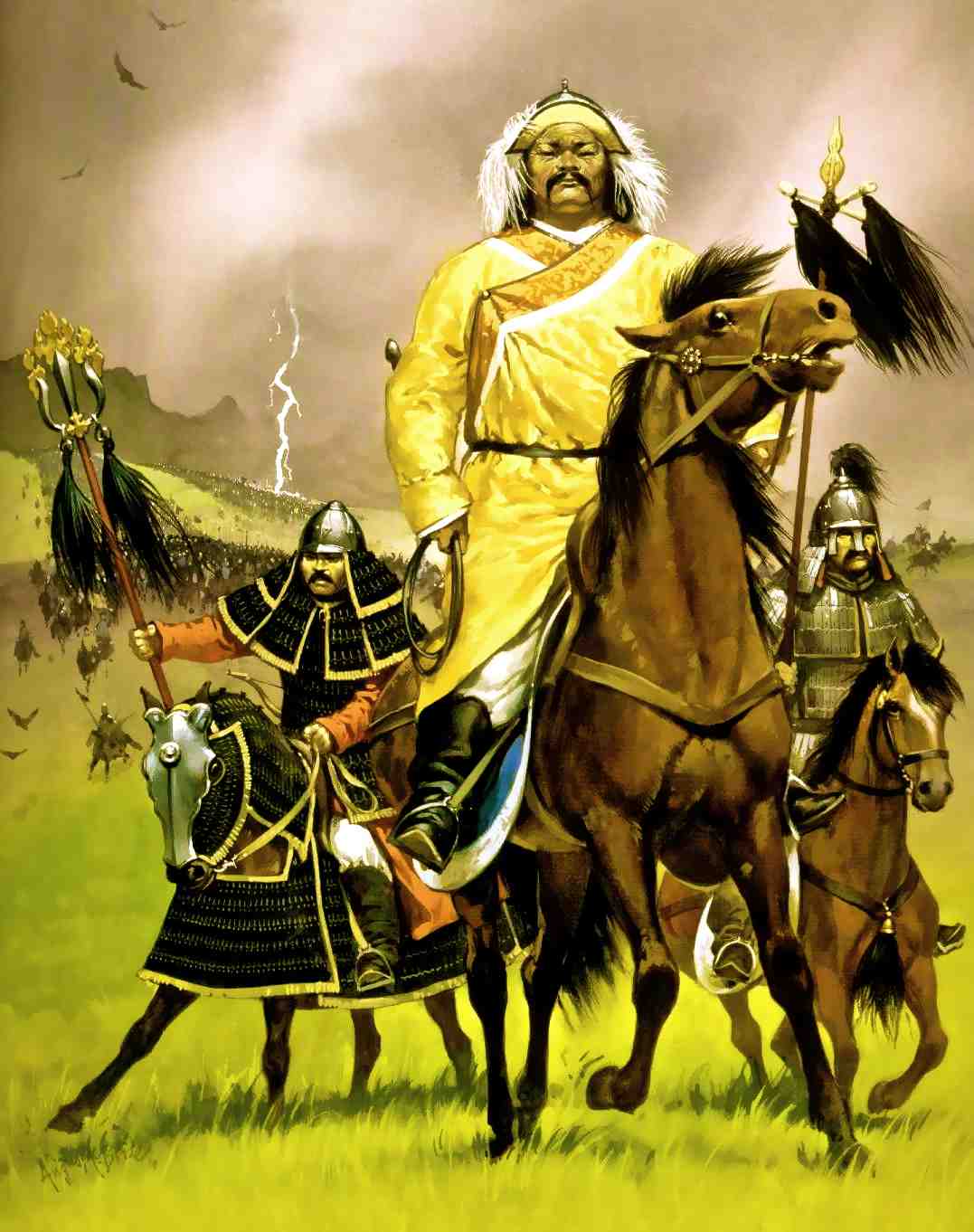 |
After the Mongol invasion of Europe Pope Innocent the IV sent envoys
to the Baichu near the Caspian. These emissaries offended the Mongols
very much because they did not know the name of the Khan, and because
they lectured the pagans on the sin of shedding blood. The Mongols
said the Pope must be very ignorant if he did not know the name of the
man who ruled all the world, and as for slaughtering their enemies, they
did that at the command of the son of Heaven himself.
At Nieustadt in Austria, the Mongol horde had advanced nearly six
thousand miles from their homeland. Subotai and the fierce Tuli died not
long after their return to the Black Sands. Batu was content with his
golden city on the Volga. The westward march of the Mongols came to an
end. |
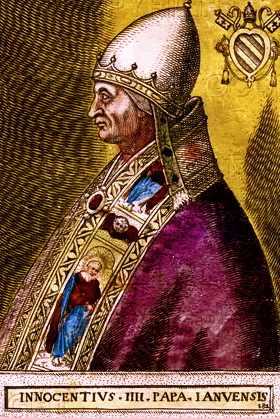 |
|
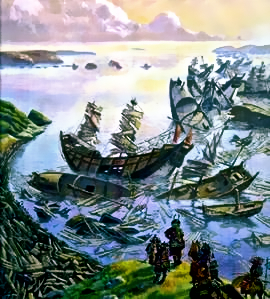 |
 |
|
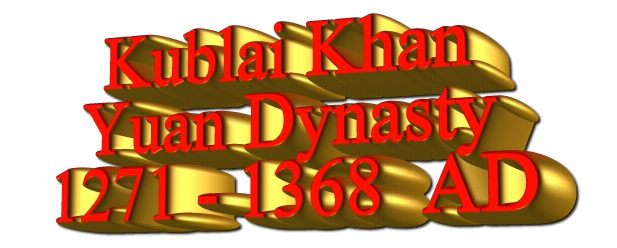
Kublai Khan was the greatest of the Mongol emperors
after Genghis Khan himself
and was the founder of the Yüan Dynasty
Kublai Khan was the fourth son of Genghis Khan's youngest son, Tuli, and
brother of the fourth Great Khan, Mangu, and the grandson of Genghis Khan
(1165–1227), the founder of the Mongol Empire. Kublai's mother was a
fervent Nestorian Christian. Strong, brave, and
intelligent, Kublai was Genghis Khan's favorite grandson. Kublai had
accompanied his father, Tuli, in battles as a child and by the age of
twelve he was a skilled horseman, and his reputation as a warrior grew
as he became older.
|
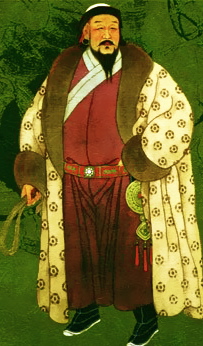
Kublai Khan (1215-1294) |
Upon the death of the
Kha
Khan Ogotai, in 1241, there followed ten
years of cross-purposes and a growing feud between the house of
Chatagai
and that of
Ogotai. Then the rule passed from the house of Ogotai to the
sons of Tuli - Mangu and Kublai.
And the third and most extensive wave
of Mongol conquest swept the world!
When
Kublai was in his 30s, his brother, the emperor Mangu, gave him the
task of conquering and administering the Sung Dynasty. Kublai was still
on the banks of the Yang-tse River when the report of Mangu's sudden
death, in a religious battle between Buddhists and Taoists, spread
through China, in that hot midsummer of 1259. Kublai had with him the
Sage Yao Chow and the famous Left Wing of the army. Kublai then attained
the throne and became Great Khan or Kha Khan, the ruler of the Mongol
Empire. A red hat lama, called out of Tibet to preside at the coronation
of Kublai, brought with him out of his mountains the hierarchy of the
priests of Lhassa. Kublai Khan's reign was the golden age of the
Mongols.
But Kublai Khan departed from the customs of his fathers, moved the
court to Cathay (China), and made himself more a Chinese in habits than a
Mongol. As a result, his other brothers did not recognize his position,
because he had adopted the Chinese culture. They disregarded Genghis
Khan's warning to his heirs to remain united under one Great Khan, and
the unity of the Mongolian Empire soon ended. The seeds of the Mongol
Empire's dissolution were already prevalent. The Il-Khans of Persia (Hulagu's
descendants, who reached their greatest power under Ghazan Khan about
1300), were at too great a distance from the Kha Khan Kublai to be in
touch with him. Besides, they were fast becoming Muhammadans. Such,
also, was the situation of the Golden Horde up Russia way. Meanwhile,
Kublai's Mongols were being converted to Buddhism. |
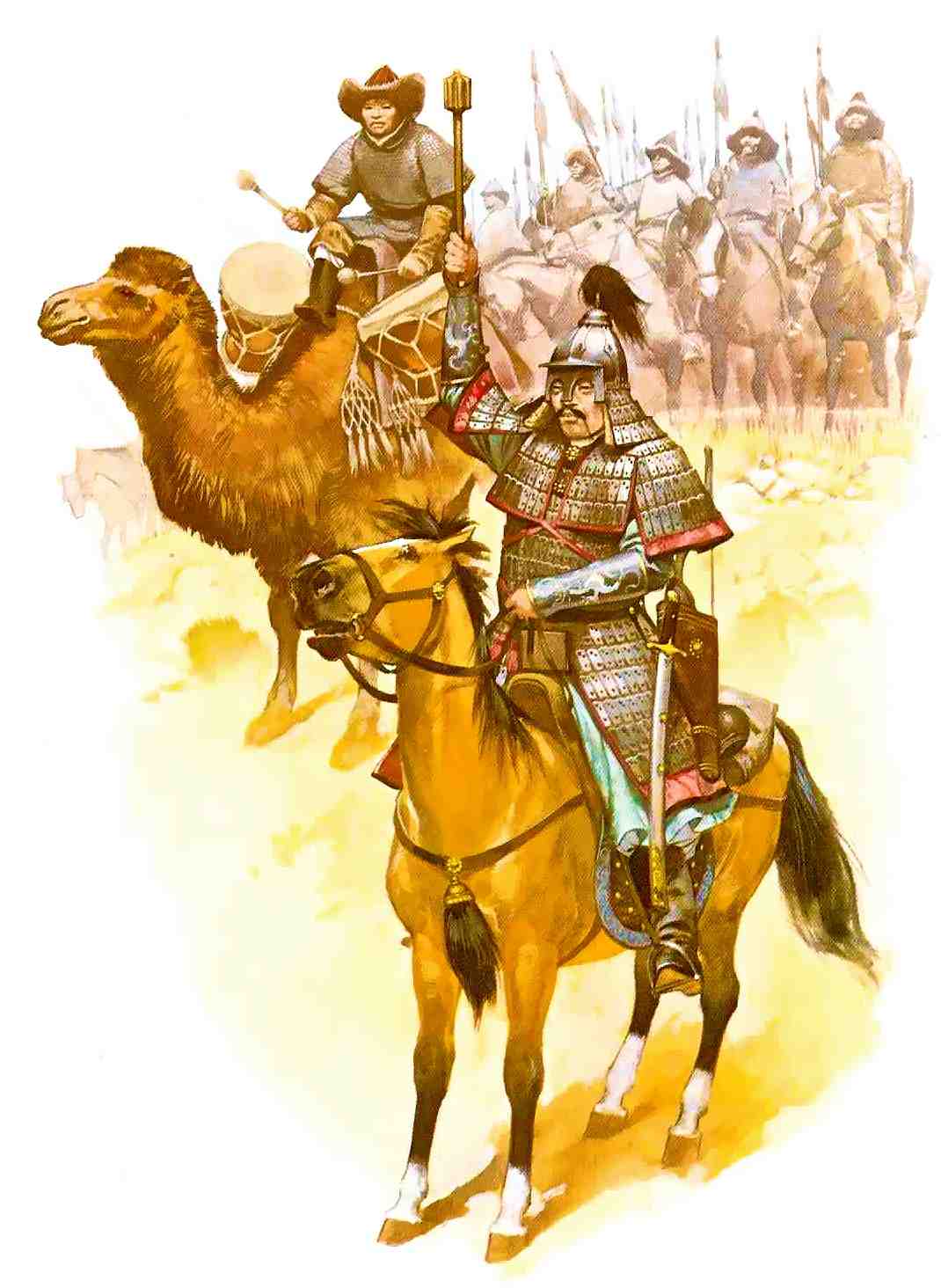 |
| In 1276, not long after the founding of the
Yuan Dynasty, the only
foreign dynasty that ever ruled all of China, Kublai Khan led his army
against the capital of the southern Sung Dynasty. Kublai Khan defeated
the Sung Dynasty by
1279, completing the conquest of China, a task begun
when his grandfather, Genghis Khan, in 1211, began raiding the Chin
Dynasty in Northern China. After forty years of warfare, Kublai Khan's
armies finally ended the more than three hundred year reign of the Sung
Dynasty in China. For the first time since the fall of the Tang Dynasty
in the tenth century, the whole of China was united under a single
ruler. For the first time in China's entire history, the Middle Kingdom
was under foreign rule. The territory of the Yuan Dynasty now stretched
to Mongolia and Siberia in the north, the South Sea in the south, Yunnan
Province and Tibet in the southwest, eastern part of Xinjiang Province
in the northwest and the Stanovoi Range in the northeast. The total area
of the country was over 4.6 million square miles. Kublai Khan had
destroyed the Sung Dynasty and was now the unquestioned leader of an
empire that stretched across two continents. |
|
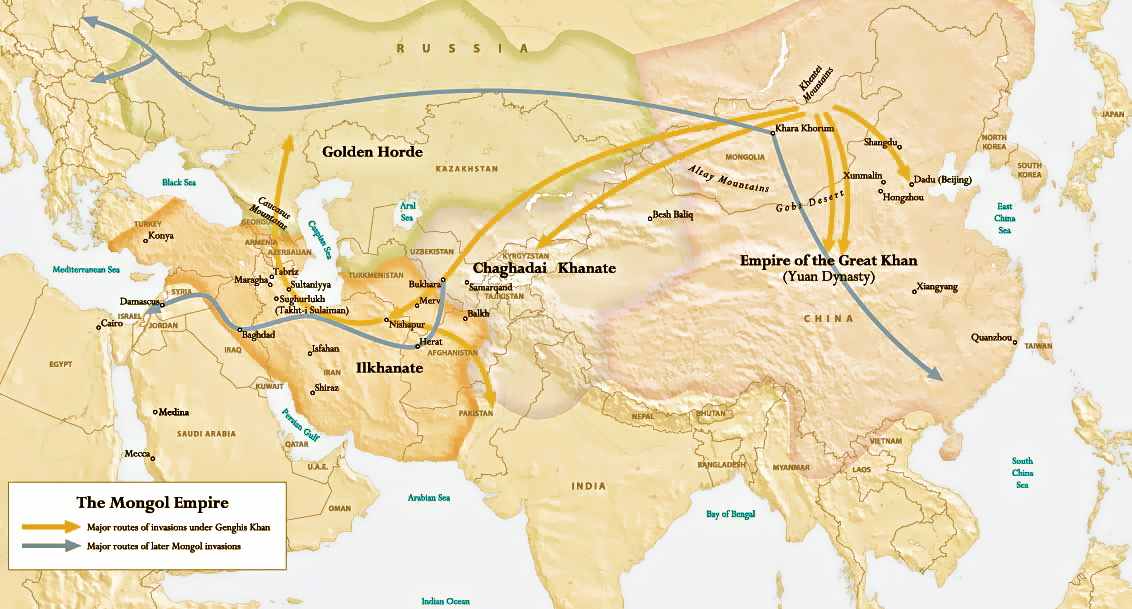 |
|
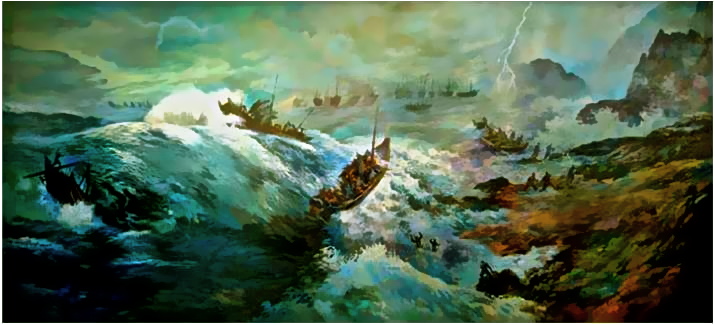 |
|
 |
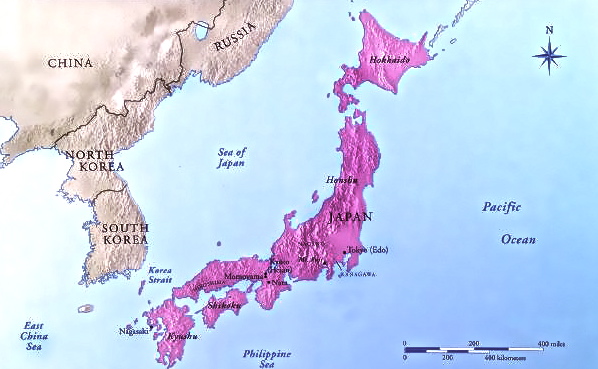 |
The History of Japanese and Chinese animosity is very old. Over the
centuries the Chinese have always been at the receiving end of the
Japanese swords. But there was a time when China did attempt an invasion
of Japan. This was the period when the Mongols ruled China.
In the 13th century,
Kublai Khan, grandson of Genghis Khan, known as the
Mongol Emperor (Yuan Shi-zu) who founded the Yuan Dynasty of China,
envisioned to succumb Japan and incorporate it as a tributary state. In
1274 and 1281 armies were dispatched from the Korean peninsula and China
in attempts to land on Japan. The Yuan armies were made up of Mongol,
Korean and Chinese soldiers.
The two
Mongol invasions of Japan
of represent a defining moment in
Japanese history - the 'finest hour' of the Samurai, and the birth of
the legend of the kamikaze, or
'Divine Wind', the typhoons that swept
away the Mongol invasion fleets. |
| In 1268 a group of islands, little-known, were called the "Place of
the Sun's Rising" (Jih pen kuo in Chinese, which we now pronounce as
"Japan"), and 'Nippon' in the native speech of the islanders. Korean
merchants told Kublai Khan that the palaces of Nippon were plated with
gold, while large rose-tinted pearls were drawn form the Nippon seas.
Kublai Khan dispatched envoys from Tai-tu to the
Japanese Islands
with a
conciliatory message: "The Mongol power will be kind to you. It does not
desire your submission, more than that you should become part of the
great Mongol Empire." The feudal and courageous warriors of Nippon did
not even receive the envoys of the Khakhan. Again in 1271, envoys were sent to Nippon with similar messages
and results. At this time, Kublai Khan was
waging war simultaneously against the southern Sung Dynasty and Koryo
(modern Korea). When Koryo's King Kojong died in 1274, Kublai Khan was
holding the Koryo crown prince as hostage. The Khan gave one of his many
daughters to the prince as his wife and sent him home as the 25th king,
Chung-ryol, of Koryo. The Mongol princess brought with her an army of
Mongol attendants, cooks, and guards, and turned the Koryo court into a
virtual Mongol palace. The allied armies of Koryo (Korea), now a Mongol
vassal state, and
Kublai Khan, invaded Nippon (Japan) in both
1274 and
1281. |
|
Mongol Invasion of Japan - circa
1274 AD |
With the Mongol entry into the Korean court by marriage of the
Korean crown prince to Kublai Khan's daughter, a mass construction of
ships began on Korea's south-eastern shores. Kublai Khan ordered over
700 ships to be built in Korea,
specifically for the campaign to be waged upon Japan. These ships were to
carry 5,000 Mongol and 8,000 Korean advance troops, as well as the main
body of 15,000 Mongol, Chinese and Jurchen troops. The crew would have
numbered a further 15,000, making a total of around 43,000 men for the
campaign.
The Mongols set off from Busan, in October, 1274, on the two week
crossing of the 120 mile wide Tsushima Strait. Upon arrival at Japan,
the Mongols ravaged the islands of Tsushima and Iki, where their cruelty
was unleashed, piercing the hands of women and hanging them on their
boats. They landed on November 19, 1274, in Hakata Bay. The Mongols were
met by a small contingent of Samurai. |
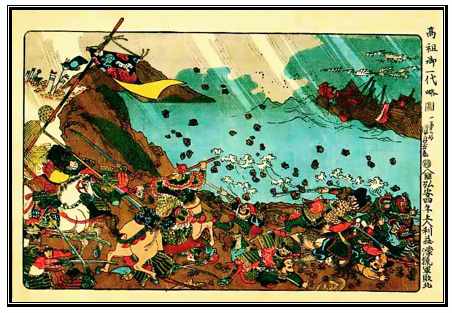 |
|
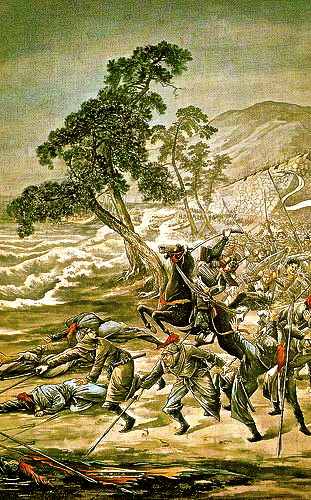 |

Warfare, customary within feudal Japan involved man-to-man duels of
sorts, even on large open battlefields. The Samurai ritual of fighting
involved calling out a challenge to someone among the enemy. Then,
basically, a single combat duel ensued between the two. The Mongols
fought an altogether different type of war. They charged forward
together with military discipline, killing everything they could reach.
If a Samurai horseman came out alone from their position and yelled out
in a foreign tongue, shot a whistling arrow toward the sky, then charged
towards the Mongols, he fell under a veritable hail of Mongol arrows.
Not an unusual tactic for the Mongols, but not part of the mind set of
feudal Japan.
The Mongol method of murderous tactical advances and insidious ambush
withdrawals, accompanied by their ringing bells, beating drums and
Mongolian Steppes war cries, was not before experienced in Japan. Also
unfamiliar was the technique of the Mongol archers, which involved
shooting a storm of arrows into the air. As opposed to the Samurai's
long-ranged, one-on-one combat, deadly archery competitions. The
difference in fighting methods between the military forces confused the
Samurai. The Samurai of the Kamakura period were used to fairly rigid
conventions governing the actions and behavior of warriors, but now they
faced a highly disciplined and utterly ruthless foe, that controlled
tactical manoeuvres and fought en-masse! |
| The Mongols brought an advanced technology weapon that terrified the
Samurai. It was an early form of "shock and awe". In addition to their
clouds of arrows fired continuously, the Mongols also brought explosive
Chinese bombs. These bombs were flung from
Trebuchets (photo right). An account from Hachiman Gudokun
reads, "The commanding general kept his position on high ground, and
directed the various detachments as need be with signals from hand
drums. But whenever the Mongol soldiers took flight they sent iron bomb
shells flying against us which made our side dizzy and confused. Our
soldiers were frightened out of their wits by the thundering explosions,
their eyes blinded, their ears deafened, so that they could hardly
distinguish east from west." These "mighty iron balls" were flung and
"rolled down the hills like cartwheels", they sounded like "thunder" and
when they exploded "looked like bolts of lightning". The Mongol shock
tactics definitely worked in the opening engagement between the two
armies. |
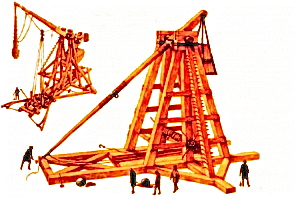 |
An example (picture right) of Tetsuhau, the world's oldest anti-personnel explosive,
excavated from a ship wrecked during the battle.
Tetsuhau is a primitive
Mongol grenade. Ceramic bombs found on the 1281 shipwreck, prove
the existence of these early explosive shells. Some historians had
speculated that their depiction on scrolls recording the invasions was a
later addition.
Besides catapult-launched explosive shells, the Japanese defenders also
had to face poison-tipped arrows and shorter bows accurate at twice the
range of the samurai's longbows - all this precisely orchestrated as
drumbeats relayed the Mongol orders to attack. |
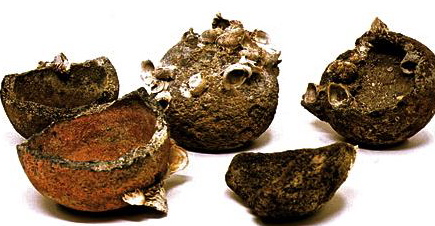 |
| Around nightfall, a terrible storm caused the Mongol ship captains to
suggest that the land force re-embark on the sailing vessels in order to
avoid the risk of being marooned. By daybreak, only a few ships had not
set out to sea and therefore survived. That
night, a fierce, powerful Typhoon raged and severely damaged the Yuan Fleet. Some Mongol
soldiers who were left on the Japanese coast were either captured or
killed. The first Mongol invasion on the Japanese mainland had lasted
one day and resulted in the loss of 13,000 soldiers, and 200 ships. But Kublai Khan never saw the
first invasion as a disaster. He was, however, already preoccupied with the final
conquest of Sung China, so Japan was not then his priority. |
|
Mongol Invasion of Japan - circa
1281 AD |
| In 1279 the Mongols completed their conquest of China, crushing the
military might of the southern Sung Dynasty in it's last bastion in
Canton.
The island of 'Nippon' (Japan) was once again in Kublai Khan's
sights. Seeing his dream of empire coming true, Kublai Khan sent a final
contingent of envoys, in 1279, to Nippon, which were permitted to land
and were taken before the Kamakura Emperor. They were eventually
beheaded and their severed heads sent back to the Khakhan. The second
invasion was staged on a far grander scale than the first, for the
Khakhan Kublai absolutely expected there would be another divine
typhoon, and prepared for that eventuality with a much larger assault,
broken into two fleets. Over 900 ships were ordered from Korea alone,
with another order of war ships being constructed in the southern China
shipyards. The Mongol forces were divided into the Yuan (launched from
southern China), and Korean (launched from Koryo), fleet armies. The
fleets would converge before attacking. The mammoth size of the Yuan
Southern Fleet, composed of combined Chinese Yuan military and Mongols,
made the second Mongol invasion of Japan one of the largest naval
assault operations in the history of warfare! It was second only to the
Normandy Invasion of Europe during World War II. |
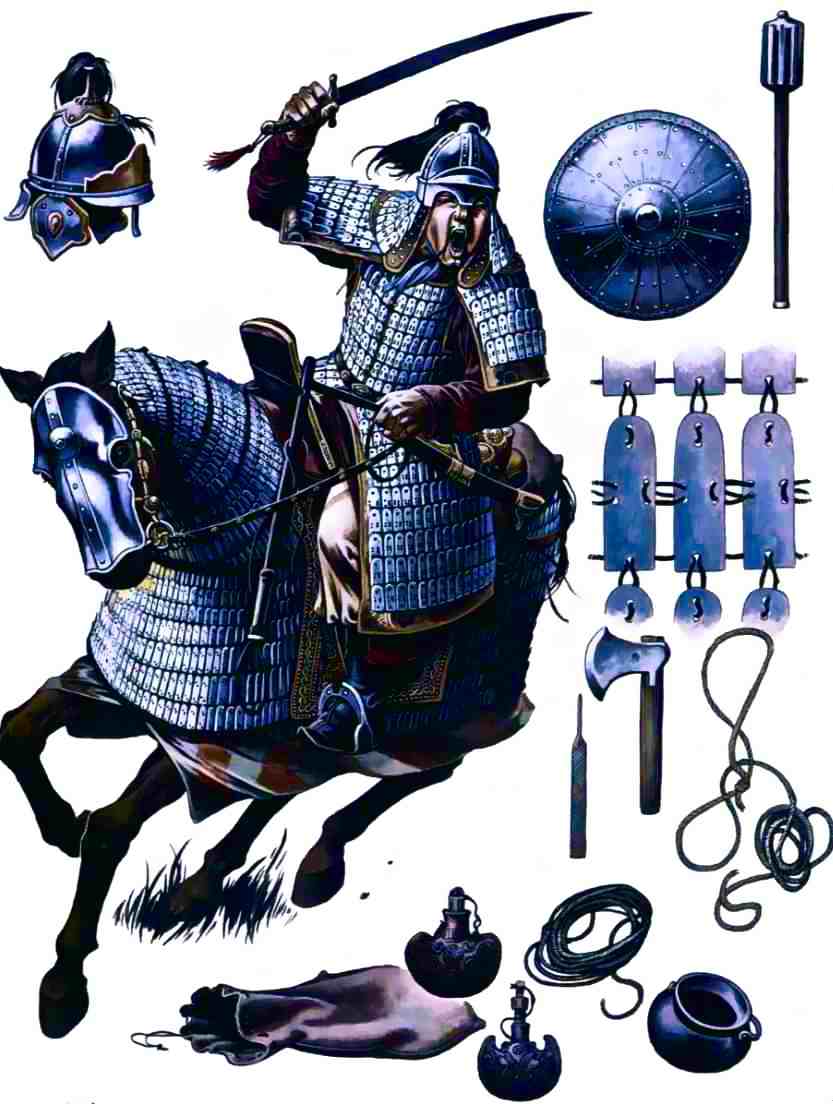
Yuan Heavy Cavalry |
In 1281, Kublai Khan formed his two mighty fleet armies, and this
time the Mongols took their horses with them too. Setting out from
Mason, Korea, was the Eastern Fleet Army aboard 900 ships, made up of
30,000 elite troops led by a Mongol general, and augmented by a Korean
army of 10,000. Also, the Southern Fleet Army aboard 3,500 ships,
sailing from the South of China, composed of 100,000 former Sung Chinese
soldiers pressed into Kublai Khan's service, and led by a Chinese
general.
The invasion strategy envisioned the fleets joining forces in the
spring, before the dreaded summer typhoon season. The Mongols' plan
called for an overwhelming coordinated attack from the combined imperial
Yuan fleets. But the South China fleet arrived late due to logistical
problems involving provisioning and manning the large armada of ships,
which delayed implementation of the full invasion. The Eastern Fleet
contingent arrived early and suffering heavy losses at Tsushima, backed
off to await the Southern fleet. The huge Southern armada (four times
more powerful than the Eastern fleet) began arriving in various parts
around the Japanese coast in early August, 1281.
The two naval fleet armies finally met up at Takashima island. There
the Japanese launched a bold raid on the Mongol fleets which lasted all
the day and night without stop! Eventually the Japanese were driven off
by the sheer weight of the Mongol armies. A massive Mongol assault on
Hakata Bay was inevitable.
Wave after wave of Mongol warriors, unfolding their second invasion
of Japan, swept continuously ashore at
Hakata Bay on the tip of the
island of Kyushu. Since their first invasion there in 1274 the Japanese
had built a high wall. When Kublai Khan's advance assault forces landed
again at the same exact location, outside that defensive wall, at the
water's very edge, the Mongols met fierce resistance from Japan's
Samurai Warriors, who were now better prepared and knew what to expect
from the Mongols. |
| The Mongols hurled stones at any Japanese vessels that approached
their ships, using
catapults. The Mongols attacked on land with poisoned
arrows, maces, lassoes, and javelins that could be hurled great
distances, while the Japanese fought back with bows and arrows, spears,
swords, and wooden shields. But they also fought with the fury of men
protecting their home from ruthless invaders. The Japanese had learned
their lesson in 1274 and changed their tactics, meeting the Mongol
enemy's mass attack with a mass defense of their own.
The Japanese defenders showed great courage and fighting skill. They
would retaliate upon each attack with stealthy night raids. The Japanese
ships were smaller, more maneuverable vessels, and would close on the
Mongol ships in the black of night.. The ship's mast could be lowered to
act as a bridge and the Samurai would climb aboard the Mongol ship
silently. The Samurai were trained in close-quarter melee fighting. On
one occasion 30 Samurai swam out to a Mongol vessel, decapitated the
entire crew and swam back. Kusano Jiro led an attack in broad daylight
and set a ship on fire even though he had his left arm cut off in the
process.
On August 15 and 16, 1281, the now-famous
Kamikaze, a massive
typhoon, assaulted the shores for two days straight, and destroyed much
of the Mongol fleet, scattering the remainder. Possibly 4,000 vessels
were sunk. Mongol and Chinese casualties were between 60 - 90 %. These
cyclonic winds, which likely saved Japan from a crushing defeat, came to
be called Kamikaze (Divine Wind), and this victory supported the belief
that lasted until the end of the Pacific War (World War II) that Japan
was protected by the gods and could not be subjugated by a foreign
power. |
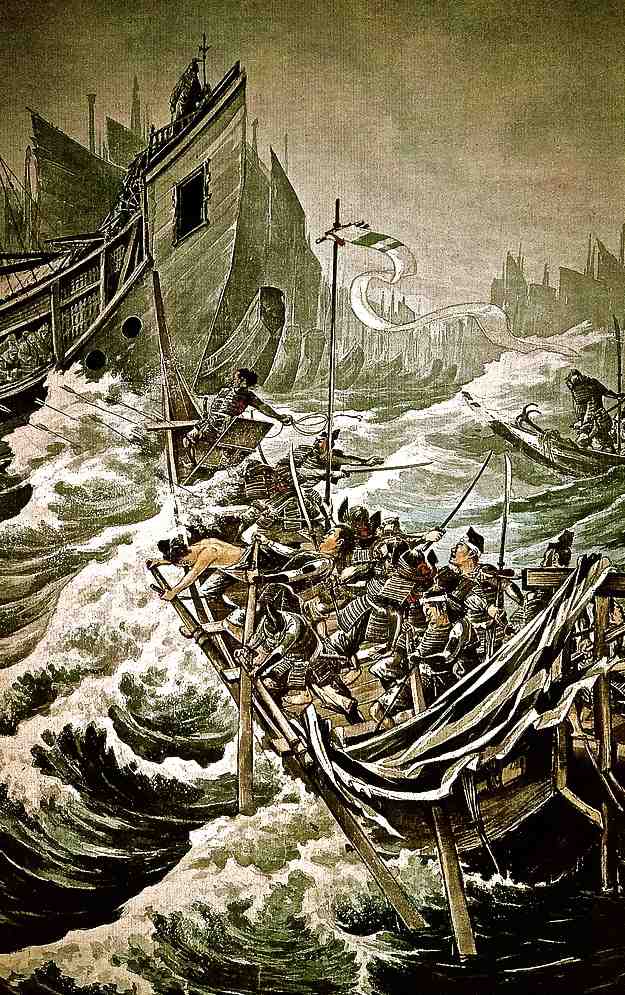 |
|
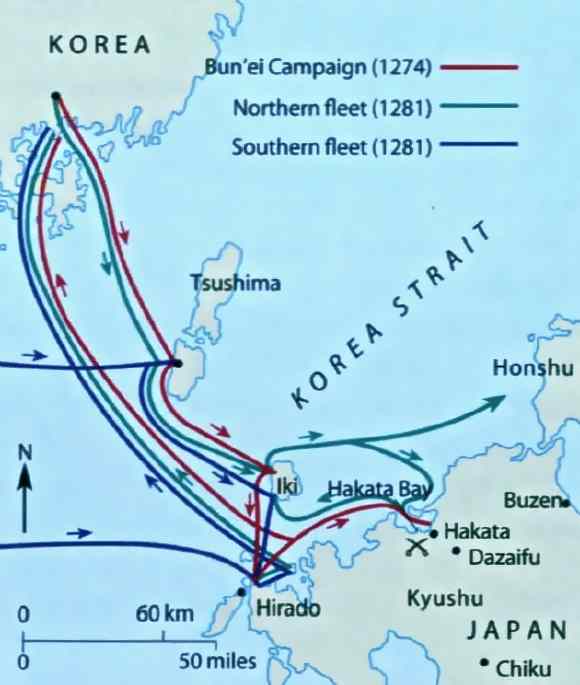 |
The surviving Mongol generals and army, fearing severe punishment by
Kublai Kahn, went into hiding in Koryo (Korea). Tens of thousands of men
were left behind with the wreckage as the remains of the fleet sailed
home. These marooned troops were hunted down by the samurai and killed.
Many of the Sung Chinese conscripts were not executed, but were instead
kept as slaves by the Japanese.
It has been postulated that the destruction of the Mongol Yuan fleet was
greatly facilitated by two additional factors. Most of the southern
invasion force was composed of hastily-acquired flat-bottomed Chinese
riverboats. Unlike ocean-going ships, which have a curved keel to
prevent capsizing, these river boats had flat bottoms. Such ships cannot
deal with the high seas let alone a massive typhoon. In addition, the
true ocean-going ships in Kublai Khan's fleet which had been constructed
by the Koryo (Koreans), may have been deliberately sabotaged. Fatal
flaws such as poorly constructed joints and weak nails have been found
in many of these ships.
For the first time in their history the Samurai had put aside their
differences and united to drive away a common enemy. After the coastal
defenses were put off alert in 1312 the Samurai went back to their
time-honored tradition of fighting each other, and it was not until
several centuries later that the notion of a unified Japan was raised
again.Kublai Khan, undaunted, sought yet a third invasion fleet to
subdue 'Nippon', and asked Koryo (Korea) to
build more ships in preparation. Once again, the Khan fully expected
another divine typhoon and would certainly have launched an even greater
mighty armada, but a major rebellion at home delayed him and the plan
was forgotten when Kublai Khan died. |
| The Mongols were the greatest cavalry the world has ever seen, which
was the source of their legacy as world conquerors. But their inability
to fight sea battles and the poor quality of their naval construction,
reflect a nomadic steppes horse-people who had wandered far out of their
element. It would not be long before the "Golden Age" of the Mongol
Empire disintegrated much more rapidly than the Great Khan Genghis
himself could ever have dreamed possible. Their Mongolian heritage had
become a dim memory, and they were being absorbed into the religions and
cultures of the peoples they had conquered. |
|
Yuan Dynasty - Administration,
Public Works and Religious Tolerance |
| Kublai Khan completed some great works during his lifetime. He
extended the Grand Canal all the way to his new capital in Ta-tu, what
is now modern day Beijing. He repaired public granaries, extended
highways, made paper currency, started aid agencies, postal stations and
allowed religious freedom. Although Nestorians had been largely expelled
from China in the 9th century, their return was encouraged by Kublai who
enjoyed hearing debates among various religions. He gained loyalty from
many of his Chinese subjects, because of the freedom he allowed, and the
improvements he made.
Kublai Khan assigned endless projects, not all set on such a
magnificent scale. For instance, he commissioned a group of Han-lin
scholars to write the history of the Yuan Dynasty. And it seemed fitting
to order an astronomer, Jamal ad-Din, to make a new calendar to
inaugurate his reign. And, to increase the skill of his scientists,
Kublai Khan ordered the casting of new bronze instruments for the
astrologers' tower, including a globe of the sky, an armilary sphere. This task
kept his chosen scientists occupied for years, for Kublai Khan was ever
hungry of omens that had a mathematical basis. It was a great
convenience to know the fortunate moons and lucky days, and also the
hours when the Star of evil omen was ascendant. Additionally, he put
scholars to work requesting them in their wisdom to devise a universal
alphabet, in which the spoken Mongolian could be combined with the
written Chinese and Tibetan, to relieve the plague of tongues and
scripts at the Mongol court.
In his system of government the Kublai Khan shrewdly devised to
extend to all classes of his subjects. He gave no race a controlling
hand. The Mongols held the commanding positions in the army, and over
the judges, provincial commands and heads of departments. The more
subtle Moslems were appointed to secondary authority, and served also as
financial agents. The Chinese controlled the schools and were the heads
of businesses. So, in rough outline, Kublai kept the police power in
the hands of the Mongols, the treasury under the aegis of the
foreigners, and the education under the Chinese. |
|
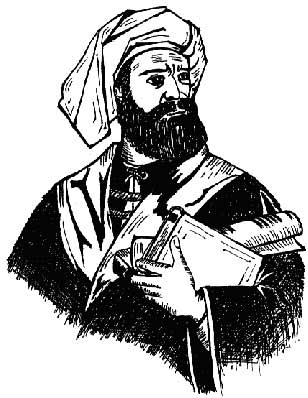
Marco Polo |
Under Kublai Khan, the first direct contact and
cultural exchange between China and the West had occurred. There were
several exchanges of missions between
the Pope and the Great Khan. In 1266 Kublai entrusted the Polo brothers,
two Venetian merchants, to carry a request to the pope for one hundred
Christian scholars and technicians. The Polos met with Pope Gregory X
(1210–1276) in 1269 and received his blessing but no scholars.
Kublai Khan established his summer capitol in Shangdu, which was
referred to as
Xanadu. In 1275,
Marco Polo, a Venetian explorer, visited Xanadu and a relationship of trust was formed between the two. Polo’s
reports on Xanadu and China were new to Western Europeans and sparked
further interest in eastern world exploration. This was the inspiration
later for the classic poem
“Kubla Khan”, written in 1816, by Samuel
Taylor Coleridge. Marco Polo (1254–1324), who accompanied his father on
this trip, was probably the best-known foreign visitor ever to set foot
in China. It is said that he spent the next seventeen years under Kublai
Khan, including official service in the administration.
Kublai Khan shocked the ritual minded
Marco Polo
by the freedom of his
reasoning. "There are four prophets," he declared, "to whom people pray
and give reverence to on earth: Jesus Christ, Muhammad, Moses, and Sakya-muni. I bow to all of them, and also before Him who of all is the
most great in the Sky." Kublai Khan gave Marco Polo a
demonstration of the miracle working of the Tibetan Lamas, who moved a
goblet of wine through the air and into Kublai's hand. "They can conjure
up storms," the Khakhan added, "and direct them where they please. They
can speak to their Pagan Gods." |
|
Last Days of Kublai Khan and the
Mongol Legacy
Upon the death of both his favorite wife, Chabui, and his beloved son
and successor, Chin-chin, Kublai Khan fell into a deep depression. In
his grief he resorted to food and alcohol for surcease of sorrow. And
so, in deep mourning, Kublai Khan became an obese drunkard and died at
the age of 79, in the first moon of 1294, in the eightieth year of his
age, and the thirty-fifth year of his reign. To Marco Polo and the
westerners Kublai Khan had been a glorious monarch, knowing and
courageous, and a friend to men of letters. The Chinese say of him that
he was influenced by excessive superstition, by love of women and
silver, by his ridiculous attachment to the lamas of Tibet. His failing
was to have sacrificed such multitudes in the wars. In fulfilling his
personal ambition to become the master of the Chinese, he alienated
himself from the old clan life and from the Mongol ties. At his death he
was alone. He may not have realized, or he may not have cared, that in
uniting China he had brought the empire of the steppe dwellers to it's
end.
Following Kublai Khan's death, Secret Buddhist Societies, like the White
Lotus and Red Turbans, emerged and plotted insurrection, which was met
with oppression at the hands of Kublai’s inept successors, but this only
led to more sustained resistance. Finally a full-scale uprising under
the monk turned rebel leader, Zhu Yuanzhang, usurped the throne from the
child emperor in 1368 and instilled the Ming Dynasty. |
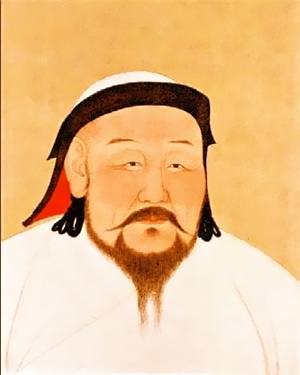 |
|
Genghis Khan, the Kha Khan, Emperor of Kings, called the Destroyer,
had broken down the barriers of the Dark Ages. He had opened up roads.
Europe came into contact with the arts of Cathay. At the court of his
son, Armenian royalty and Persian grandees rubbed shoulders with Russian
princes. A general reshuffling of ideas followed the opening of the
roads. An abiding curiosity about far Asia stirred Europeans. Marco Polo
followed Fra Rubruquis to Kambalu. Two centuries later Vasco da Gama set forth to find his way by sea to the Indies. Columbus sailed to reach
not America, but the land of the Great Khan! |
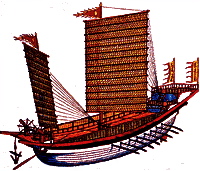 |
 |
|
 |
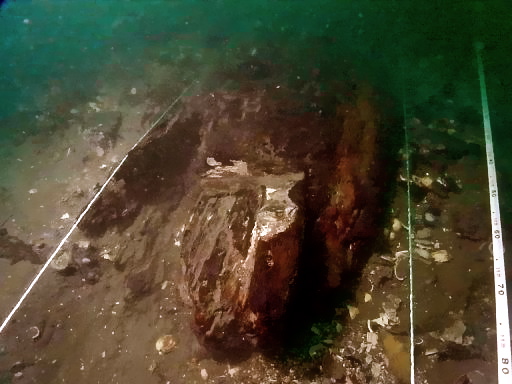 |
|
Mongolian 'Kamikaze' Victim Found Off Japan Coast
The 13th century wreck of an invading Mongolian ship
that fell victim to a famous typhoon known in Japan as the "Kamikaze" or
"Divine Wind" has been found off the country's southern coast. A
long section of the keel of a wooden vessel, thought to have been one of
more than 4,000 sent by Kublai Khan to conquer Japan, was discovered
beneath the sea bed near Nagasaki, the Mainichi Shimbun and other media
reported.
The huge invading fleet of 1281 is believed to have been sunk by a
powerful typhoon that became known in Japan as the "Kamikaze" -- a
"Divine Wind" that protected a chosen nation.
The wreck, which is buried in a meter (three feet) of mud, was found by
a team led by Yoshifumi Ikeda, professor of archaeology at the
University of the Ryukyus in Okinawa. The team found a 12-metre section
of the keel with several long pieces of wood attached. Experts estimate
the vessel was at least 20 meters long before it sank off the island of
Takashima in northern Nagasaki prefecture. Ikeda said a number of pieces
of Chinese pottery dating from the 12th and 13th centuries were also
found at the site, helping to pinpoint the age of the boat.
The Mongolian-ruled Yuan dynasty of China, led initially by Genghis
Khan's grandson, Kublai, tried to conquer the samurai warriors of Japan
on two occasions, in 1274 and 1281. About 900 ships were sent in the
first attempt. Battles were fought in Kyushu, Japan's main southern
island, but the invasion attempt failed. The much bigger, second fleet
of 4,400 ships was largely sunk by the huge typhoon that the Japanese
attributed to divine intervention, giving currency to the notion of
"Kamikaze", a word now largely associated with the suicide pilots of
World War II.
Around 4,000 artifacts from the wreck, including the anchor, were
previously known about, but researchers hope the discovery of such a
large and well-preserved section of the boat will help them to
understand more about the invading fleet. "This discovery was of major
importance for our research. We are planning to expand search efforts
and find further information that can help us restore the whole ship,"
Ikeda said |
|
 |
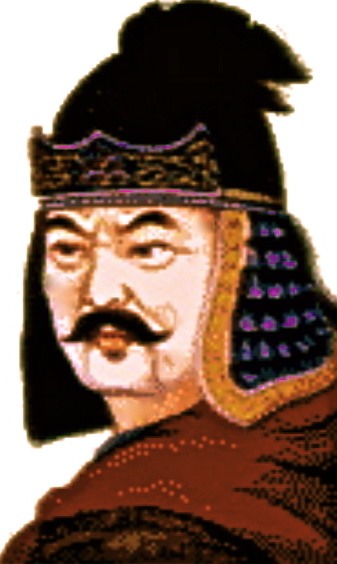 |
|
Researchers studying the rings of ancient trees in
mountainous central Mongolia think they may have gotten at the mystery
of how small bands of nomadic Mongol horsemen united to conquer much of
the world within a span of decades, 800 years ago. The rise of the great
leader Genghis Khan and the start of the largest contiguous empire in
human history was propelled by a temporary run of nice weather. |
|
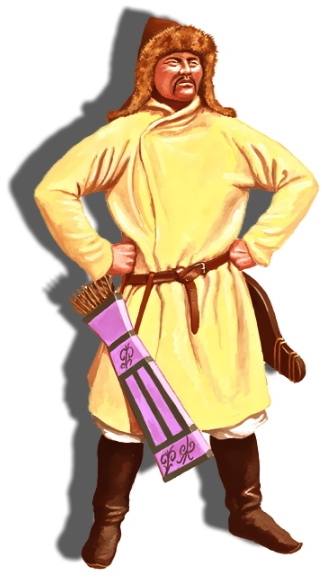 |
The rings show that exactly when the empire rose, the normally cold,
arid steppes of central Asia saw their mildest, wettest weather in more
than 1,000 years. Grass production must have boomed, as did vast numbers
of war horses and other livestock that gave the Mongols their power. But
the tree rings, spanning 1,112 years from 900 to 2011, also exhibit an
ominous modern trend. Since the mid-20th century, the region has warmed
rapidly, and the rings show that recent drought years were the most
extreme in the record -- possibly a side effect of global warming. In a
region already pressed for water, the droughts have already helped spark
a new migration in a vast region where people until now have lived the
same way for centuries, moving herds from place to place and living in
tents. Now, those herders are being driven rapidly into cities, and
there could be greater future upheavals. The study appears in this
week's early online edition of the Proceedings of the National Academy
of Sciences.
"Before fossil fuels, grass and ingenuity were the fuels for the Mongols
and the cultures around them," said lead author Neil Pederson, a
tree-ring scientist at Columbia University's Lamont-Doherty Earth
Observatory. "Energy flows from the bottom of an ecosystem, up the
ladder to human society. Even today, many people in Mongolia live just
like their ancestors did. But in the future, they may face serious
conditions."
In the late 1100s, the Mongol tribes were racked by disarray and
internal warfare, but this ended with the sudden ascendance of Genghis
(also known as Chinggis) Khan in the early 1200s. In just a matter of
years, he united the tribes into an efficient horse-borne military state
that rapidly invaded its neighbors and expanded outward in all
directions. Genghis Khan died in 1227, but his sons and grandsons
continued conquering and soon ruled most of what became modern Korea,
China, Russia, eastern Europe, southeast Asia, Persia, India and the
Mideast. The empire eventually fragmented, but the Mongols' vast
geographic reach and their ideas -- an international postal system,
organized agriculture research and meritocracy-based civil service among
other things--shaped national borders, languages, cultures and human
gene pools in ways that resound today. Genghis Khan's last ruling
descendants ran parts of central Asia into the 1920s. |
Some researchers have postulated that the Mongols expanded because
they were fleeing harsh weather at home--but Pederson and colleagues
found the opposite. In 2010, Pederson and coauthor Amy Hessl, a
tree-ring scientist at West Virginia University, were studying wildfires
in Mongolia when they came across a stand of gnarled, stunted Siberian
pines growing out of cracks in an old solid-rock lava flow in the
Khangai Mountains. They knew that on such dry, nearly soil-less
surfaces, trees grow very slowly, are exquisitely sensitive to yearly
weather shifts, and may live to fantastic ages.
In a series of expeditions, Pederson, Hessl and colleagues sampled the
pines' rings, sawing cross-sections from dead specimens, and removing
harmless straw-like cores from living ones. They found that some trees
had lived for more than 1,100 years, and likely could survive another
millennium; even dead trunks stayed largely intact for another 1,000
years before rotting. |
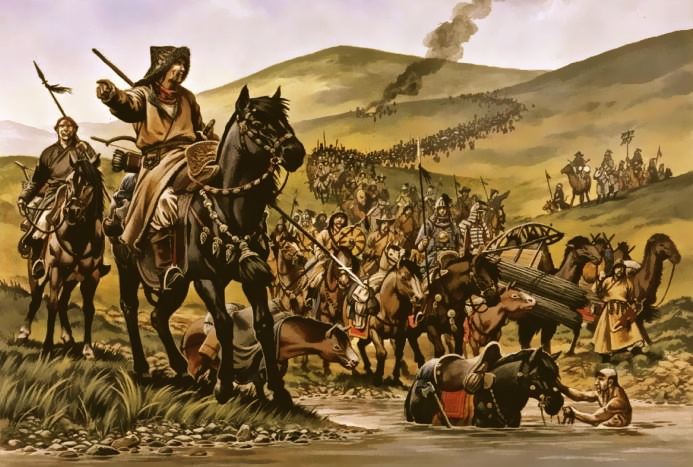 |
| One piece of wood they found had rings going back to about 650 B.C.
These yearly rings change with temperature and rainfall, so they could
read past weather by calibrating ring widths of living trees with
instrumental data from 1959-2009, then comparing these with the innards
of much older trees. The trees had a clear and startling story to tell.
The turbulent years preceding Genghis Khan's rule were stoked by intense
drought from 1180 to 1190. |
Then, from 1211 to 1225 -- exactly coinciding with the empire's
meteoric rise--Mongolia saw sustained rainfall and mild warmth never
seen before or since.
"The transition from extreme drought to extreme moisture right then
strongly suggests that climate played a role in human events," said
Hessl. "It wasn't the only thing, but it must have created the ideal
conditions for a charismatic leader to emerge out of the chaos, develop
an army and concentrate power. Where it's arid, unusual moisture creates
unusual plant productivity, and that translates into horsepower. Genghis
was literally able to ride that wave." (Each Mongol warrior had five or
more horses, and ever-moving herds of livestock provided nearly all food
and other resources. The rest probably depended on the Mongols'
brilliant cavalry skills, smart political maneuvering and savvy
adaptions of urbanized peoples' technologies.)
The tree rings show that after the empire's initial expansion,
Mongolia's weather turned back to its more normal dryness and cold,
though with many ups and downs over the hundreds of years since. The
20th and early 21st centuries are the exception. In the last 40 years,
temperatures in parts of the country have gone up by as much 4.5 degrees
F -- well over the global mean rise of 1 degree. And, since the 1990s,
the country has suffered a series of devastating summer droughts, often
followed by a dzud -- an unusually long, cold winter. |
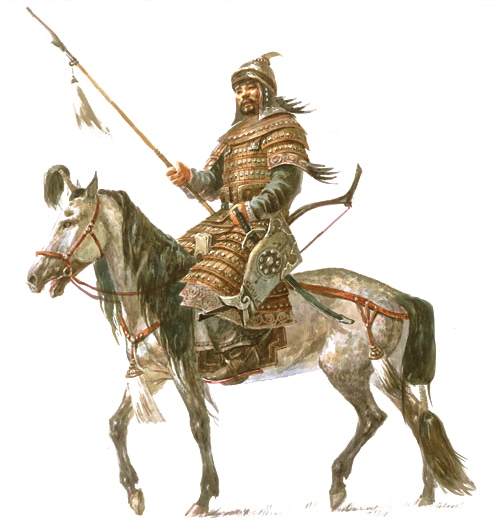 |
| The tree rings show that the most recent drought, from 2002-2009,
compares in length and paucity of rainfall only to those of the
pre-empire 1120s and 1180s. Perhaps more important: the drought of the
2000s was the hottest in the entire record. The heat evaporated water
stored in soil, lakes and vegetation, and, in combination with repeated
dzuds, devastated livestock. The last dzud alone, in 2009-10, killed at
least 8 million animals and destroyed the livelihoods of countless
herders. Now, displaced Mongol herders have formed a new invasion force
-- this time all headed to the capital city of Ulaanbaatar, which has
swollen to hold nearly half the country's population of 3 million. |
|
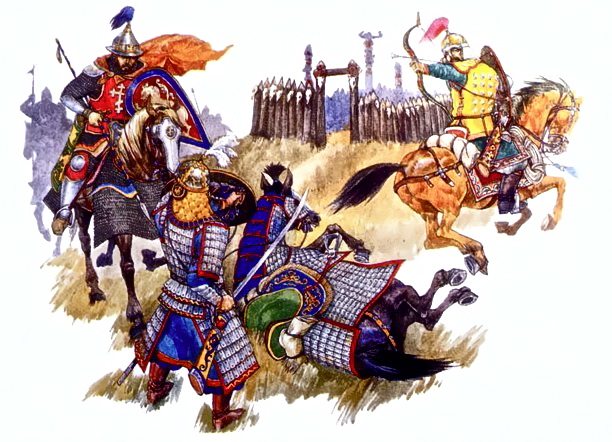 |
Climate models predict that as the world warms, heat in inner Asia
will continue to rise substantially faster than the global mean.
Pederson says this means that droughts and other extreme weather will
probably worsen and become more frequent. This could further reduce
livestock and hurt the few crops the region grows (only 1 percent of
Mongolia is arable land). New mining ventures and other industrial
activities may employ some of the many people fleeing the countryside --
but these also consume water, and it is not clear where that will come
from.
"This last big drought is an example of what may happen in the future,
not just in Mongolia but in a lot of inner Asia," said Pederson. "The
heat is a double whammy -- even if rainfall doesn't change, the
landscape is going to get drier."
Previous studies by others have advanced the idea that climate swings
can change history. These include events such as the disappearance of
the Maya, the expansion and fall of Roman imperial power, and, in a
separate Lamont-led study, the 13th-century collapse of southeast Asia's
Angkor civilization. Most focus on droughts, floods or other disasters
that arguably have cut off empires; the new study is one of the few to
explore the more complex question how climate might have invigorated
one. |
The researchers "make a compelling argument that climate played a
role in facilitating the Mongol migration," said David Stahle, a
paleoclimatologist at the University of Arkansas who has studied the
mysterious disappearance of the English Roanoke colony off North
Carolina, coinciding with what tree rings show was a disastrous drought.
"But," said Stahle, "we live in a sea of coincidence -- something like
that is hard to prove. There could be a lot of other factors. They've
provided an incredibly important climate record, and put the idea out
there, so it will stimulate a lot of historical and archeological
research."
In coming months, Avery Cook Shinneman, a biologist at the University of
Washington, plans to analyze sediments taken from the bottoms of
Mongolian lakes. These can be read somewhat like tree rings to estimate
the abundance of livestock over time, via layers of fungal spores that
live in the dung of animals; this would confirm whether animal
populations did indeed boom. The conquering Mongols left very few
written records of their own, but Nicola Di Cosmo, a historian at the
Institute for Advanced Study in New Jersey and coauthor of the current
paper, will study accounts of the time left in China, Persia and Europe
that might provide further clues. |
|
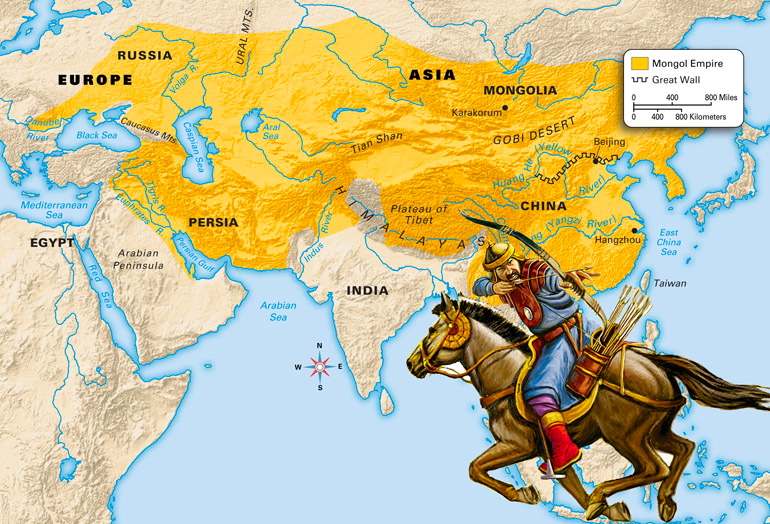 |
|